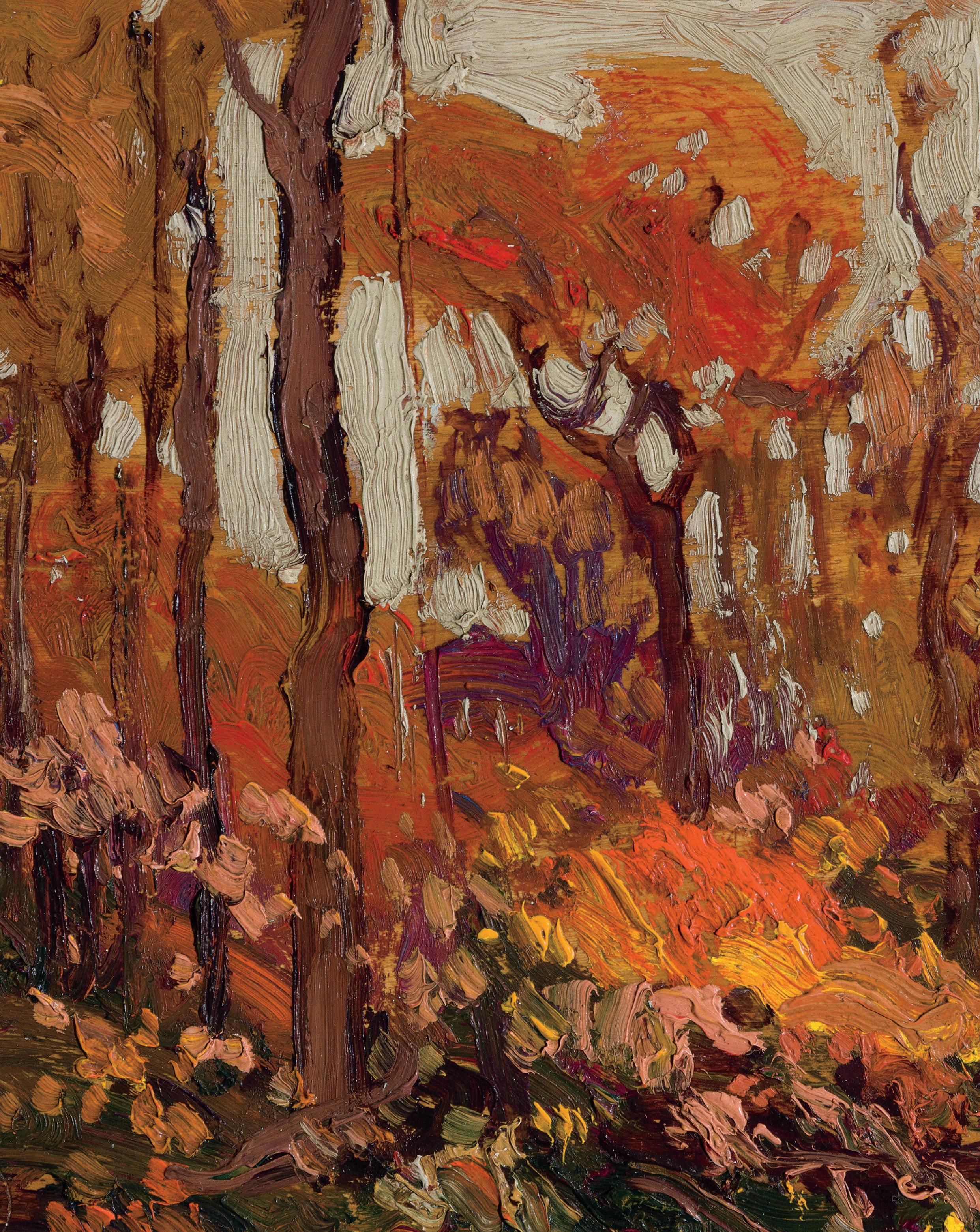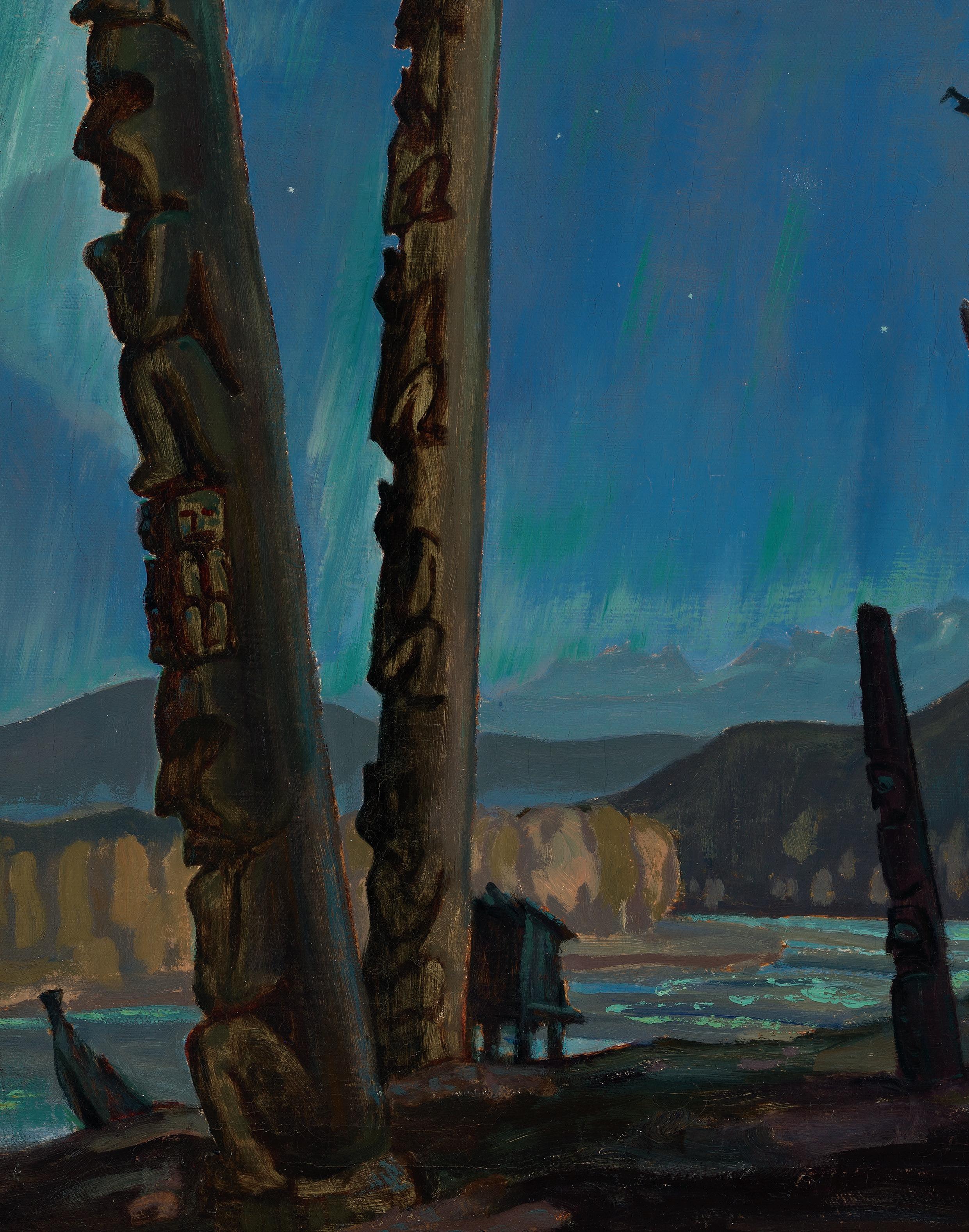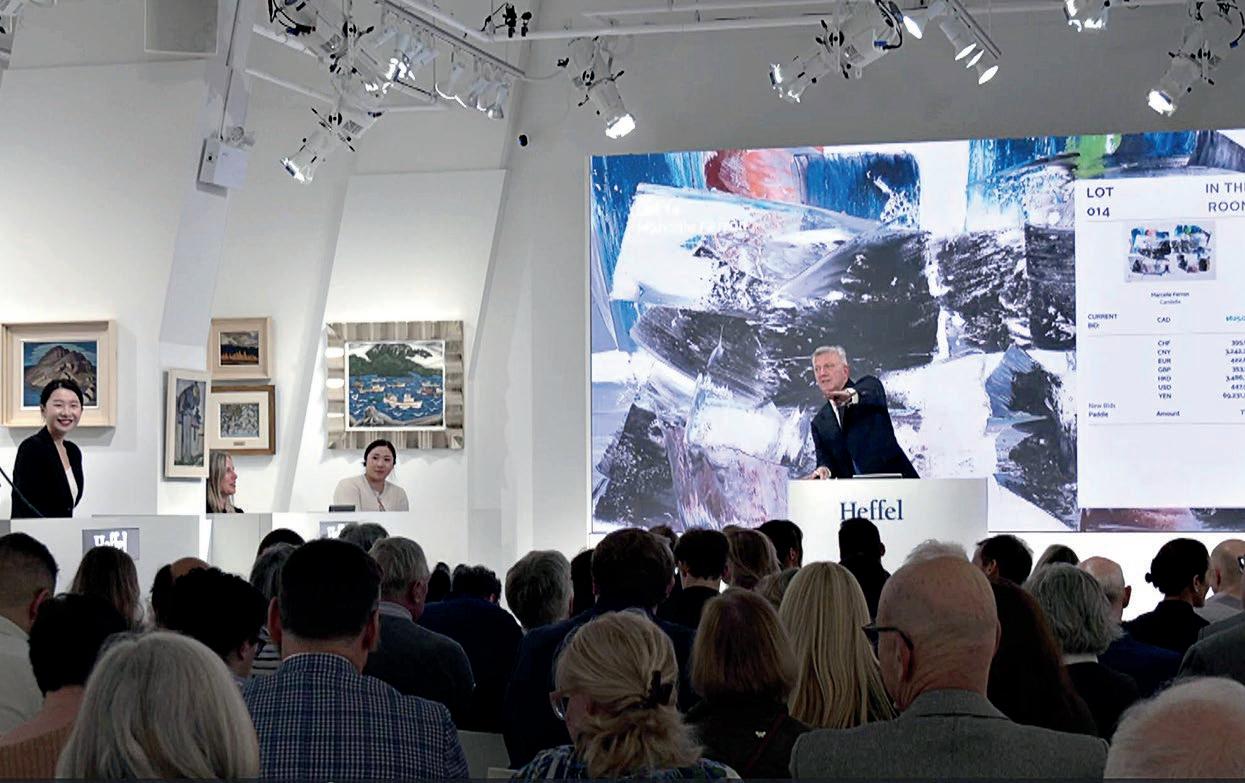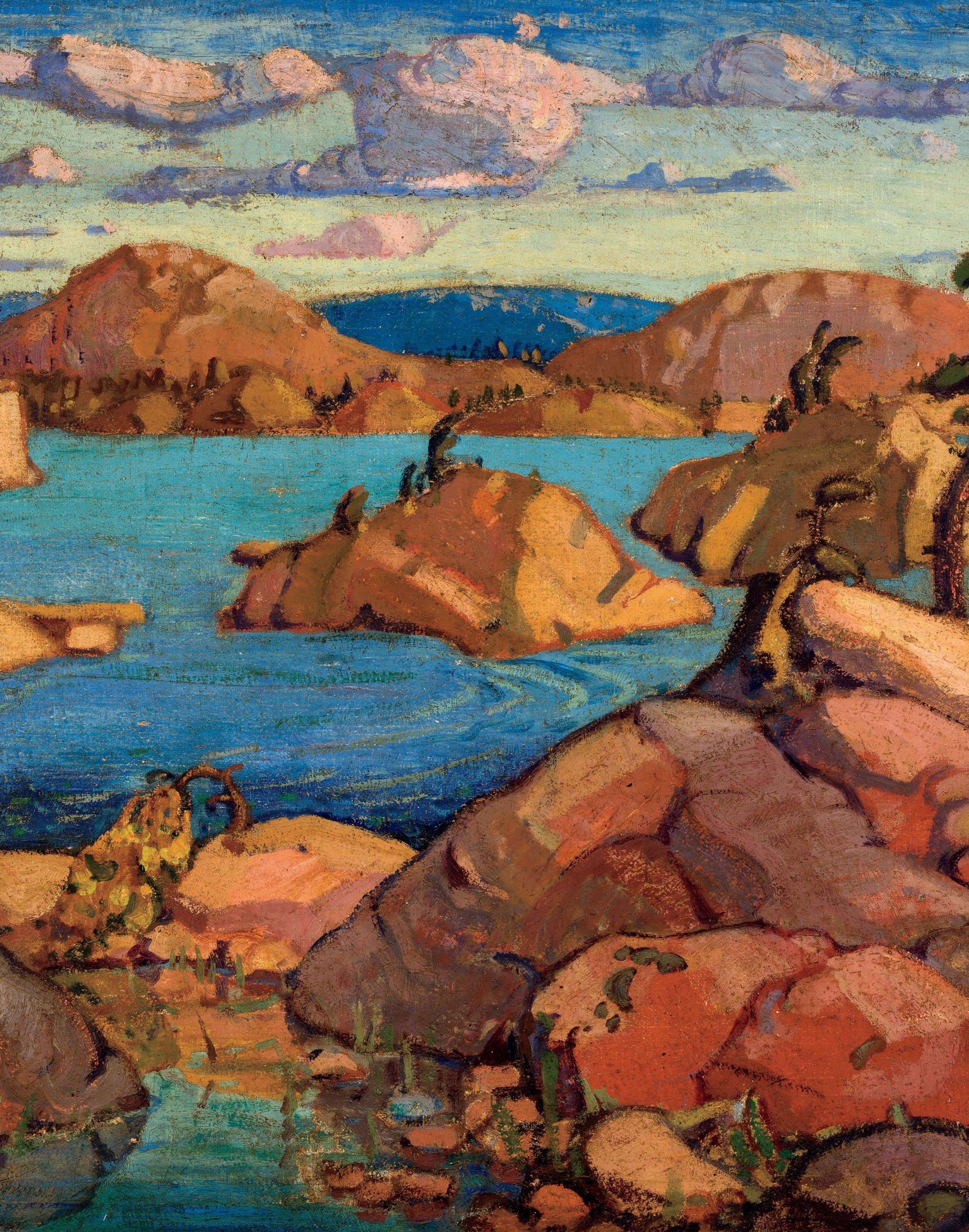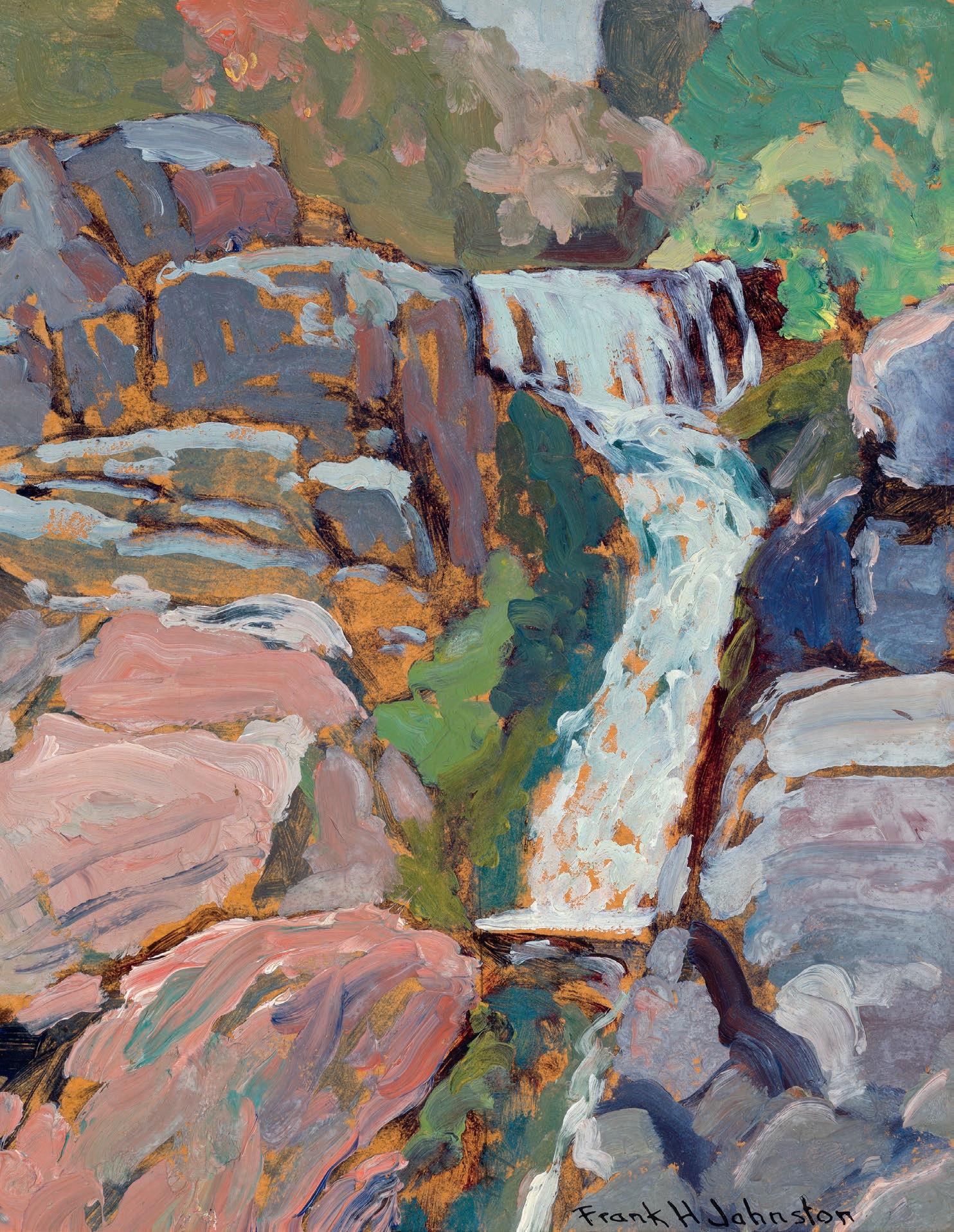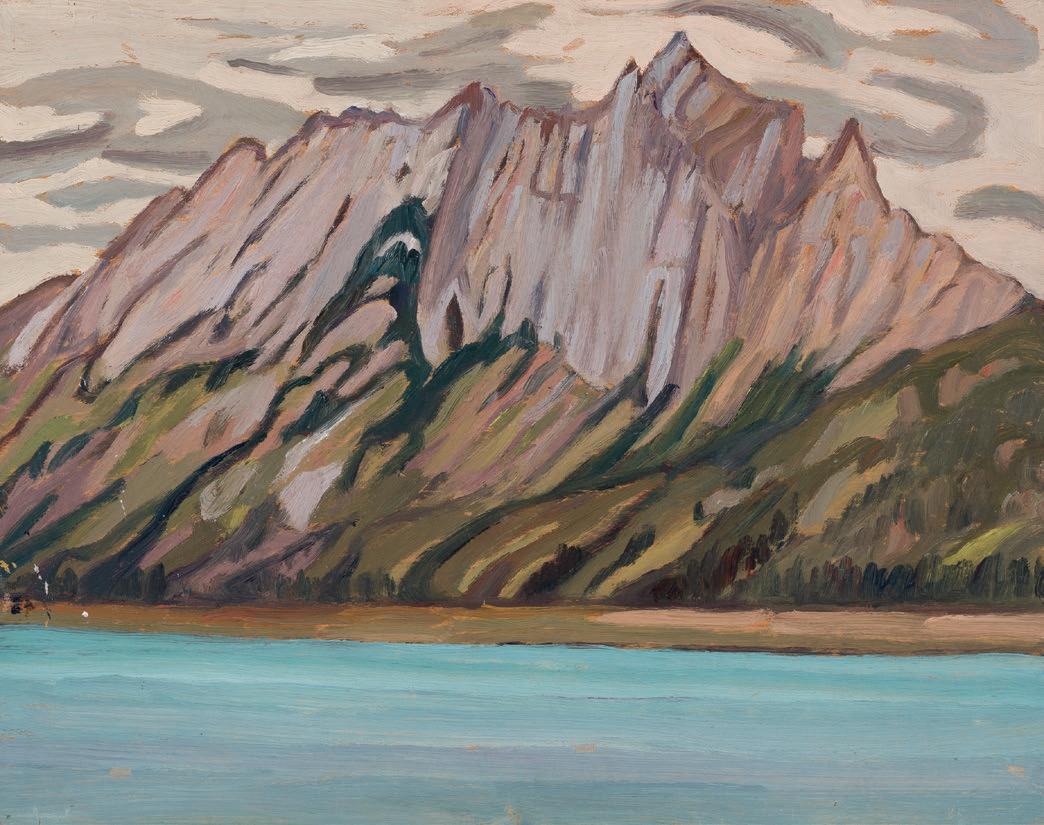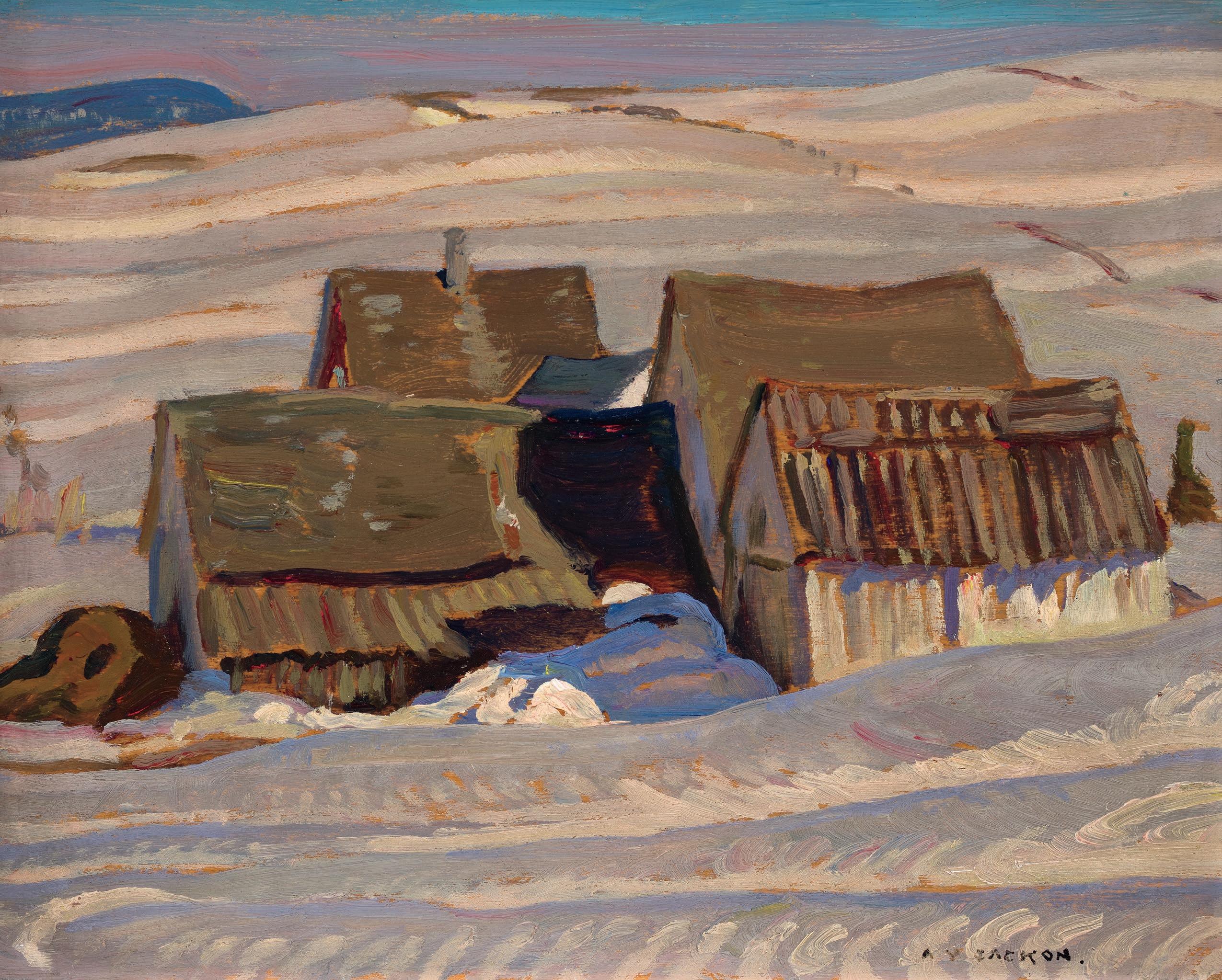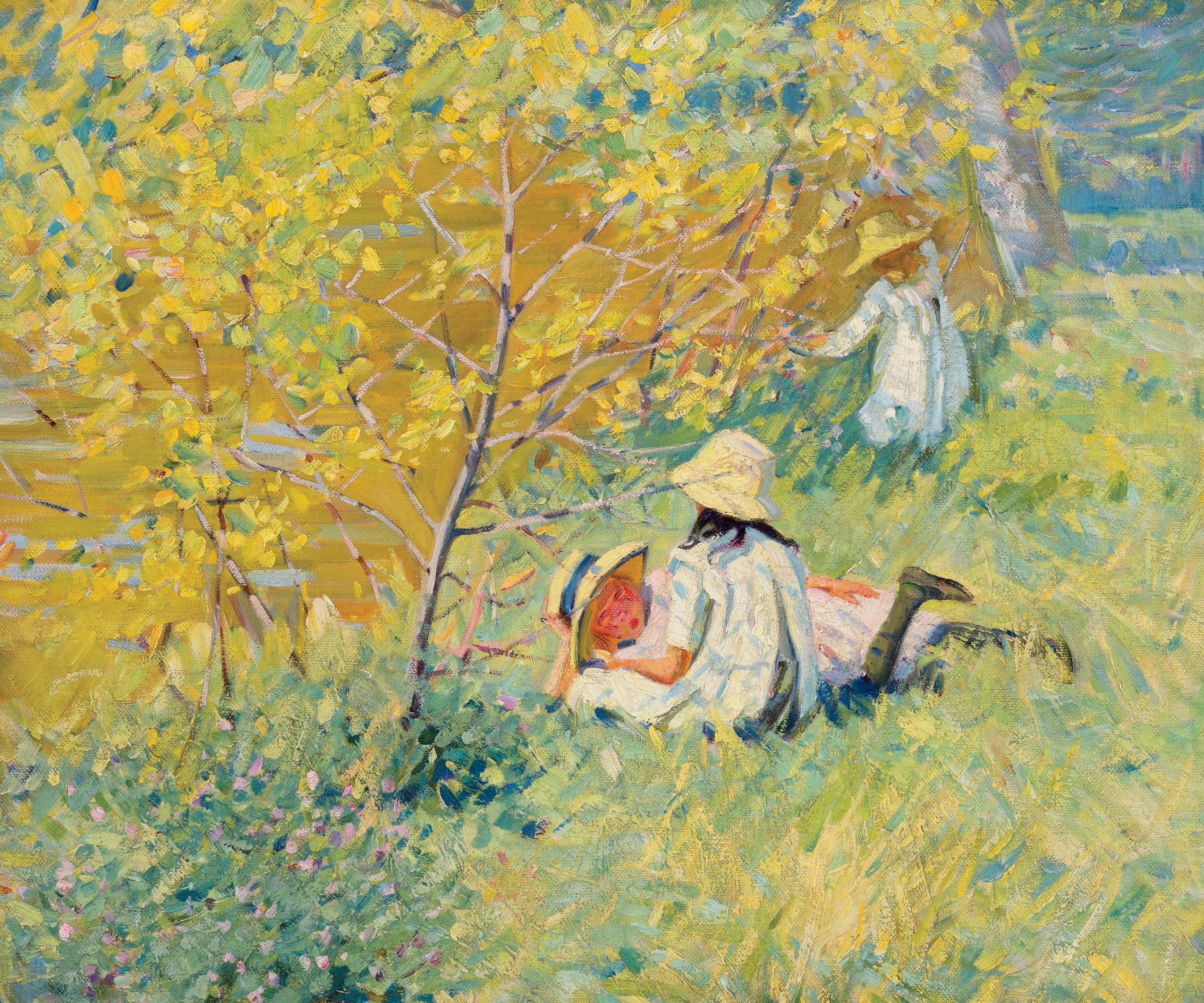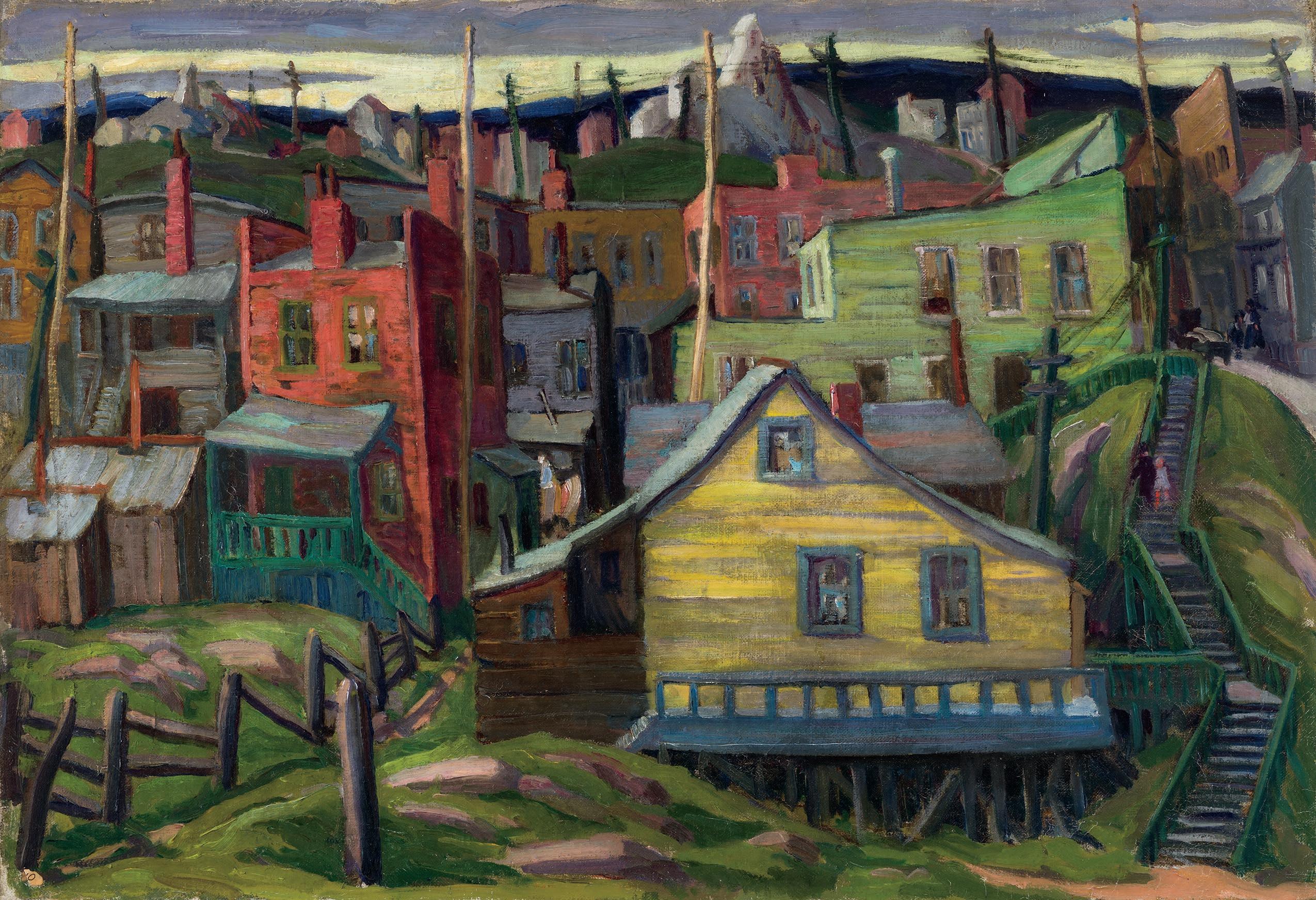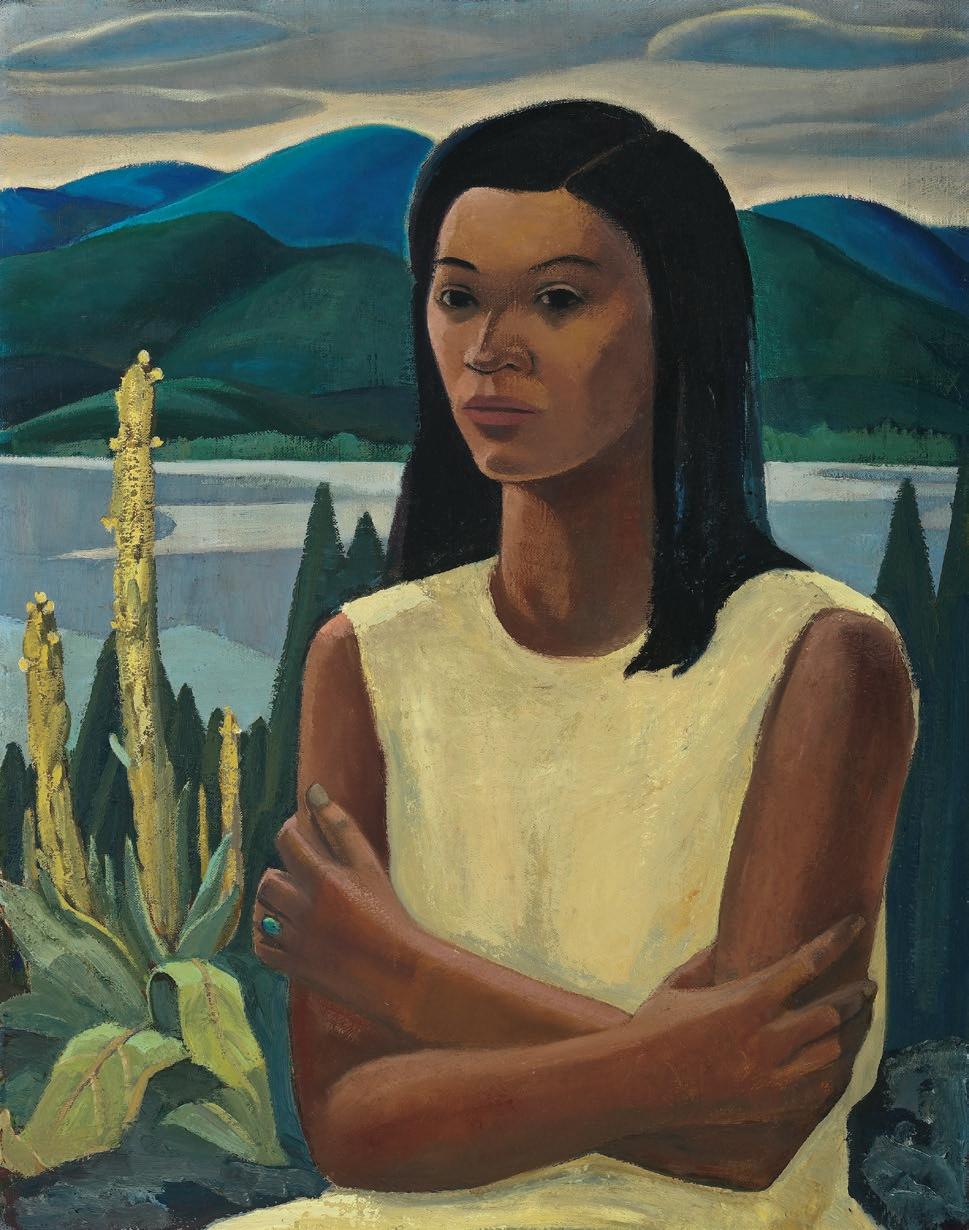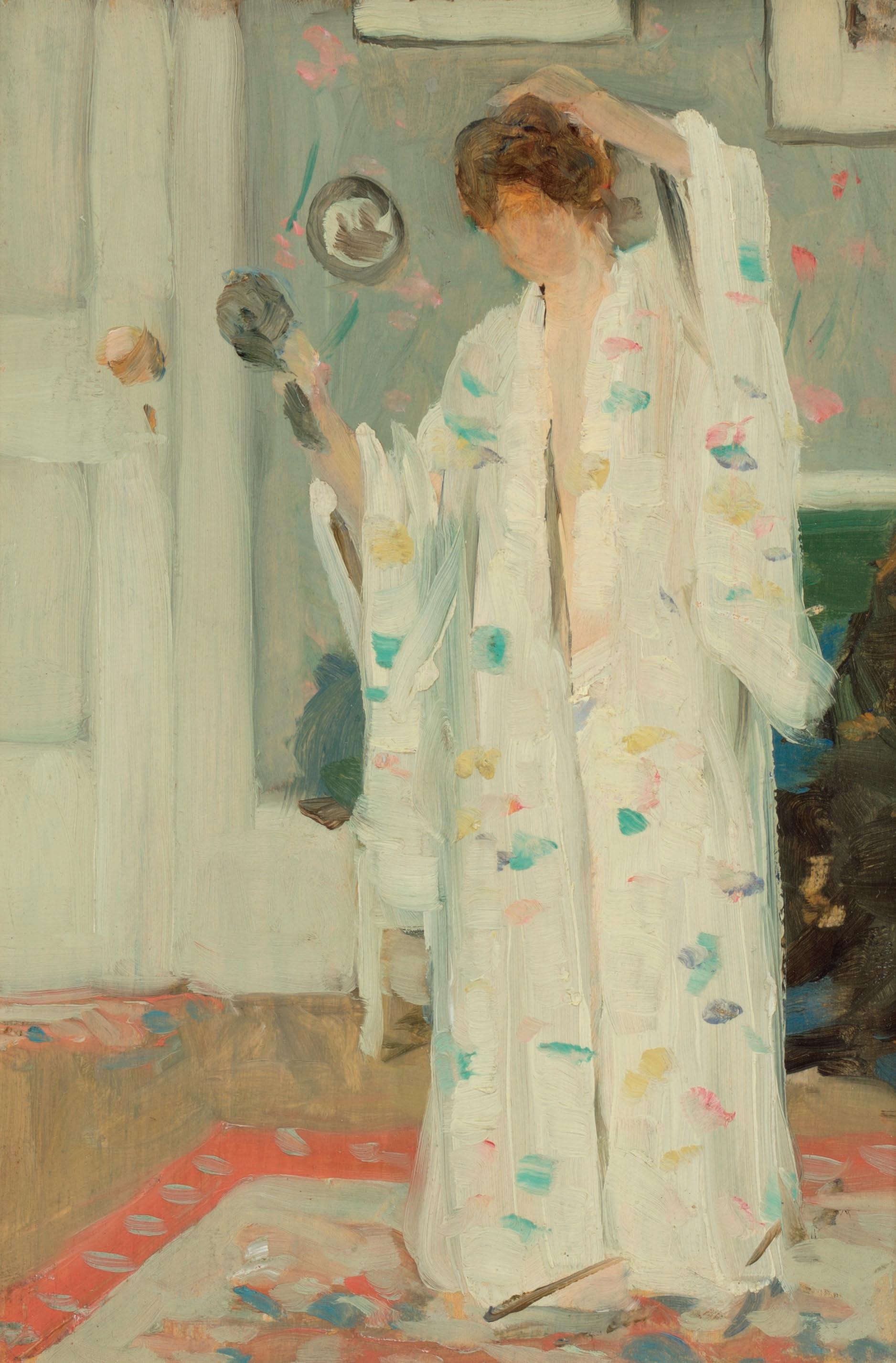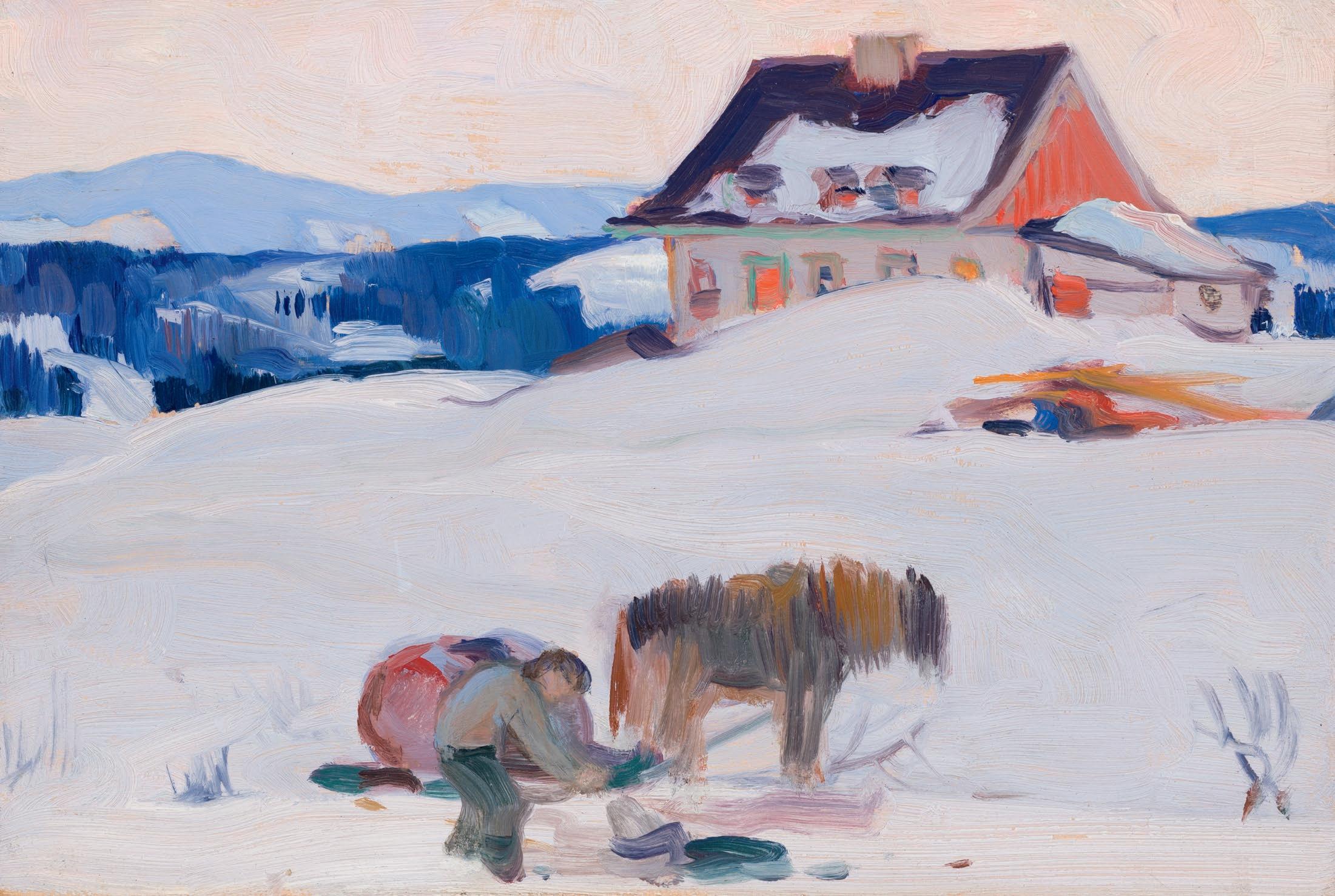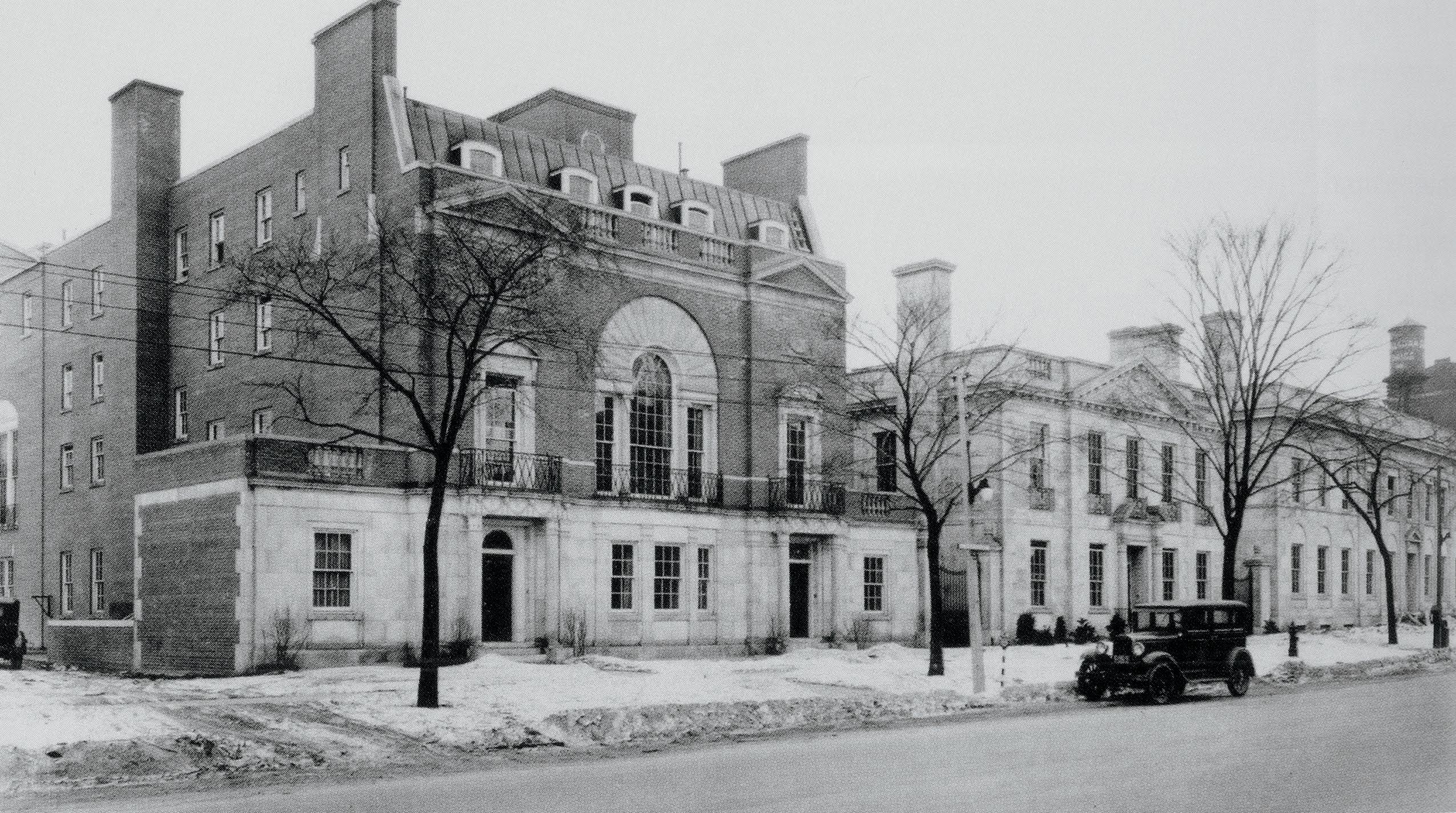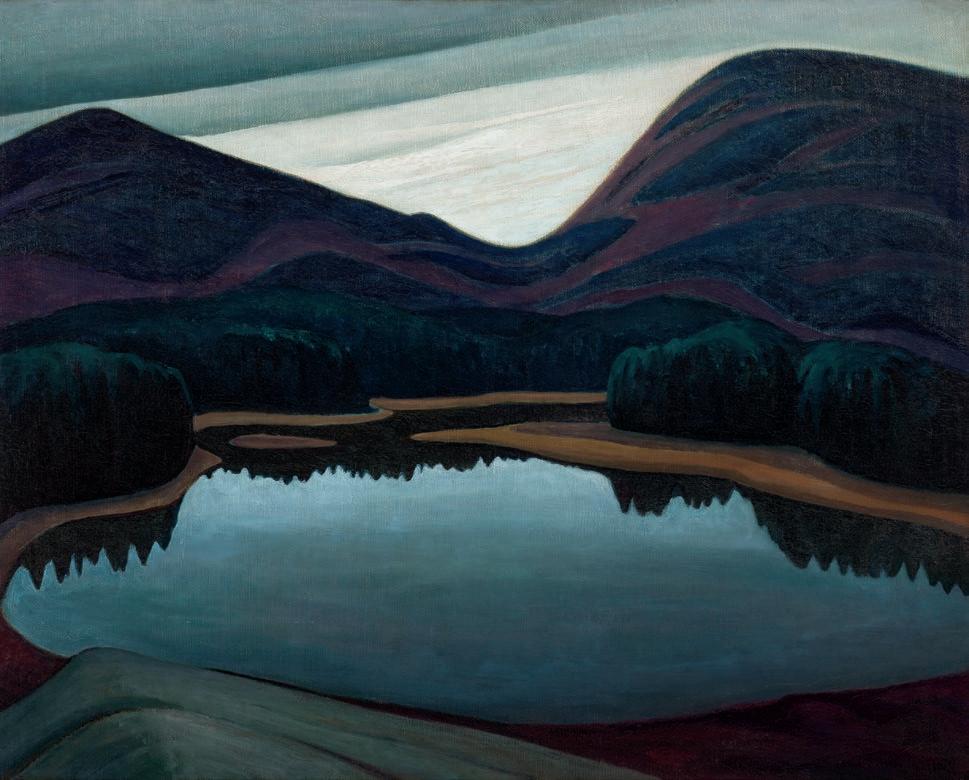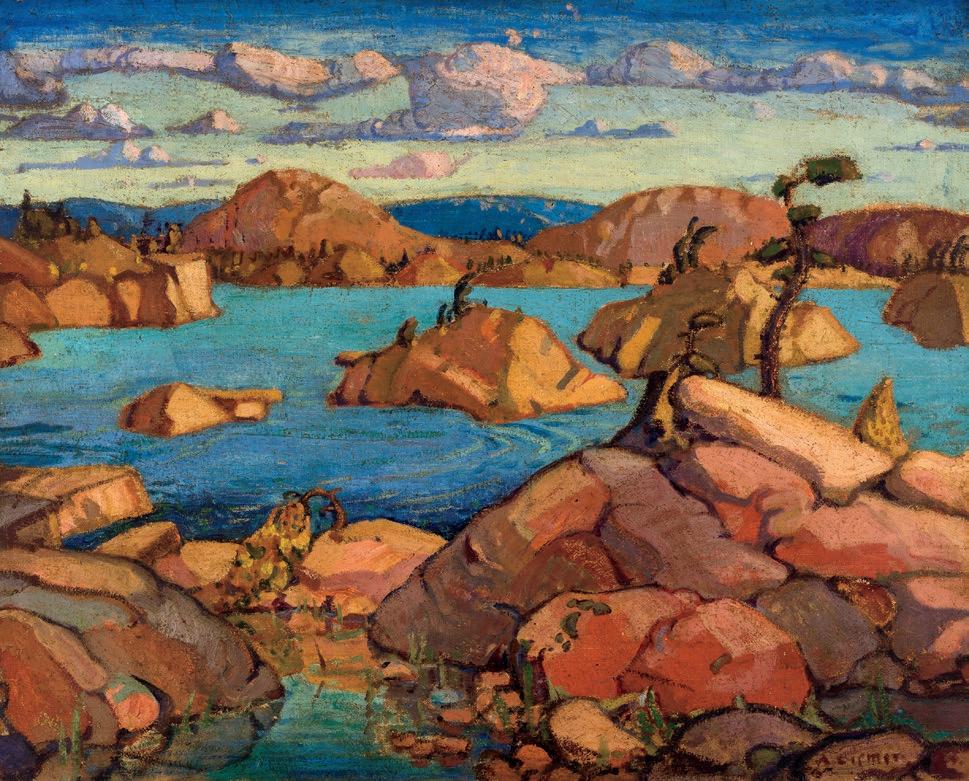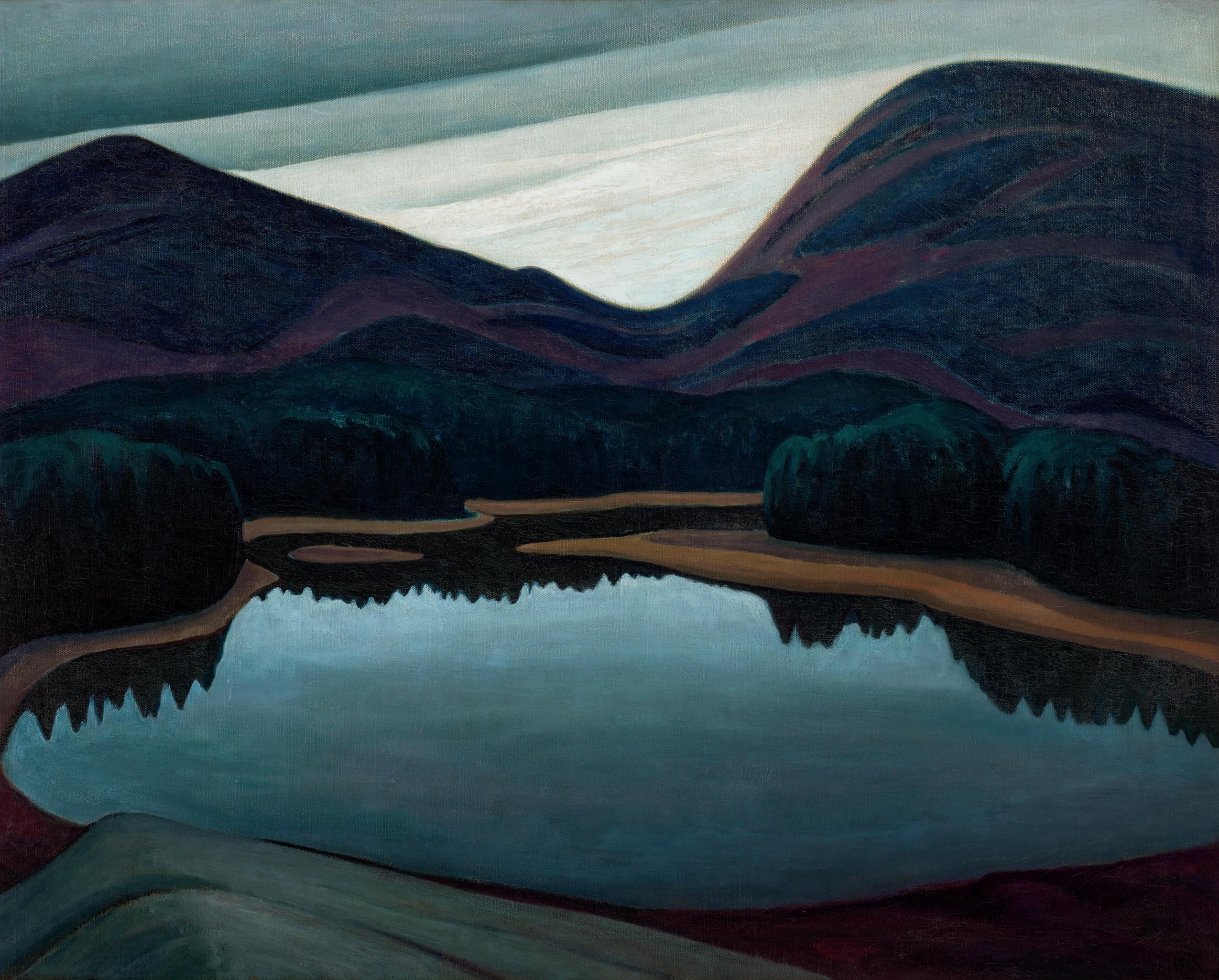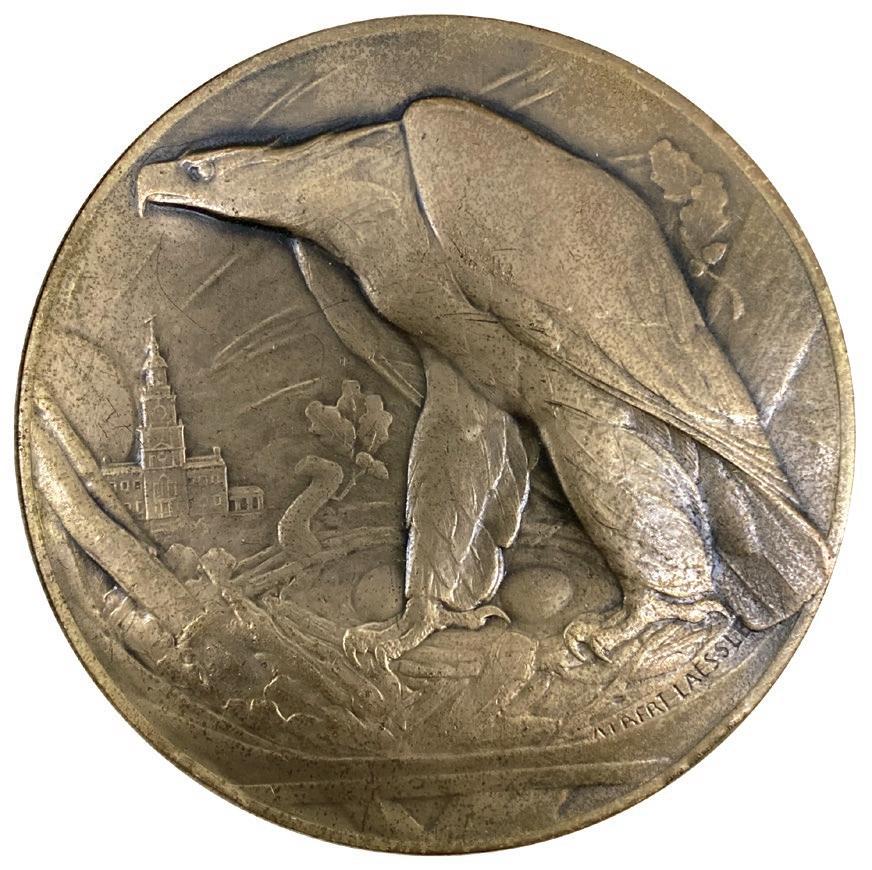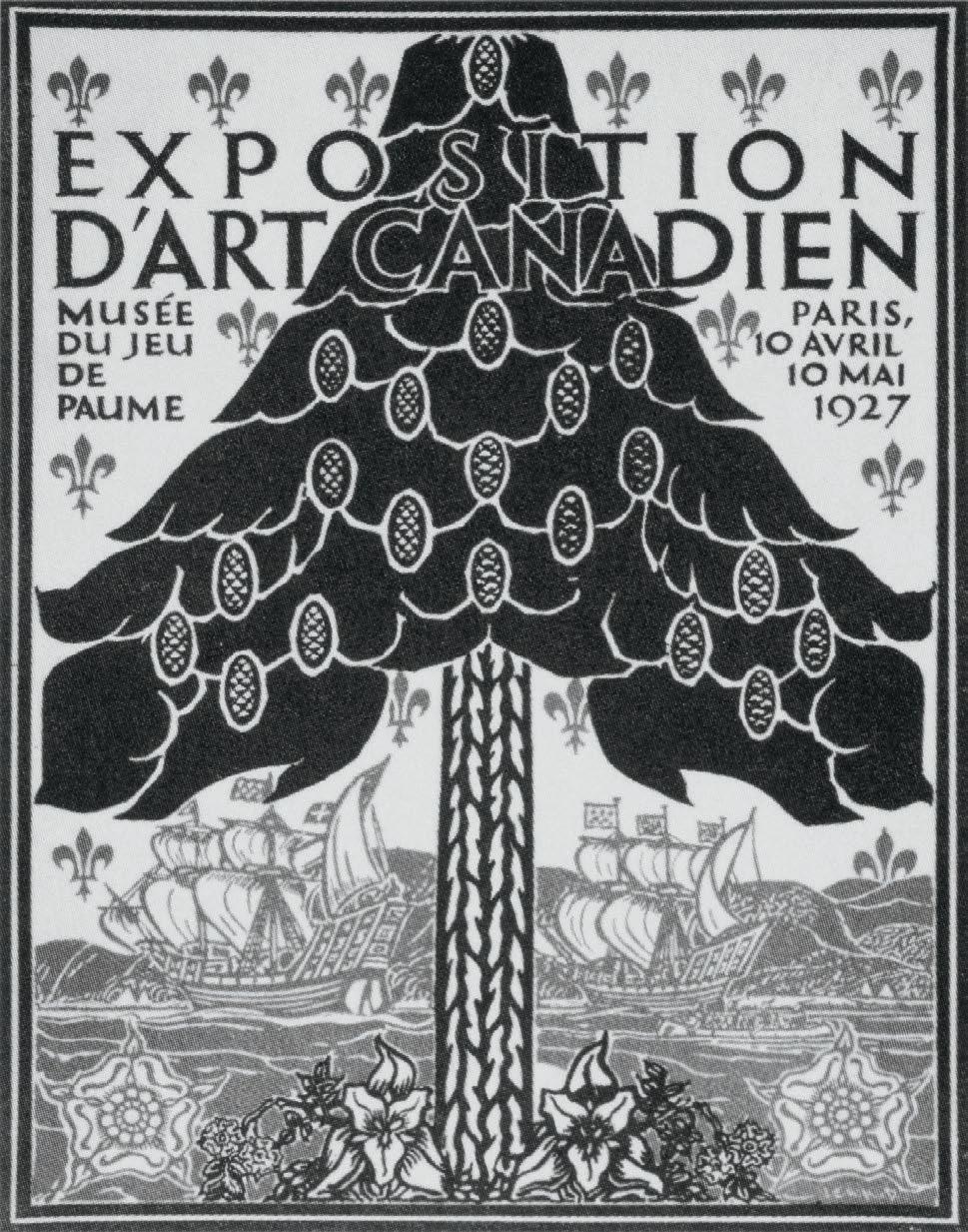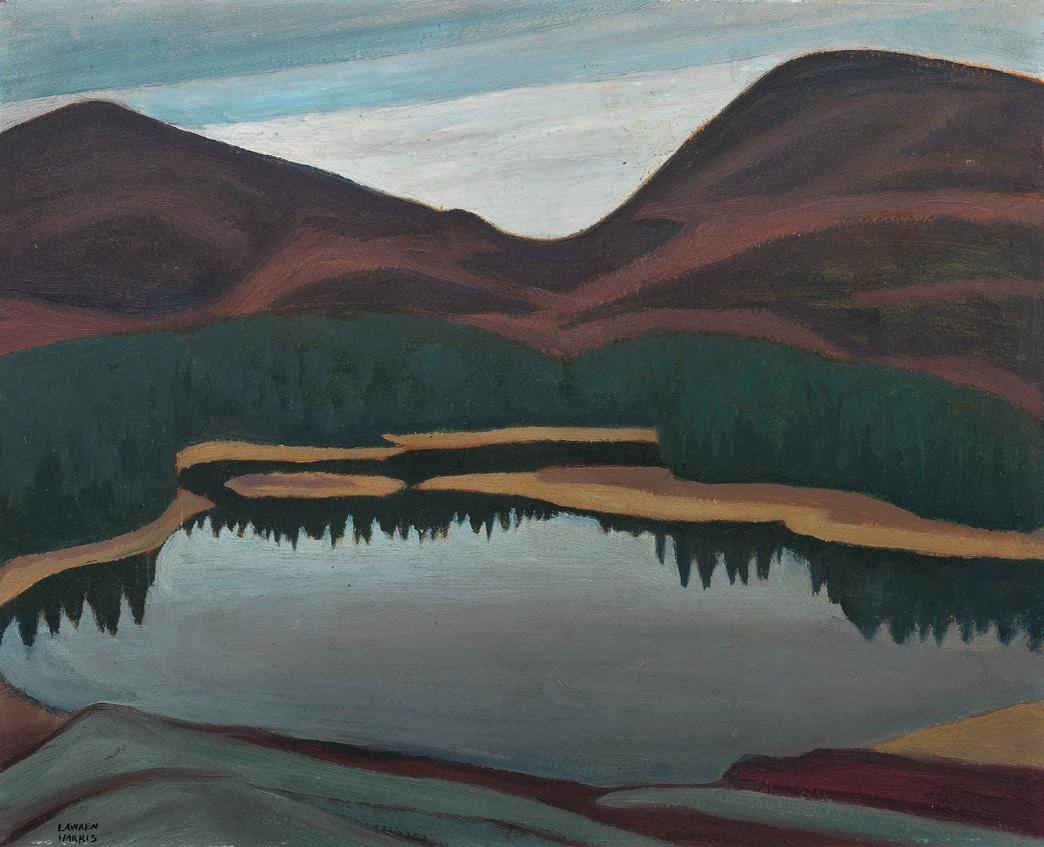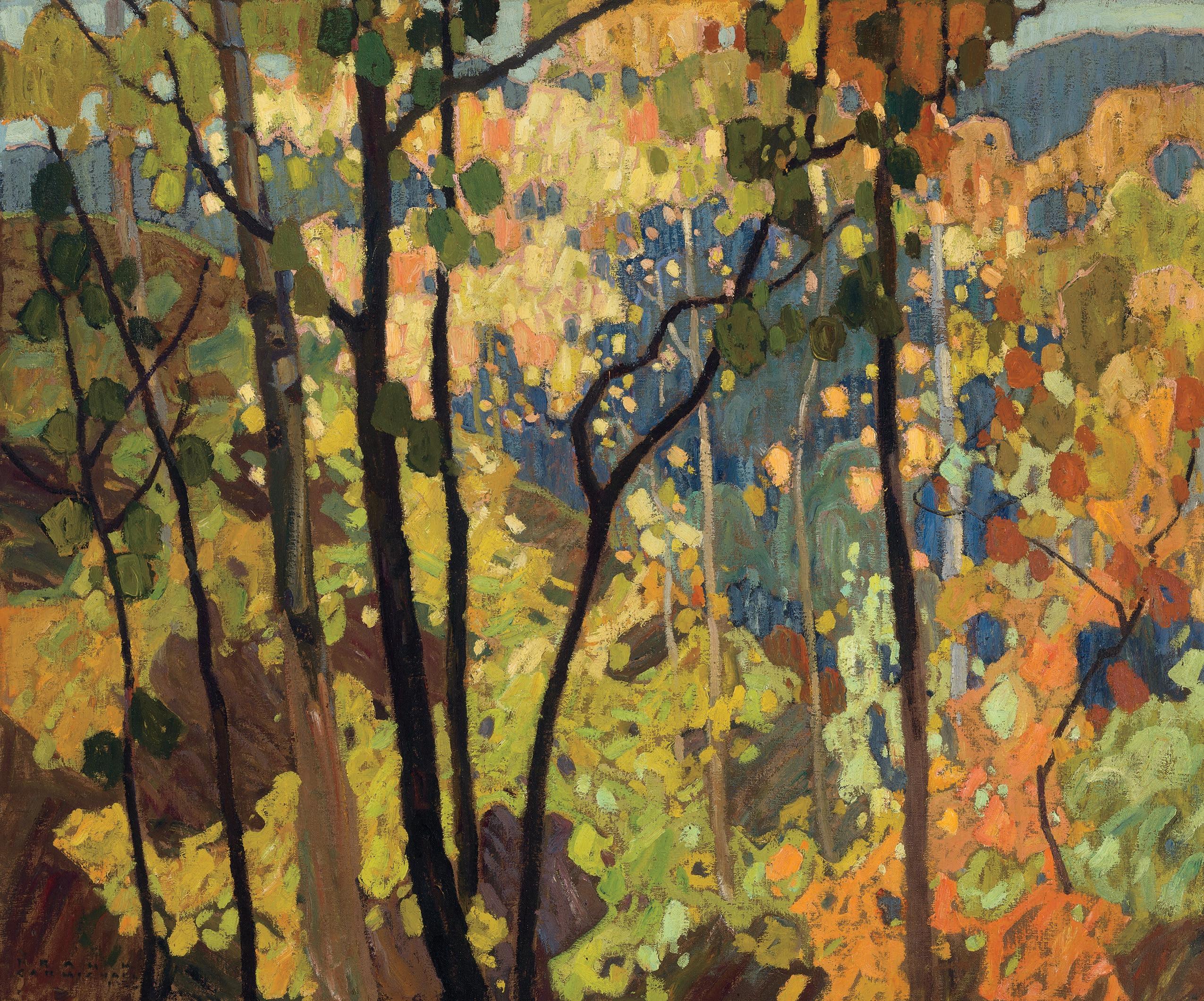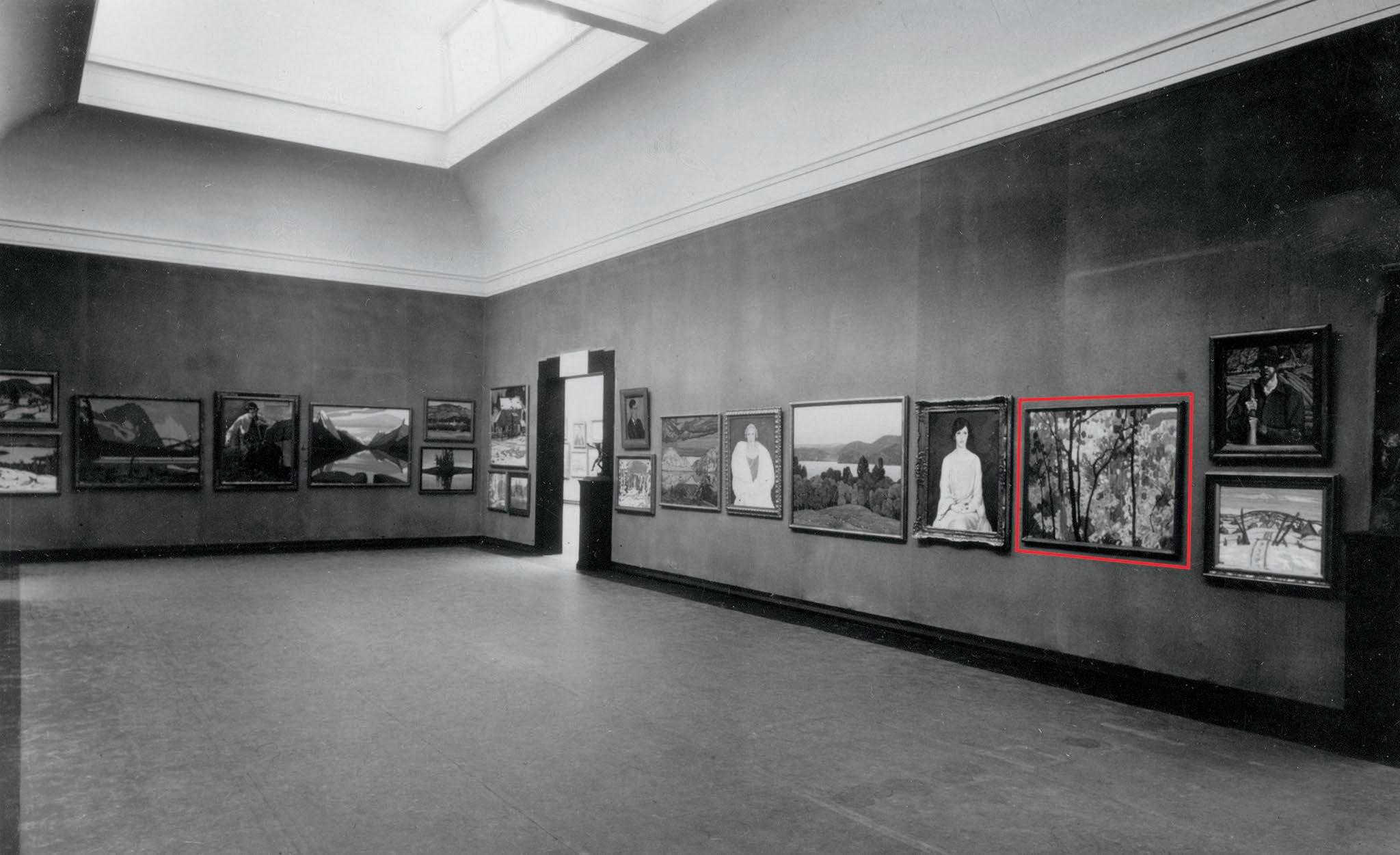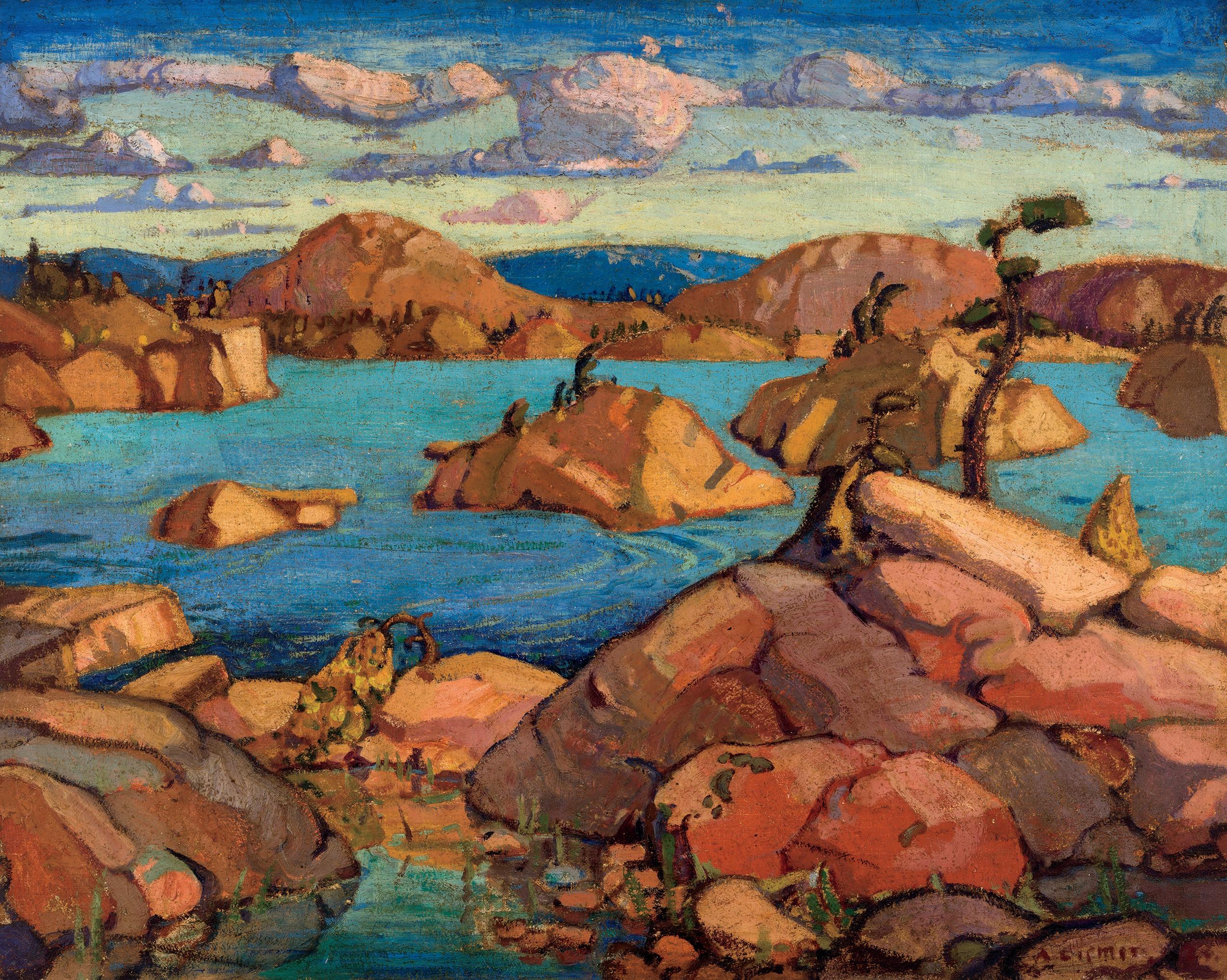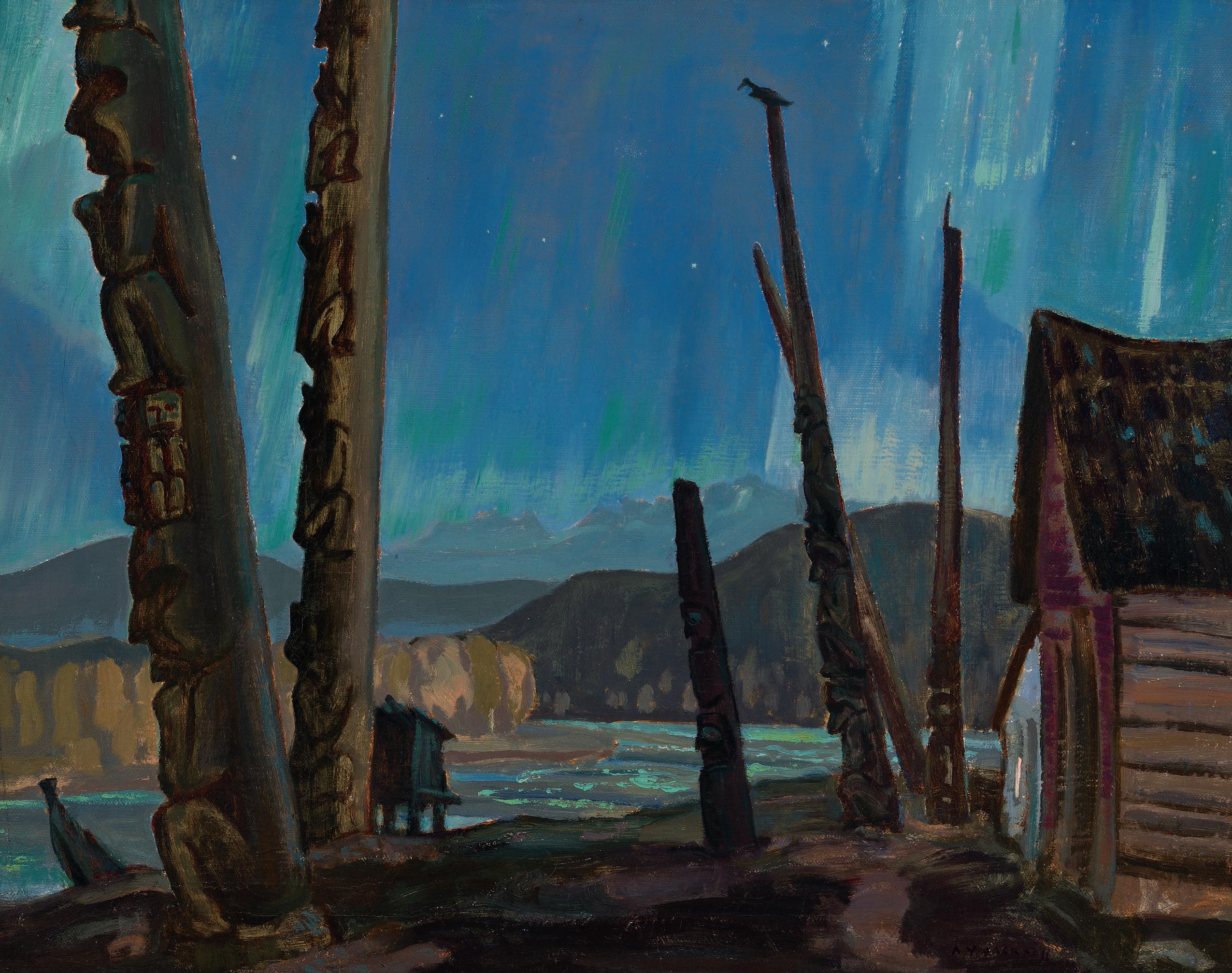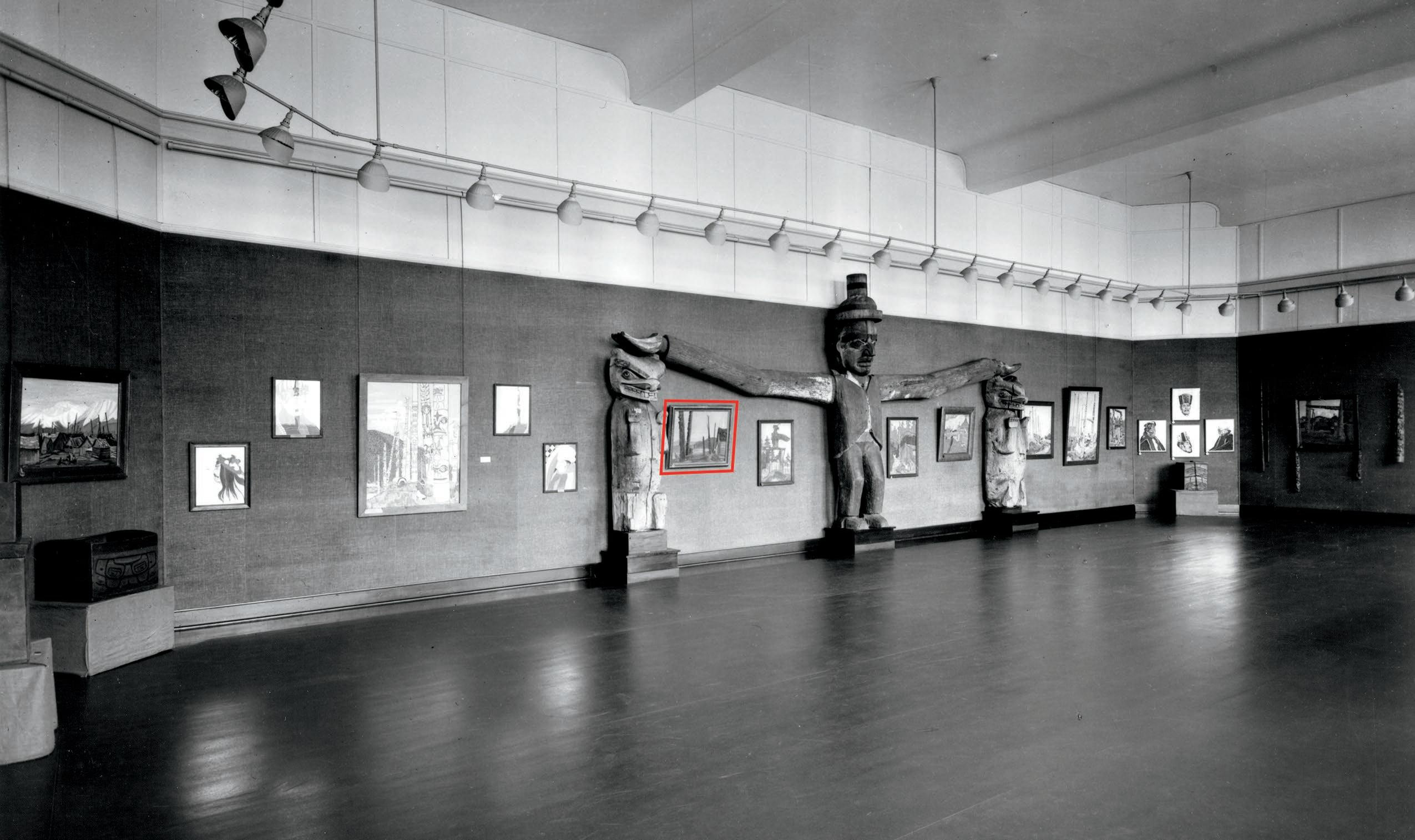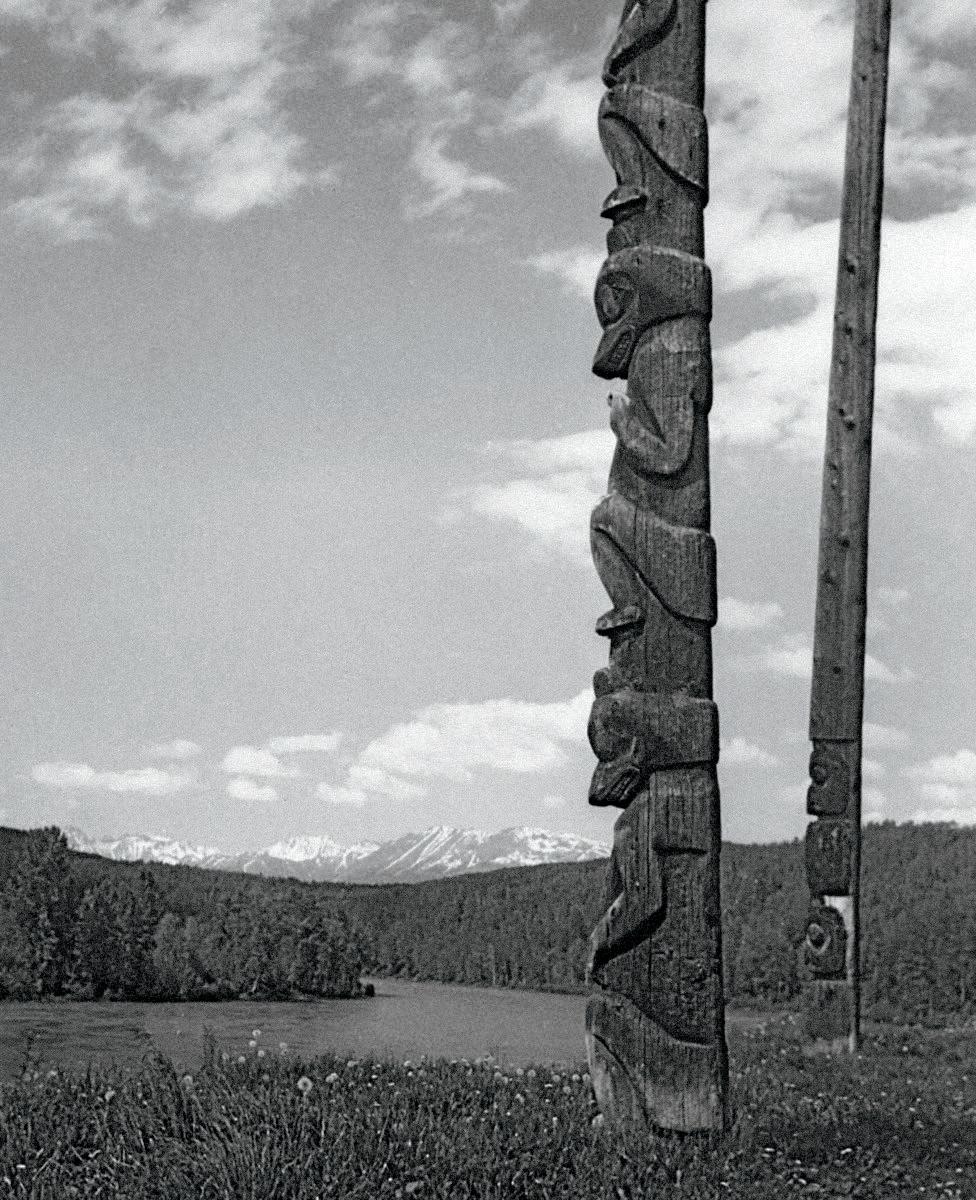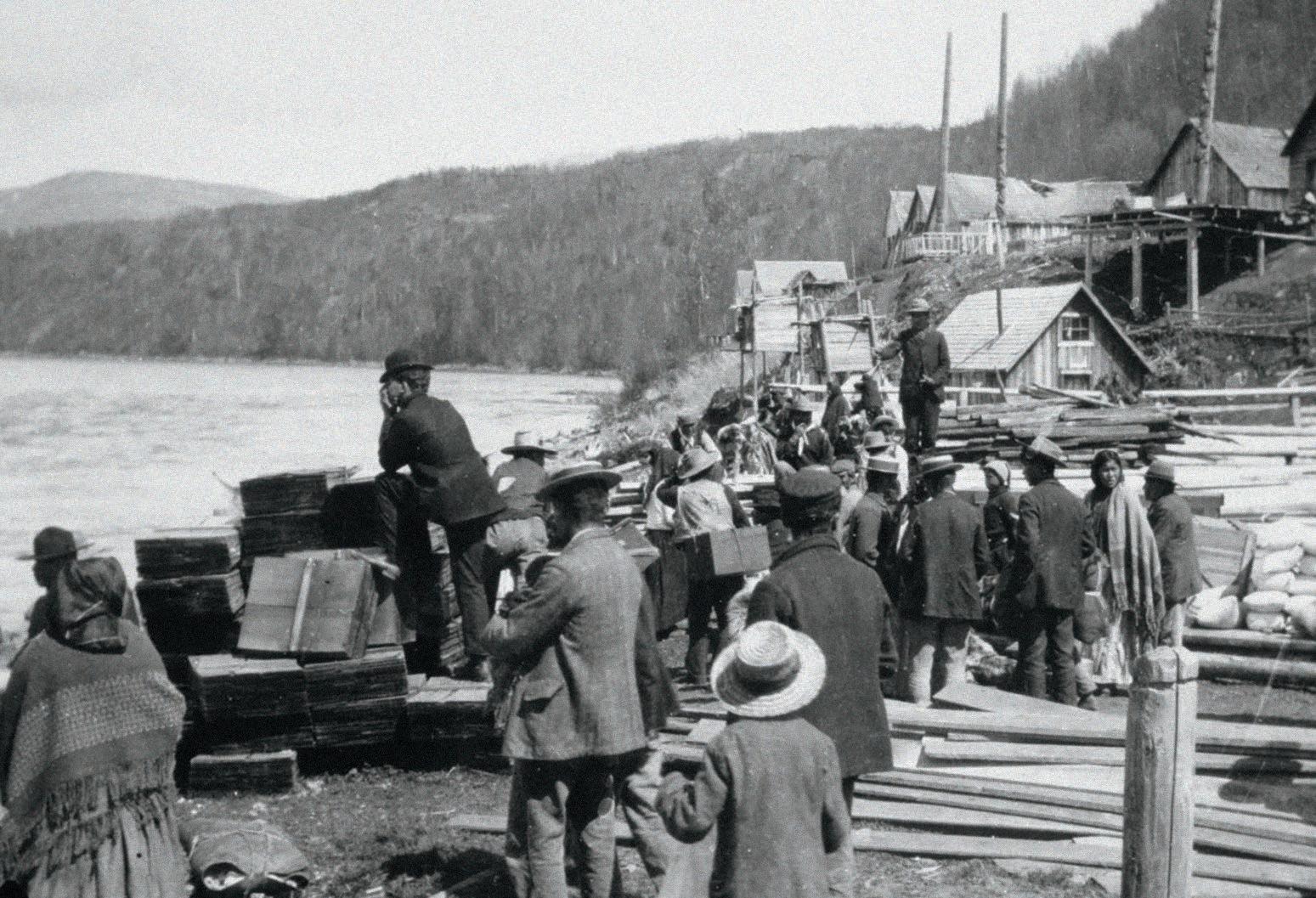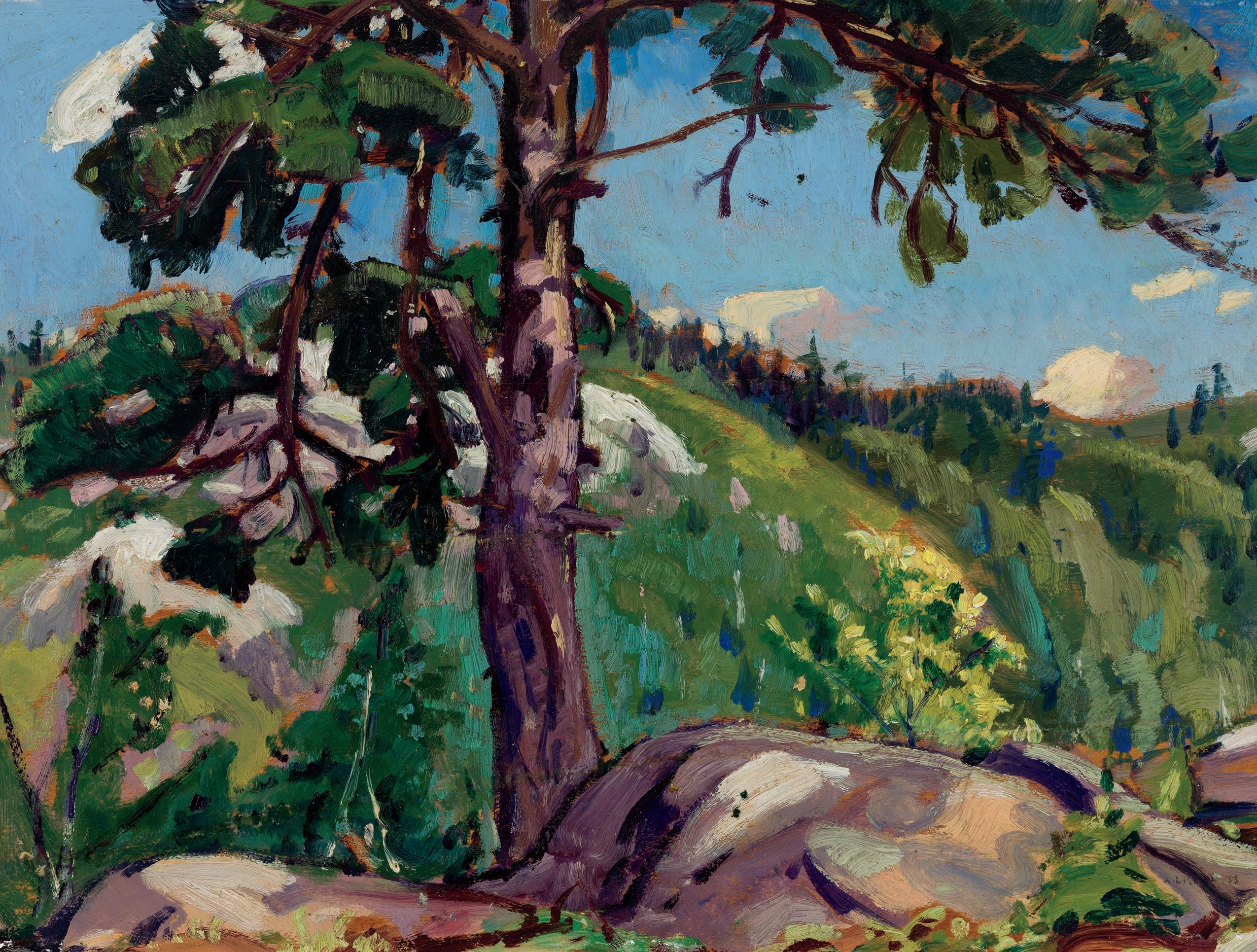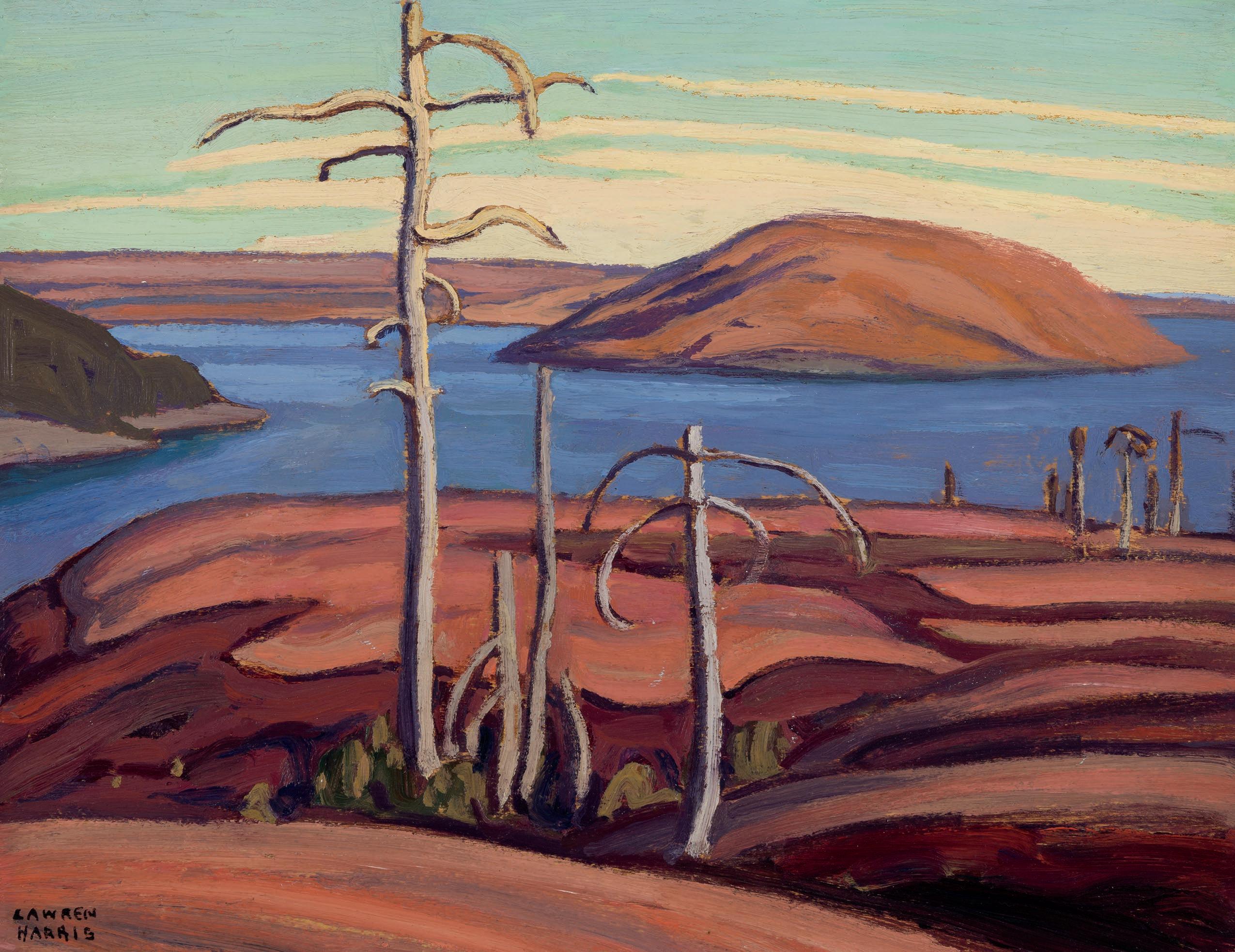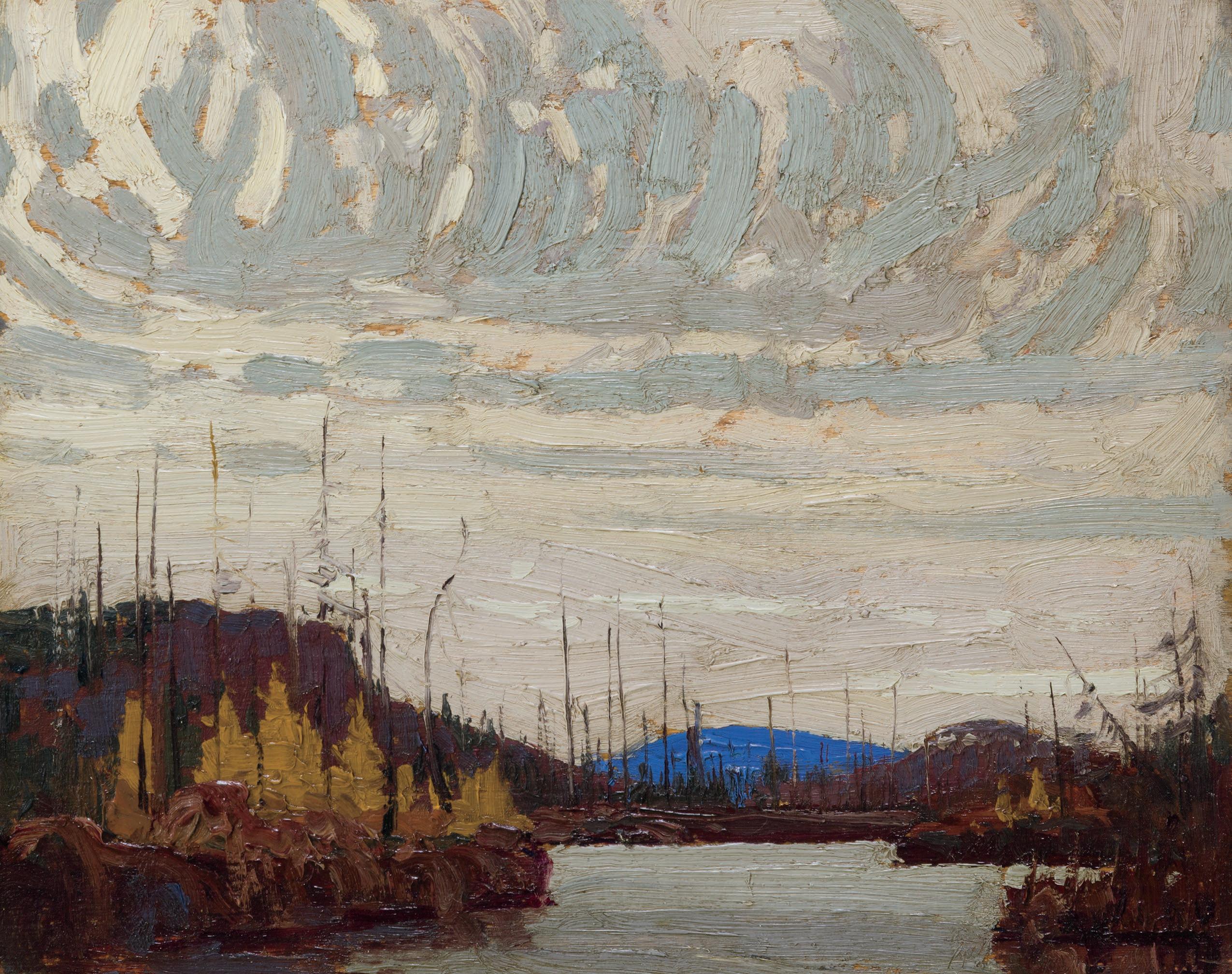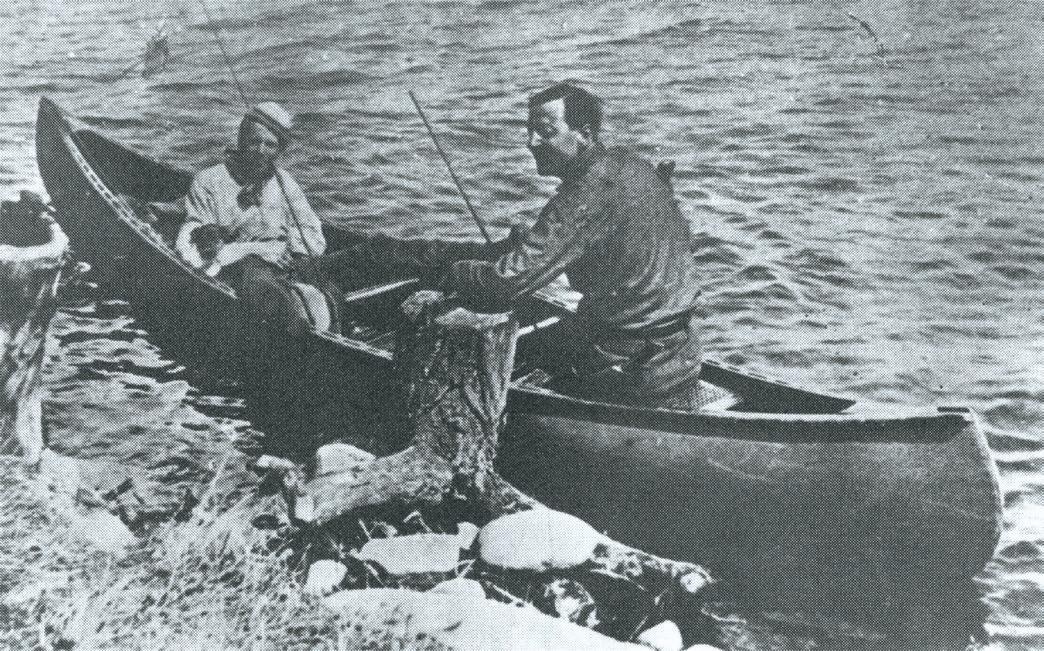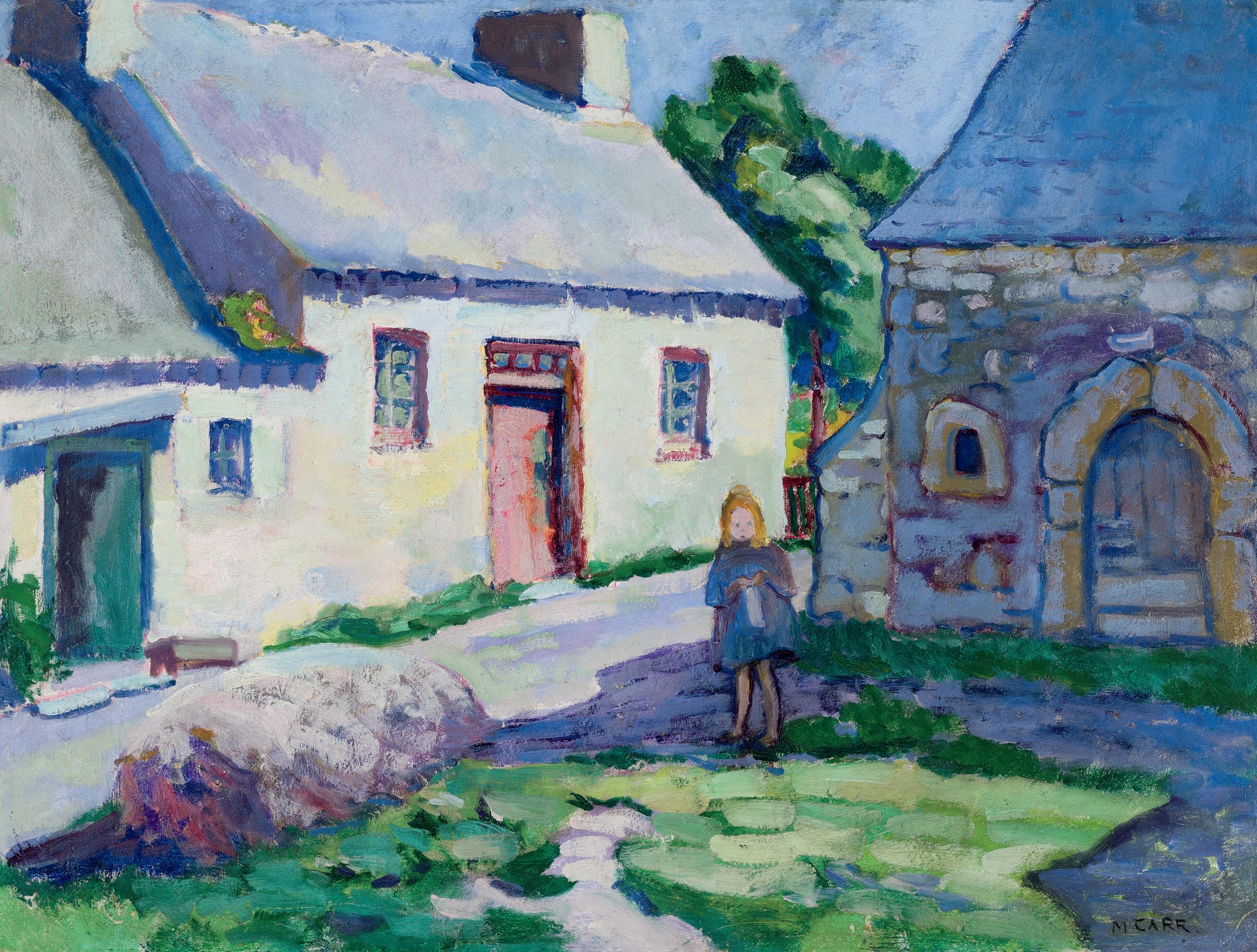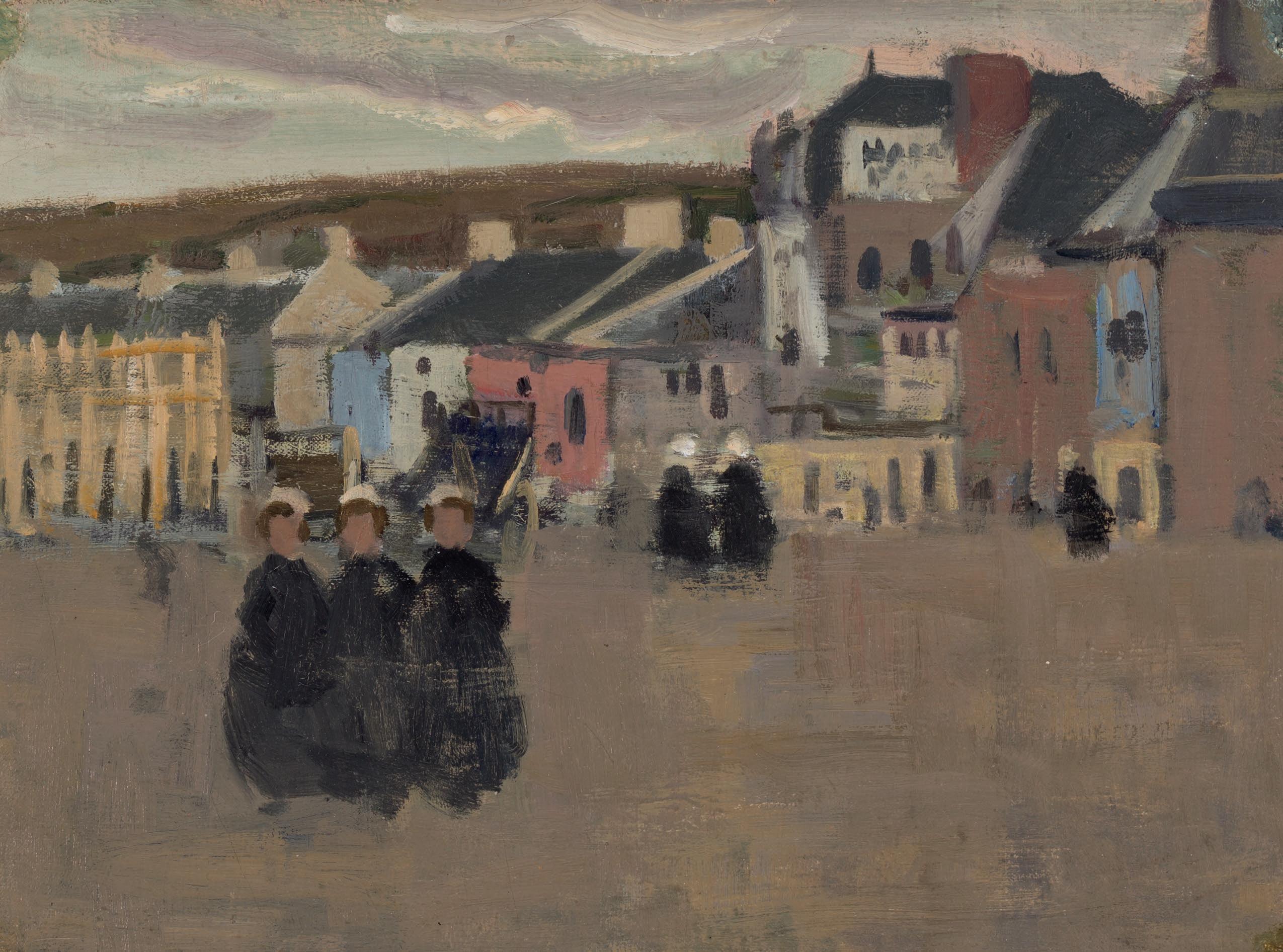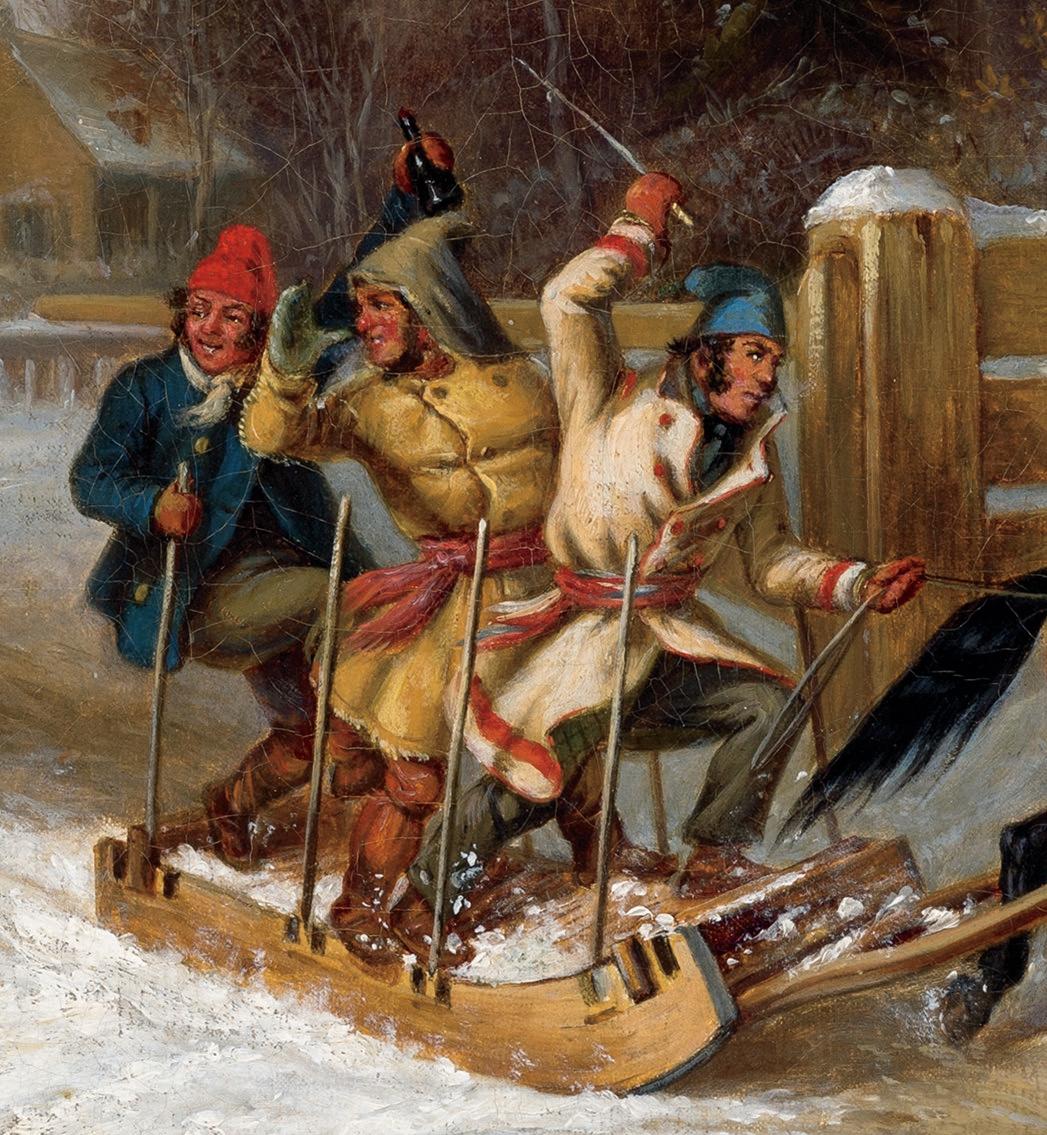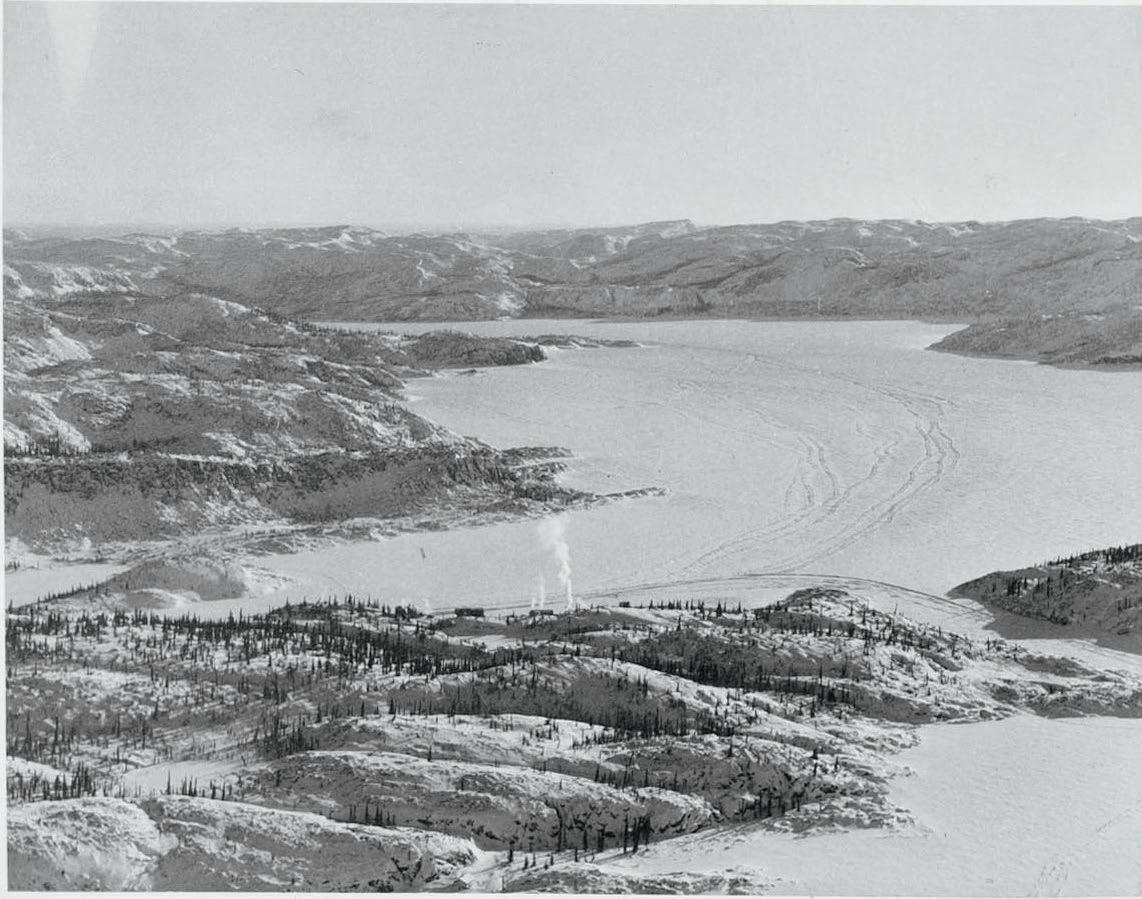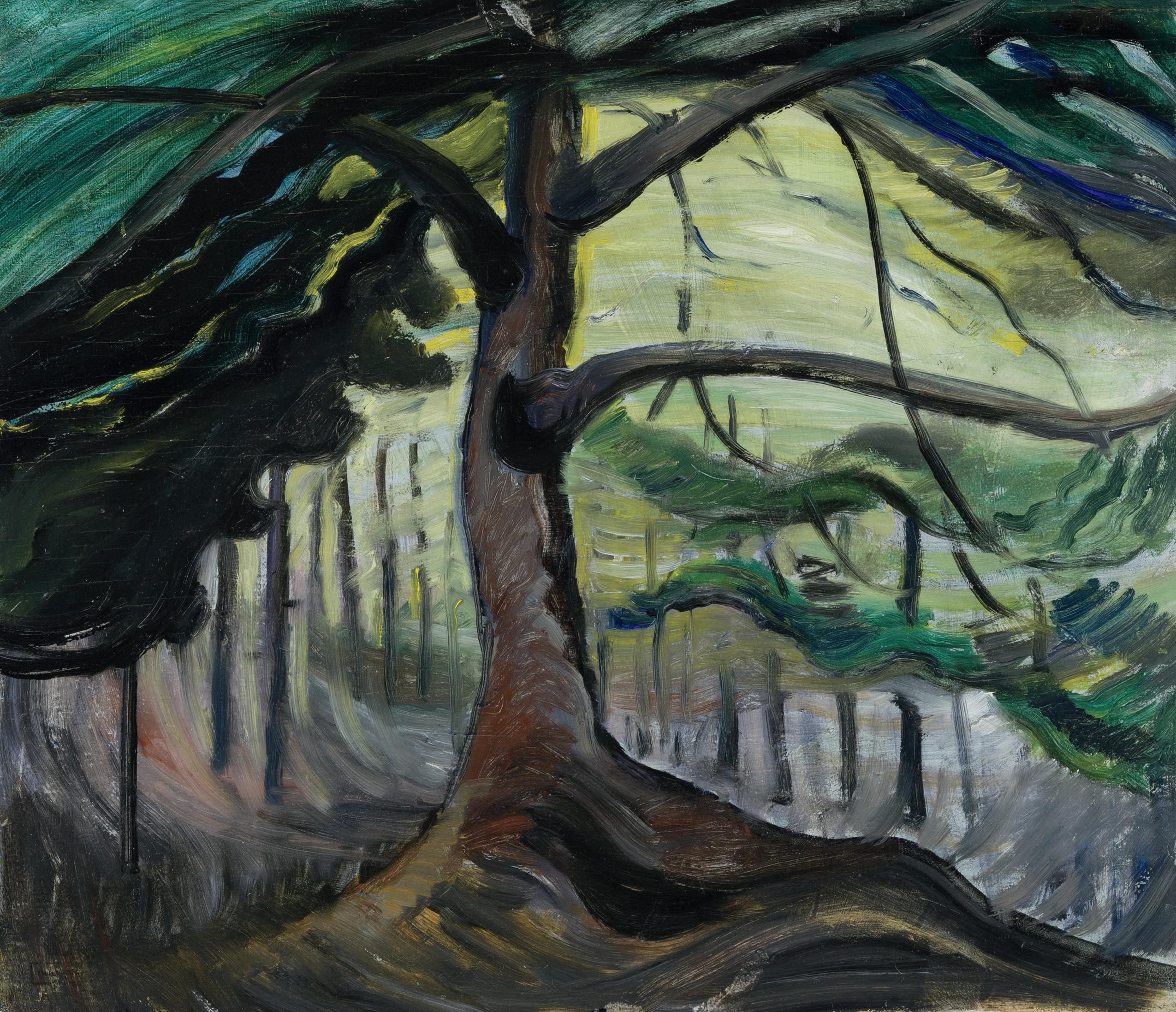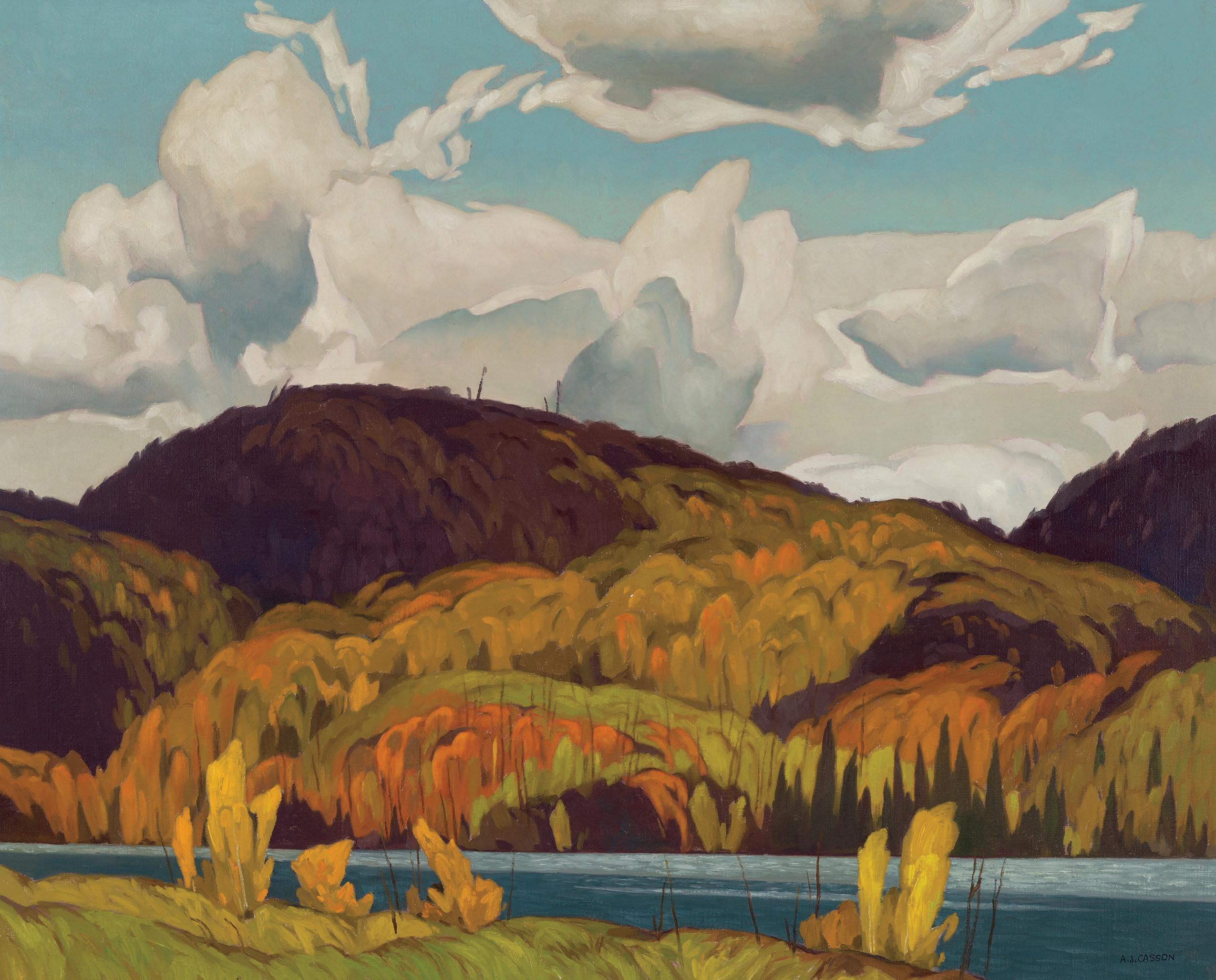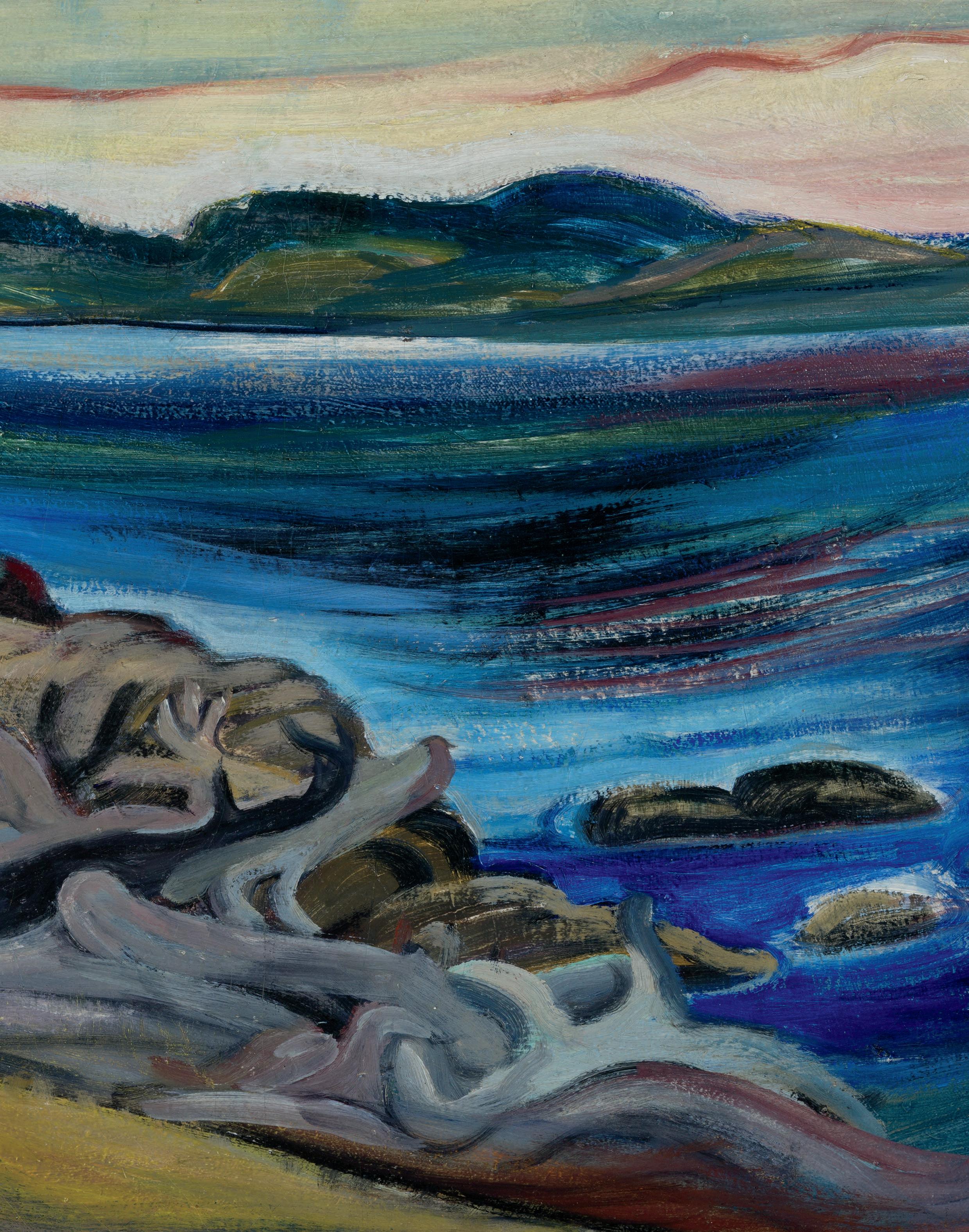& m odern art catalogue
f eaturing w orks fro m
The Family of Ruth Mary Eliot
The Family of Dr. Elizabeth Margaret Forbes, Toronto
The Family of Harry B. and Lucile Housser
The Collection of Torben V. Kristiansen, Vancouver
The Family of William B. Waite, Montreal
The University Club of Toronto
& other Important Private and Corporate Collections
101 Frank Hans (Franz) Johnston
ARCA CSPWC G7 OSA 1888 – 1949
Algoma Waterfall
oil on board, signed Frank H. Johnston and on verso titled, dated circa 1918 – 1919 and inscribed 227 and 14467
13 1/2 × 10 1/2 in, 34.3 × 26.7 cm
p rovenan C e
Roberts Gallery, Toronto
Dr. Elizabeth Margaret Forbes, Toronto
By descent to the present Private Collection, Ontario
B ETWEEN 1918 AN d 1920, Frank Johnston participated in the Group of Seven “boxcar” journeys to Algoma. Fellow Group member Lawren Harris arranged for the use of an Algoma Central Railway boxcar as mobile lodgings and studio, and from this base the artists ventured out on foot or along the tracks by handcar. Their days were filled with sketching and their evenings filled with discussion of the day’s inspiration.
Waterfalls carve their way throughout the wild beauty of Algoma, and their dynamic qualities appealed to Johnston and his companions. Here, Johnston uses quick, gestural applications to capture the downward rush of the water. Throughout the composition, he makes effective use of the honeyed tones of the board beneath as counterpoint to his nimble depiction of the rock formations in harmonizing purples, pinks and blues. Before leaving Toronto for Winnipeg in 1921, Johnston participated in only one Group of Seven exhibition: their inaugural show in 1920. Notably, nearly all of Johnston’s 18 works featured were of Algoma, with titles such as Canyon Algoma and Rapids on the Agawa. Painterly and evocative, Algoma Waterfall portrays essential imagery from a key moment in Johnston’s important career.
e stimate: $ 20,000 – 25,000
102 Alfred Joseph (A.J.) Casson
CGP CSPWC G7 OC POSA PRCA 1898 – 1992
Lighthouse at Bronte
oil on board, signed and on verso signed, titled and dated 1927
9 3/8 × 11 1/4 in, 23.8 × 28.6 cm
p rovenan C e
Private Collection, Toronto
Canadian Art, Joyner Fine Art, November 21, 1997, lot 104
Private Collection, Nova Scotia
Fine Canadian Art, Waddington’s, November 23, 2015, lot 44
Private Collection, Nova Scotia
AlTHOUGH SEEMING VER y much like an image of Canada’s East Coast, this scene depicts the shores of Lake Ontario. The community of Bronte, originally a fishing village founded in 1834
at the mouth of Twelve Mile Creek, now makes up a portion of Oakville, incorporated into the city in 1962. A.J. Casson captured the scene as it would have looked nearly a century ago, depicting houses and fishing shacks in the foreground, and Bronte’s iconic red-capped lighthouse at the far end of the harbour pier, built in 1906. The original lighthouse keeper was Charles Osborne, who retained that post until just a few years before Casson produced this on-site sketch.
Irreplaceably historical, this work is a lovely and distinctive example of Casson’s documentation of Ontario’s past and character. The year 1927 would have been a thrilling time for the young artist, not yet 30. Although he had been painting with members of the Group of Seven throughout the 1920s, he had been formally invited to join the Group the summer of the previous year, filling the vacancy left by Frank Johnston’s 1921 departure.
e stimate: $ 25,000 – 35,000
103 Sir Frederick Grant Banting
1891 – 1941
Church in Quebec / The Colin Range, Jasper (verso)
double-sided oil on board, signed, circa 1928
10 1/2 × 13 1/2 in, 26.7 × 34.3 cm
p rovenan C e
Collection of the Artist
Dr. Henrietta Banting, Toronto
Acquired from the above by Dr. Elizabeth Margaret Forbes, Toronto
By descent to the present Private Collection, Ontario
dR . fRE d ERICK B ANTING will forever be renowned for the irreplaceable contribution that his co-discovery of insulin made to the world. His second life as an artist, however, is a significant contribution as well. He traveled across Canada and around the globe, sketching on site in oil paint and in pencil. His accomplished pencil sketches are, in fact, a key to a mystery of this double-sided work.
The signature side features imagery very likely produced on one of his many trips to Quebec with A.Y. Jackson. The verso image, however, appears to be of the Colin Range, in Jasper, Alberta, some 3,300 kilometres away as the crow flies. Since
Banting did not routinely title, date or even sign his paintings, secondary sources must often be used to determine such details. Thankfully, many of his sketchbooks still exist, and they contain information that ties together these disparate images.
In sketchbooks dated to 1928, Banting rapturously sketched multiple scenes of the Rocky Mountains. In the summer of that year, he and Jackson journeyed up the Athabasca River to the Northwest Territories, evidently first paying a visit to nearby Jasper. Similarly dated sketchbooks also indicate that Banting accompanied Jackson on his trip to rural Quebec earlier that spring. One particular sketch not only corresponds to the imagery of the painting but also includes the colour note “Cobalt” in relation to the church’s spire. The steeple is indeed blue in our oil sketch—likely Banting’s depiction of its patinated copper cladding. Painted months and leagues apart, these images comprise a rare complete double-sided work in the artist’s larger sketch size, and the contrasting subject matter renders the work singularly unique.
The provenance of this work is also exceptional. Its previous owner was Dr. Elizabeth Margaret Forbes, chief of radiology at Women’s College Hospital, Toronto, from 1955 to 1975. Amongst her formidable professional accomplishments, she is noted for co-writing one of Canada’s earliest journal articles on mammography. Dr. Forbes’s co-author on this paper was none other than Dr. Henrietta Banting, then director of Women’s College Hospital’s Cancer Detection Clinic. It was from Henrietta Banting, Frederick Banting’s second wife, that Dr. Forbes originally acquired this fine work.
e stimate: $ 20,000 – 25,000
tOP:
sir f rederi C k grant b anting
Sketch for Church in Quebec graphite on paper, 1928
Frederick Banting Papers, MS Coll. 76, box 43 A
Courtesy of the Thomas Fisher Rare Book Library, University of Toronto
Not for sale with this lot
BOttOM :
sir f rederi C k grant b anting
Sketch for The Colin Range, Jasper graphite on paper, 1928
Frederick Banting Papers, MS Coll. 76, box 43 A
Courtesy of the Thomas Fisher Rare Book Library, University of Toronto
Not for sale with this lot
104 Lawren Stewart Harris
ALC BCSFA CGP FCA G7 OSA t PG 1885 – 1970
Algoma
oil on board, on verso signed, titled, inscribed about 1918 by Thoreau MacDonald / acquired from Lawren Harris, Studio Building, 25 Severn Street, Toronto, 1933 and variously by Carl Schaefer / DP 09 and certified by Thoreau MacDonald, October 1969, circa 1916 – 1918
10 3/4 × 6 1/2 in, 27.3 × 16.5 cm
p rovenan C e
Acquired directly from the Artist by Carl Schaefer, Toronto, 1933 Estate of Carl Schaefer
Loch Gallery, Winnipeg Private Collection, Toronto Fine Canadian Art, Heffel Fine Art Auction House, June 17, 2009, lot 122 Private Collection, Montreal
l iterature
Jeremy Adamson, Lawren S. Harris: Urban Scenes and Wilderness Landscapes, 1906 – 1930 , Art Gallery of Ontario, 1978, page 79
T HIS BO ld, d RAMATIC sketch is full of contrast and colour, depicting the interplay of light and shadow on scraggly trees and moss-covered boulders in front of a steep rock face. Swiftly executed with assured brush-strokes and using rich colours, it demonstrates the vision that Lawren Harris had for a Canadian school of art, where the particular and diverse characteristics of this country’s environments were revealed to the audience and celebrated. For Harris, achieving this vision demanded time spent observing and painting out of doors in front of the subject. He wrote, “This land is different in its air, moods, and spirit from Europe and the Old Country. It invokes a response which throws aside all preconceived ideas and rule-of-thumb reactions. It has to be seen, lived with, and painted with complete devotion to its own life and spirit before it yields its secrets.” 1
In the years leading up to the 1920 founding of the Group of Seven, Harris began embarking on sketching trips to northern Ontario, often accompanied by artists who would later form this now legendary group. Although it is difficult to pinpoint the exact subject and location for this work, possibly it derives from one of the earlier trips to Algoma, as suggested by the first owner, fellow artist Carl Schaefer, on the verso. Harris visited Algoma in both spring and fall on a number of trips between 1919 and 1922, and though autumn journeys were more frequent, the colouring and tone of this picture suggests it was done in the spring or summer. Stylistically, an alignment with the work that Harris did in Algonquin Park in the spring of 1916, when he visited the area with Tom Thomson, provides another option for the subject.
Regardless of the specific location, the work is clearly executed with passion and vigour, displaying the excitement Harris found in depicting new and interesting Canadian subjects. This enthusiasm helped bolster the creative evolution of the Group of Seven and influenced younger artists, including the aforementioned Schaefer, himself a successful artist, who acquired this work
directly from Harris in 1933. He spoke of the influence Harris had on his work: “The Group of Seven in the 1920s were going full steam and they rubbed off on me, but I must say I was influenced not from a technical point of view but another point of view, of broadness, design, a new conception of our country. . I brought my things back and showed them to Lawren Harris and [J.E.H.] Macdonald and Alec Jackson and they were very pleased.” 2
In 1936, Schaefer joined the Canadian Group of Painters, which had formed in 1933 as an outgrowth and expansion of the Group of Seven; the latter’s direct and simple nomenclature had become unwieldy and confusing when their trajectory shifted towards expansion to incorporate a wider membership. The mission of the new group was to continue to expand and broaden the scope of Canadian art—an effort that had started to build momentum at the time this panel was painted, in the years between 1914 and 1919. Given Harris’s leadership in this movement, fine works such as Algoma would have been inspirational and valued treasures for artists like Schaefer, and it is fitting that they continue to be held in such high regard by collectors today.
We thank Alec Blair, Director/Lead Researcher, Lawren S. Harris Inventory Project, for contributing the above essay.
1. Quoted in Lawren Harris, ed. Bess Harris and R.G.P. Colgrove (Toronto: Macmillan, 1969), 48.
2. Quoted in Margaret Gray, Margaret Rand and Lois Steen, Carl Schaefer (Toronto: Gage Publishing, 1977), 11.
e stimate: $ 70,000 – 90,000
105 Alexander Young (A.Y.) Jackson
ALC CGP G7 OSA RCA RSA 1882 – 1974
Street in Quebec
oil on board, signed and on verso signed, titled and dated circa 1924 on the A.K. Prakash & Associates Inc. label 8 1/2 × 10 1/2 in, 21.6 × 26.7 cm
p rovenan C e
The Art Emporium, Vancouver, 1972
Private Collection, Montreal
A.K. Prakash & Associates Inc., Toronto Private Collection, Toronto
A.y. J ACKSON GREW up in Montreal, and rural Quebec was always a special place for him. Throughout his career, Jackson sketched the region extensively; he reveled in both the architecture and the landscape of his native province. He often chose to paint the villages on the northern banks of the St. Lawrence River in late winter, when the snow was beginning to melt. Street in Quebec is a fine example of his deft handling of village architecture. He depicts the familiar motif of the horse and sleigh and, above all, demonstrates his command of light and shadow. The bright sunlight and contrasting shadows provide the image with a sense of life and clearly define the pictorial space.
Jackson’s scenes of small Québécois villages are among the most satisfying of his sketches. He realized that these rural settlements were quickly changing and sought to capture the unique aspects of Québécois life before they were gone. His slight resistance to the changes brought on by modernity is evident in the omission of the power lines between the two poles within the composition.
e stimate: $ 50,000 – 70,000
106
Alexander Young (A.Y.) Jackson
ALC CGP G7 OSA RCA RSA 1882 – 1974
Barns in Winter / Winter Landscape (verso) double-sided oil on board, signed A.Y. Jackon [sic] and on verso inscribed Ruth Eliot in graphite
8 3/8 × 10 1/2 in, 21.3 × 26.7 cm
p rovenan C e
Acquired from the Artist by Ruth Mary Eliot
By descent through the family to the present Private Collection, Ontario
l iterature
A.Y. Jackson, A Painter’s Country: The Autobiography of A.Y. Jackson, 1958, page 120
T HE O ld BARNS nestled in the pastoral counties along the St. Lawrence River were an enduring source of inspiration for A.Y. Jackson. Often painting in the L’Islet and Charlevoix regions of Quebec, Jackson lamented rapid modernization and the slow disappearance of these picturesque structures. In Barns in Winter, the rhythmic patterns of sloping rooftops echo across the contoured hillside and opalescent snowbanks, while the verso sketch, Winter Landscape, features a stoic barn, its peak mirrored in the distant Laurentian Mountains.
Jackson routinely used both sides of his supports while on site, and these charming winter vignettes signal the legacy of rural architecture and its integral role in shaping the identity of the Québécois countryside. The unique provenance of this work underscores Jackson’s dedication to his annual painting expeditions alongside friends. In his autobiography he recalls: “I went every September to the Hewards’ summer home in Brockville. We used to motor all around the district on sketching trips; the Eliots—Charlie, Ruth and their mother, Prudence Heward. . On the back roads we would find a creek or an old farm and all go to work.” Ruth Eliot, herself a landscape artist, acquired this painting directly from Jackson, and it has remained in the collection of her family.
e stimate: $ 25,000 – 35,000
verso
107 Emily Carr
BCSFA CGP 1871 – 1945
Gore Avenue Slip
watercolour on paper, signed M Carr and on verso titled Gore St. [sic] Slip on the gallery label, circa 1909 – 1910
10 7/8 × 15 in, 27.6 × 38.1 cm
p rovenan C e
Galerie Royale, Vancouver
Private Collection, Vancouver
Fine Canadian Art, Heffel Fine Art Auction House, November 28, 2013, lot 142 Private Collection, Vancouver
A T THE TURN of the twentieth century, Victoria offered little stimulation for an ambitious artist. It had neither an art gallery nor an art society, and creative opportunities were scarce. When Emily Carr was offered a teaching post at the Vancouver Ladies’ Art Club in 1906, she seized the opportunity. Vancouver, though still in its commercial infancy, had a burgeoning artistic community, with exhibitions held through the Vancouver Studio Club and an active art association. The city’s harbour was a thriving economic hub, with Burrard Inlet and Coal Harbour lined with docks, shipping facilities and packing houses.
Carr’s time at the Ladies’ Art Club, however, was short-lived. A fiercely independent artist, she found herself at odds with the expectations of her students—society women who sought a more polished, conventional approach. Frustrated by these constraints, she left to establish her own studio at 570 Granville Street, where she taught on her own terms. She also instructed students at two private schools in North Vancouver. These ventures proved both successful and fulfilling, yet teaching left her with limited time for painting. While she occasionally worked alongside her students, most of her own work was completed during the summer, when she traveled to locations such as Stanley Park to capture the city’s evolving landscape. Consequently, watercolours from this period are rare.
Despite these limitations on her time, Carr’s reputation grew. In 1908, she co-founded the BC Society of Artists, exhibiting regularly alongside fellow painters. Collectors began to acquire her works, solidifying her status as a rising talent. Her time in Vancouver proved formative, but in July 1910, she left for France, embarking on a transformative journey that would redefine her artistic vision.
Among the standout works from this period, Gore Avenue Slip is a testament to Carr’s ability to capture both the energy and atmosphere of Vancouver’s working harbour. The painting’s vibrant yet harmonious palette infuses the composition with a striking immediacy—cool blues and greys evoke the crisp coastal air, while rich ochres and umbers bring warmth to the bustling dock. The reflection of boats and structures on the water is rendered with a fluid, masterful hand, a hallmark of Carr’s skill in manipulating washes.
Beyond its aesthetic merit, Gore Avenue Slip (the street being named after a surveyor general of BC ) is also a valuable historical document. The dockside activity—marked by a tugboat, sailboats, a horse-drawn cart and workers engaged in their daily tasks—offers an authentic glimpse into the rhythms of early twentieth-century Vancouver. The presence of Asian fishermen, likely part of the city’s growing immigrant workforce, speaks to the multicultural fabric of the waterfront economy. The wooden sheds, modest and functional, reflect the simplicity of industrial structures at the time, while the distant North Shore mountains remain largely untouched, hinting at a Vancouver still on the brink of rapid expansion.
Carr’s technical prowess is on full display in this watercolour. Her layering of transparent washes creates a luminous quality, while her controlled yet expressive brushwork brings movement and life to the scene. She balances precision with spontaneity— her sky is atmospheric yet loose, while architectural details are carefully delineated without feeling rigid. This delicate interplay between structure and fluidity imbues the painting with both immediacy and depth, making Gore Avenue Slip not only a superb example of Carr’s early work but also a vital record of Vancouver’s evolving waterfront.
e stimate: $ 70,000 – 90,000
108 Helen Galloway McNicoll
ARCA RBA 1879 – 1915
Happy Moments
oil on canvas, on verso titled, inscribed Children Playing in the Woods (crossed out) and variously and stamped with the Artist’s Estate stamp twice and Studio Helen G. McNicoll RBA ARCA cat. no. 56 twice 20 × 24 in, 50.8 × 61 cm
p rovenan C e
Estate of the Artist, Montreal Private Collection, Toronto
e xhibited
Art Association of Montreal, Memorial Exhibition of Paintings by the Late Helen G. McNicoll, RBA , ARCA , November –December 1925, catalogue #56
Art Gallery of Toronto, Inaugural Exhibition, January 29 –February 28, 1926, titled as Children Playing in the Woods, catalogue #264
T HE ACTIVITIES AN d relationships of young girls were subjects Helen Galloway McNicoll revisited frequently during her short but prolific career. These included working girls in farmyards and fields, and middle-class girls sewing, picking flowers and snacking on cherries. Focused on their own matters, the children pay the viewer no mind. Happy Moments is in many ways characteristic of these works. The painting finds a central duo sitting in an intimate and casual pose in the grass next to a river, perhaps telling stories or confiding secrets. They seem unconcerned as a younger companion—a little sister who tagged along uninvited?— wanders off into the woods beyond.
McNicoll’s luminous approach to the subject reflects the artist’s commitment to plein air painting, which she would have first encountered in her education at the Art Association of Montreal and the Slade School of Fine Art, in London. This was a practice she shared with the British artist Dorothea Sharp (1874 – 1955), with whom she lived and worked after their 1905 meeting in the rural artists’ colony of St. Ives, Cornwall. The two artists traveled widely across England and Europe, settling in rural villages and painting the landscape and its inhabitants.
The theme of children playing beside a stream or river is found in several of the pair’s works; indeed, Happy Moments shares models and location with another McNicoll painting, Watching the Boat, as well as with Sharp’s Two Girls by a Lake Happy Moments departs from these similar works, however, in the way
its central figure makes eye contact with the viewer. This is a rare feature in McNicoll’s body of work, which has sometimes been described as possessing a sense of detachment between viewer and subject.
The candid feel of the scene is heightened by McNicoll’s Impressionist light, colour and brushwork. Contemporary reviewers celebrated the artist’s treatment of sunshine; what impressed them is here evident in the bright yellows and greens that compose the landscape. The dappled light on the river and quick brush-strokes give the impression of a single moment caught in time. The apparent spontaneity in subject and style is undercut by what we know of McNicoll’s working methods, however. Although she painted child subjects frequently, the artist was unmarried and did not have children. Letters written to her father describe attempts to hire models, while contemporary newspaper accounts describe how McNicoll’s painting partner Sharp convinced the children of fishermen to pose using a trunk of dressup clothing. Paintings such as Happy Moments should be understood as the products of McNicoll’s deliberate planning and agency as a professional artist.
The intimacy of the subject in Happy Moments disguises the expansiveness of McNicoll’s transnational life and career. With an exhibition record of more than 70 paintings on both sides of the Atlantic, the artist was integral in connecting the Canadian and European art worlds, transmitting and translating trends such as Impressionism to Canadian audiences. McNicoll’s accomplishments were widely recognized during her lifetime and in a significant memorial exhibition at the Art Association of Montreal in 1925. This major show displayed 150 of the artist’s works, including Happy Moments. The painting was also exhibited posthumously at the 1926 inaugural exhibition of the Art Gallery of Toronto (now the Art Gallery of Ontario), one of three works by McNicoll to receive such an honour.1 A century later, McNicoll’s reputation continues to grow worldwide.
We thank Samantha Burton, Assistant Professor (Teaching) of Art History at the University of Southern California, for contributing the above essay. In 2017, Burton authored the Art Canada Institute publication Helen McNicoll: Life & Work.
1. The painting was exhibited under the title Children Playing in the Woods; this identification is confirmed in exhibition records held at the AGO , in which the artist’s mother informs the museum they erroneously titled the work.
e stimate: $ 50,000 – 70,000
109 Muriel Yvonne McKague Housser
CGP FCA OSA RCA 1898 – 1996
Miners’ Shacks, Cobalt / Mulleins (verso)
double-sided oil on canvas, on verso signed and titled on the exhibition labels, circa 1926, verso 1932
22 1/2 × 31 7/8 in, 57 × 81 cm
p rovenan C e
A gift from the Artist to Harry B. and Lucile Housser, circa 1930s
By descent within the family of the Artist
l iterature
Exhibition of Canadian Paintings by the Group of Seven and Etchings by Robert F. Logan, Art Gallery of Toronto, 1928, the related 1928 canvas, titled as Cobalt, Ont., catalogue #80
Fourth Annual Exhibition of Canadian Art, National Gallery of Canada, 1929, the related 1928 canvas, titled as Cobalt, Ontario, catalogue #110
Exhibition of Seascapes and Water-Fronts by Contemporary Artists and an Exhibition by the Group of Seven, Art Gallery of Toronto, 1931, the related 1931 canvas Cobalt, catalogue #126
Seventh Annual Exhibition of Canadian Art, National Gallery of Canada, 1932, the related 1931 canvas, catalogue #183
Exhibition of Paintings by Contemporary Canadian Artists, International Art Center of Roerich Museum, 1932, the related 1931 canvas, catalogue #43
Sixty-fourth Annual Exhibition of the Ontario Society of Artists, Canadian Paintings: Collection of Mr. and Mrs. R. S. McLaughlin, Oshawa, Art Gallery of Toronto, 1936, verso titled as Mullens [sic], catalogue #149
Exhibition of Contemporary Canadian Painting: Arranged on behalf of the Carnegie Corporation of New York for circulation in the Southern Dominions of the British Empire or Southern Dominions Exhibition, National Gallery of Canada, 1936, the related 1931 canvas, catalogue #62
The Development of Painting in Canada, 1665 – 1945 , Art Gallery of Toronto, 1945, the related 1931 canvas, catalogue #166
Sarah Milroy, editor, Uninvited: Canadian Women Artists in the Modern Moment, McMichael Canadian Art Collection, 2021, the circa 1926 canvas, titled as Sketch for “Cobalt” and dated circa 1931 [sic], reproduced page 20 and listed page 303; the related 1931 canvas reproduced page 20 and listed page 310; and the related work Marguerite Pilot of Deep River (Girl with Mulleins), dated circa 1936 – 1940, reproduced page 90 and listed page 303
Catharine Mastin, Cobalt: A Mining Town and the Canadian Imagination, McMichael Canadian Art Collection, 2024, the circa 1926 canvas reproduced page 96 and listed pages 46, 95 and 176; the related 1928 canvas reproduced page 47 and listed pages 46, 47, 176 and 177; and the related 1931 canvas reproduced pages 4 and 97, listed pages 82, 95, 98, 101, 179 and 180
e xhibited
Art Gallery of Toronto, Forty-eighth Exhibition of the Royal Canadian Academy of Arts, November 18, 1926 –January 2, 1927, catalogue #98
National Gallery of Canada, Ottawa, Annual Exhibition of Canadian Art, January 11 – February 28, 1927, catalogue #156
Canadian National Exhibition, Toronto, Canadian Paintings, August 27 – September 10, 1927, possibly exhibited as Lac Beauvert, Jasper Park by Yvonne McKaque [sic], catalogue #165, label on verso
Art Gallery of Toronto, Sixty-fourth Annual Exhibition of the Ontario Society of Artists, Canadian Paintings: Collection of Mr. and Mrs. R. S. McLaughlin, Oshawa, March 1936, verso exhibited as Mullens [sic], catalogue #149
McMichael Canadian Art Collection, Kleinburg, Uninvited: Canadian Women Artists in the Modern Moment, September 10, 2021 – January 16, 2022, traveling in 2022 – 2023 to the Glenbow Museum, Calgary; Vancouver Art Gallery; and National Gallery of Canada, Ottawa, titled as Sketch for “Cobalt” and dated circa 1931 [sic]
McMichael Canadian Art Collection, Kleinburg, Cobalt: A Mining Town and the Canadian Imagination, November 18, 2023 –April 21, 2024, the circa 1926 canvas and the related 1931 canvas
yVONNE M C K AGUE H OUSSER’ S captivating Miners’ Shacks, Cobalt (circa 1926) provides us with a surprising insight into her well-known, often reproduced and closely related painting Cobalt
(1931), in the collection of the National Gallery of Canada, as well as an insight into the aspirations of a woman artist in Canada who was finding her path. Only 29 when she painted it, this work provides a powerful step both in the direction of a new phenomenon on the Canadian art scene—the Group of Seven—and towards establishing Housser’s credentials as an important artist.
In Miners’ Shacks, Cobalt, Housser coordinated a jumble of forms through composition and colour—subjects she taught at the Ontario College of Art. She massed the idiosyncratic shapes of the red, yellow and green houses around a central axis to produce a crowded, lively effect.1 It is a tour de force as a painting and was recognized from the moment it was shown as “notable.” 2
Housser regarded the town of Cobalt, Ontario, as a unique discovery on her part. With its rough-and-tumble houses ascending every which way on a height, twisting staircases, tall hydro poles, and the mine towering above like an olden-day castle, the town was a treasure trove for her, embodying her romantic view of the pioneering spirit of Canada’s northern industry. She had discovered it while changing trains on a trip to Gowganda in 1911 and quickly decided that she loved Cobalt’s architecture, particularly the mining shafts. When she returned to it in 1926, the town’s natural resources were drying up, its heyday over.
The colours Housser used for the architecture and the dramatic, overcast sky give the scene the quality of a stage set, yet her inclusion of homey touches—the people on the stairs, the curtained windows, the laundry on the line, the decrepit fenceline—reveal her own sensibility, the idiom and attitude of her work. In Miners’ Shacks, Cobalt, Housser achieved the sense of
Installation view of Uninvited: Canadian Women Artists in the Modern Moment at the McMichael Canadian Art Collection, 2021, with Miners’ Shacks, Cobalt indicated
Photo: McMichael Canadian Art Collection
Installation view of Cobalt: A Mining Town and the Canadian Imagination at the McMichael Canadian Art Collection, 2023, with Miners’ Shacks, Cobalt indicated
Photo: McMichael Canadian Art Collection
bustle she sought to convey by using architecture. As she wrote to Fred Housser from Cobalt in 1934, the “crowds on the street, old-timers, children, dogs, roulette wheels and confusion and noise and much beer-laden air—it’s like a Breughel painting. I wish I could find a way to translate it to canvas that was not just imitative. The thing one feels about it not just the appearance.” 3
The canvas Cobalt, the National Gallery painting, which Housser painted five years later, is, by contrast, more simplified and dignified, more Group of Seven–like. The salient features of the 1926 work are there but now there are no people on the stairs, the house windows are blank, and the mine in the background has been turned into a slag pile. These also appear altered and subtly refined in a now lost 1928 version. In 1928, 1930 and 1931, Housser had been invited to contribute to the Group of Seven exhibitions, a singular honour. She would have had time to consider what was characteristic of the Group’s work and tone down her anecdotal exuberance. In the Group show of 1931, she exhibited a new version of Miners’ Shacks, Cobalt, a work she titled simply Cobalt. Her idea of submitting a modified version of Miners’ Shacks, Cobalt brought her success. Cobalt sold the year after being exhibited to the National Gallery of Canada, which would have delighted her.
Housser still had her earlier 1926 canvas Miners’ Shacks, Cobalt in 1932 when she painted Mulleins on verso. Not long after, she used this motif of mulleins—the spiky plant with its broad spreading leaves—in her new painting Marguerite Pilot of Deep River (Girl with Mulleins). The addition of the hearty mulleins adds to Marguerite Pilot what we think of as the subject’s strength of character.
Housser never sold Miners’ Shacks, Cobalt / Mulleins but generously gifted it to Harry B. Housser and his wife, Lucile. Harry, the brother of Frederick B. Housser—whom the artist loved and married in 1935—was a distinguished Canadian, known for his leadership at the Toronto Stock Exchange, where he served as president from 1936 to 1937. He was also the president of the investment firm H.B. Housser & Co. and featured on the cover of Time magazine on April 5, 1937. The painting has remained treasured by the Housser family to this day.
We thank Joan Murray, former curator of Canadian art and chief curator (1972) at the Art Gallery of Ontario, for contributing the above essay. Murray was director of the Robert McLaughlin Gallery from 1974 to 1999 and in that capacity organized a retrospective titled The Art of Yvonne McKague Housser (1995).
1. Alicia Boutilier, “Mapping an Artist’s Identity: The Life, Work and Writing of Yvonne McKague Housser” (master’s thesis, Carleton University, 1998), 80.
2. “The R.C.A.,” Canadian Bookman, January 1927, 11.
3. “Excerpts from Letters to Fred Housser, Cobalt, 1934,” Northward Journal: A Quarterly of Northern Arts 16 (June 1980): 31. I thank Alicia Boutilier, previously cited, for bringing this article to my attention.
e stimate: $ 100,000 – 150,000
Not for sale with this lot
y vonne mCk ague h ousser
Marguerite Pilot of Deep River (Girl with Mulleins) oil on canvas, circa 1936 – 1940
30 × 24 in, 76.2 x 61 cm
McMichael Canadian Art Collection, 1966.16.13
Gift of the Founders, Robert and Signe McMichael © Estate of Yvonne McKague Housser
110 Clarence Alphonse Gagnon
CAC RCA 1881 – 1942
Study, Paris (Katherine Irwin)
oil on board, on verso titled Study, Paris on the labels, inscribed 14 and certified by the Lucile Rodier inventory #634, circa 1908 9 1/2 × 6 1/4 in, 24.1 × 15.9 cm
p rovenan C e
Galerie Walter Klinkhoff Inc., Montreal
A.K. Prakash & Associates Inc., Toronto Private Collection, Vancouver
l iterature
Hélène Sicotte and Michèle Grandbois, Clarence Gagnon, 1881 – 1942: Dreaming the Landscape, Musée national des beaux-arts du Québec, 2006, reproduced page 65
e xhibited
Musée national des beaux-arts du Québec, Quebec City, Clarence Gagnon, 1881 – 1942: Dreaming the Landscape, June 7 –September 10, 2006, traveling in 2006 – 2007 to the National Gallery of Canada, Ottawa, and the McMichael Canadian Art Collection, Kleinburg, catalogue #30
T HIS SMA ll, INTIMATE study features Clarence Gagnon’s young wife, Katherine, in the pair’s studio apartment at 9 rue Falguière in Paris. The daughter of Edward Irwin, a successful Montreal fashion merchant, and Catherine McEntyre, a milliner, Katherine first met Clarence in Montreal through her sister Ethel, who had attended the Art Association of Montreal school while the aspiring artist was studying there. After moving to Paris in 1904, Gagnon had the opportunity to see Katherine again during family vacations to the northern beaches and picturesque villages of Brittany and Normandy.
The couple married on December 2, 1907, at the church of Saint-Philippe-de-Roule, in Paris. They shared an interest in Japanese art and design, and like many well-to-do, trendy bohemians in Paris, and Western society at large following the reopening of trade with Japan in the nineteenth century, they became enchanted with Japonisme. Photographs of their apartment, which consisted of a single large bright room, feature Japanese silks, fans, parasols, screens, porcelain and a few Japanese prints. This infatuation with Japonisme was demonstrated not only in their way of life but also in Gagnon’s production since his arrival in Paris. Indeed, he had painted a portrait of Katherine sitting in front of the sea, dressed in a vermilion-coloured kimono (1904, private collection). Again, in a larger format, he depicted her comfortably seated in the shade of green foliage, dressed in a white kimono with blue and red motifs (1907 – 1908, private collection).
In the charming circa 1908 study that concerns us, the model dressed in the same bathrobe stands three-quarters of the way forward: the young woman with a featureless face is combing her hair, mirror in hand. The light fabric of the robe with its wide sleeves reveals Katherine’s pale complexion. Her gesture with upraised arm enlivens the scene, as do the delicate, colourful
patterns that adorn her garment, which are echoed throughout the room: in the wallpaper, the carpet, and even the marquetry of the dark furniture. They create a swirling effect that excites the eye and is only contained by the oblique, horizontal and vertical lines of the picture frames, the wood moulding, the door and the carpet.
In 1907, Gagnon’s fascination with Japanese motifs was at its peak. It was then that he composed his large-scale work Fantaisie japonaise, which he aimed to submit to the jury at the Salon de la Société des artistes français, in May to June of that year. The subject of this large work is geishas grouped under a flowering cherry tree. But the painter was unable to complete his project in time for the Salon. Instead, the work was presented in Montreal and Toronto in 1908 before disappearing in a fire.
The influence of Japanese art and design in Gagnon’s work is evident in a few remarkable paintings of vivacity and freedom, exclusively representing Katherine in a kimono, during the period from 1904 to 1909.1 Gagnon incorporated many stylistic elements of Japonisme—the framing of the composition, the refinement of the motifs, the bright colours and the flat treatment of the chromatic masses—but his later work would no longer allude to the elements that had fascinated him and his wife in Paris at the beginning of his career.
We thank Michèle Grandbois, co-author of Clarence Gagnon, 1881 – 1942: Dreaming the Landscape, for contributing the above essay, translated from the French.
1. To our knowledge, five works by Clarence Gagnon depict Katherine in a kimono, including Two Nymphs on the Beach and On the Beach, Baie-Saint-Paul, sold by Heffel in May 2021 (both in private collections).
e stimate: $ 70,000 – 90,000
111 Clarence Alphonse Gagnon
CAC RCA 1881 – 1942
Les Éboulements, Ice Harvest
oil on panel, on verso titled and dated 1923 on the labels, inscribed 7289 / 12 (circled) and variously and certified by the Lucile Rodier Gagnon inventory #184 6 1/4 × 9 1/4 in, 15.9 × 23.5 cm
p rovenan C e
Estate of the Artist
Continental Galleries, Montreal
Galerie Walter Klinkhoff Inc., Montreal Private Collection, Montreal
A.K. Prakash & Associates Inc., Toronto Private Collection, Toronto
l iterature
Canadian Section of Fine Arts, British Empire Exhibition, London, 1924, the related 1923 canvas A Laurentian Homestead listed page 14
A.K. Prakash, Canadian Art: Selected Masters from Private Collections, 2003, titled as Ice Harvest, Les Éboulements, reproduced page 129
e xhibited
British Empire Exhibition, London, Canadian Section of Fine Arts, April 23 – October 1924, the related 1923 canvas A Laurentian Homestead, catalogue #65
The above is a complete sketch entirely painted on the spot from nature. It ranks amongst the artist’s best winter sketches.
WA lTER K l INKHO ff (signed letter on verso)
Le S É B ou L emen TS , I C e h AR ve ST is one of two known sketches that document a remarkable canvas by Clarence Gagnon, A Laurentian Homestead (1923, private collection), which was presented at the British Empire Exhibition at Wembley Park, London, in April 1924. Produced in the same year as the final composition, this painted sketch retains the immediacy of the artist’s first quick gestures. The landscape view originates from a sketch painted two years earlier, entitled Barn, Rang de Misère, Baie St. Paul (1921, in the Thomson Collection at the Art Gallery of Ontario).
Comparing these small formats of 1921 and 1923, we see that Gagnon replaced the old thatched barn of the first pochade with a typical French-Canadian farmhouse, with its gable roof, overlooking the hillside of the Rang de la Misère. The artist has saved
from the initial sketch the low-angle view that gives two-thirds of the composition to the white mass of the sloping ground. Finally, he painted the background identically, which unfurls as two blue ribbons representing the forest and the distant peaks of the ancient Laurentian Mountains.
In his 1923 sketch, Gagnon included a scene of ice harvesting in the centre foreground that stands out for its unfinished character: a resident bends down to break the ice of the stream, accompanied by his horse, harnessed to the sleigh that will convey the ice harvest. Gagnon abandoned the idea of integrating this part of the sketch into his final painting, preferring to depict the slow return of the habitant, well wrapped up in his sleigh, pulled by his horse on the marked path of the farm, halfway between the foreground and the dwelling. As for the theme of ice harvesting, which had inspired the painter since his first stay in Charlevoix (1908 – 1909), he would later return to it, notably in one of the most decorative compositions from the end of his career: Ice Harvest, Quebec (1935, private collection).
In many ways, Les Éboulements, Ice Harvest testifies to the decorative direction that Gagnon’s work would take after his fourth stay in Charlevoix (1919 – 1924). During this prosperous period of discovery—in particular the development from ground pigments of his own colours, which enlivened his compositions—the painter emancipated himself from the natural lighting of realist and Impressionist painting in favour of a more formalist and ornamental approach. Our sketch is a good illustration of this approach, which is far removed from the atmospheric effects that Gagnon nevertheless mastered successfully and that made him famous in Paris, London, Montreal and Toronto. Here, he manages to convey the comforting sensation of a haven of warmth in the cold of winter by his use of vibrating warm and cool colours, the vermilion orange of the farmhouse and the pile of wood contrasting with the indigo blue and light blue of the Laurentians.
To our knowledge, Les Éboulements, Ice Harvest was not included in exhibitions during the artist’s lifetime or after his death in 1942. Its provenance is well documented by Gagnon’s widow, Lucile Rodier, who affixed a certificate of authenticity to the back of the sketch during her inventory of the artist’s Paris studio collection in 1946. The work came out of the shadows in 2003, thanks to a reproduction in Canadian Art: Selected Masters from Private Collections, published in Toronto by art dealer A.K. Prakash.
We thank Michèle Grandbois, co-author of Clarence Gagnon, 1881 – 1942: Dreaming the Landscape, for contributing the above essay, translated from the French.
e stimate: $ 75,000 – 100,000
112 Emily Carr
BCSFA CGP 1871 – 1945
Shoreline
oil on canvas, signed and on verso titled and dated circa 1936 on the Galerie Walter Klinkhoff label, inscribed 890a (circled) and indistinctly and stamped Dominion Gallery with the original 1448 Saint-Catherine Street West address and West End Gallery (twice)
18 × 24 in, 45.7 × 61 cm
p rovenan C e
Dominion Gallery, Montreal West End Gallery, Montreal Galerie Walter Klinkhoff Inc., Montreal Private Collection, Ontario Fine Canadian Art, Heffel Fine Art Auction House, May 25, 2016, lot 121 Private Collection, British Columbia
l iterature
Doris Shadbolt, The Art of Emily Carr, 1979, a similar 1936 oil titled Shoreline, in the McMichael Canadian Art Collection, reproduced page 123 Emily Carr, The Complete Writings of Emily Carr, 1993, pages 735 and 736
E MI ly C ARR HO ld S an extraordinary place in the art history of both British Columbia and Canada. Born in Victoria in 1871, she was the first artist of major importance born in British Columbia and the first woman born in Canada to have a major career as an artist. Her depictions of the landscape of her native province and the totemic monuments of the Indigenous Peoples of the Northwest Coast make her work of singular importance to the history of Canadian art. Although many other artists have depicted the BC landscape, Carr’s approach to her subject was without parallel and remains, eighty years after her death in 1945, central to our visual understanding of BC ’s rich forests and coastline.
Shoreline, which relates to the canvas of the same title in the McMichael Canadian Art Collection, Kleinburg, was likely painted in the mid-1930s, on the southern coastline of Vancouver Island. While we cannot precisely place the location of this image, like all of Carr’s oil on canvas landscapes, it would have
been painted in her studio, working from an oil on paper study painted on location. What is remarkable about this image is the fact that, despite being executed in her studio rather than directly from the subject, Shoreline has a vitality and élan that vividly suggests Carr’s close involvement with her subject. Carr has effectively conveyed the immediacy and energy of the natural world in her canvas.
Carr was a child of the natural world, and this canvas builds on her long familiarity with the southern coast of Vancouver Island and her understanding that this landscape is always changing, never at rest. The painting is animated by Carr’s vivid depiction of the surface of the ocean, the twisted logs on the shoreline and the active cloudscape of the sky. This is a landscape brought to life by the strength of Carr’s brush-strokes and her quest to convey the spirit she sensed in nature.
We are almost immediately drawn into this vista, the shoreline at the lower left providing the briefest of introductions to the scene. The writhing forms of the logs on the beach and the swells of the sea provide a striking contrast. Their curving hills and Carr’s shifting use of colour enliven the islands beyond. Atop the whole composition is an active sky, the cloud forms enhanced by the red, yellow and pink pigments. For Carr this is both a moving and a living landscape, and her use of brush-stroke and pigment strengthens our understanding of that immediacy. Shoreline is a painting that clearly demonstrates Carr’s love for and understanding of the coastal landscape that she knew from the earliest days of her childhood. As with all great landscape paintings, Emily Carr and her vision are one.
We thank Ian M. Thom, Senior Curator—Historical at the Vancouver Art Gallery from 1988 to 2018, for contributing the above essay. Thom contributed to the major exhibition catalogue From the Forest to the Sea: Emily Carr in British Columbia and is the author of Emily Carr Collected.
e stimate: $ 750,000 – 850,000
113 Emily Carr
BCSFA CGP 1871 – 1945
British Columbia Forest oil on paper on board, signed M E Carr and on verso inscribed #7035 , circa 1935
33 1/4 × 22 1/2 in, 84.5 × 57.2 cm
p rovenan C e
Mrs. V. LaFontaine, Montreal
G. Blair Laing Limited, Toronto
Private Collection, Toronto
Fine Canadian Art, Heffel Fine Art Auction House, November 24, 2005, lot 138
Private Collection, United States Fine Canadian Art, Heffel Fine Art Auction House, May 15, 2013, lot 163
Private Collection, British Columbia
l iterature
Doris Shadbolt, The Art of Emily Carr, 1979, a similar circa 1937 – 1940 canvas titled Sombreness Sunlit, in the collection of BC Archives, reproduced page 131
Charles C. Hill, Johanne Lamoureux, Ian M. Thom et al., Emily Carr: New Perspectives on a Canadian Icon, National Gallery of Canada, 2006, a similar circa 1938 canvas titled Forest, in the collection of Victoria University at the University of Toronto, reproduced page 232
Emily Carr, Hundreds and Thousands: The Journals of Emily Carr, 2006, pages 263 and 273
Roger Boulet, A Legacy of Canadian Art from Kelowna Collections, Kelowna Art Gallery, 2017, reproduced page 54
e xhibited
Kelowna Art Gallery, A Legacy of Canadian Art from Kelowna Collections, July 1 – October 15, 2017
B E f ORE 1933 , f OR her sketching excursions into the woods around Victoria—to places such as Metchosin, Sooke, Cedar Hill and Goldstream Flats—Emily Carr relied on staying in cabins, summer cottages or even a derelict hunting lodge. In 1933, however, Carr transformed her practice by purchasing a caravan she named the Elephant. Outfitted with a bed, shelving, sleeping boxes for her dogs and monkey, an oil stove, and a canvas tarp for cooking, the Elephant became her mobile studio. Towed to diverse wooded and coastal locations around Victoria, it afforded her unprecedented freedom and a deeper, more immersive connection with nature.
Carr reveled in the sensory delights of her surroundings—the patter of rain on the roof, the rustling of wind through the trees, and the sweet scents of cedar and pine. She preferred painting in the spring and fall, finding that summer rendered the forest “too leafy” and crowded. In the spring of 1935, she stationed the Elephant at Albert Head; by September, she returned to the forest, where warm days, cool nights, dewy mornings and occasional fog set the stage for her creative process.
Once in the woods, Carr would select a quiet spot, set up her campstool and paints, and wait for the interplay of light, form
and the forest’s vibrant energy to coalesce into an inspired composition. Employing an innovative technique—thinning oil paints with turpentine or gasoline—she captured her impressions with sweeping, expressive brush-strokes. Over time, she developed a distinctive visual vocabulary, using curves, rings and spirals to define the elements of her work. In British Columbia Forest, this is evident in the distinctive horizontal web of whitish strokes across the treetops and the short, deliberate marks on a central tree trunk that suggest broken-off branches. Similar techniques appear in other 1930s works, such as Sombreness Sunlit (in the collection of BC Archives) and Dancing Sunlit (in the McMichael Canadian Art Collection).
The foreground of British Columbia Forest—rendered with strong yet light brush-strokes—evokes the sensation of a rushing sea of undergrowth. In her journals, Carr wrote of her deep, almost mystical connection with the forest, describing it as “a robust grandeur, loud-voiced, springing richly from earth untilled, unpampered, bursting forth . . . an awful force greater in its stillness than the crashing, pounding sea. . It is life itself, strong, bursting life.”
In her quest to capture the forest’s pervasive energy, Carr’s expressionist brush-strokes dissolve form into dynamic movement and emotion. Although encouraged by Group of Seven painter Lawren Harris, who had shifted from representational landscapes to abstraction, Carr remained steadfast in her commitment to nature. While Harris embraced theosophy as a path towards abstraction, Carr’s Christian faith and her profound connection to the natural world led her to conclude that true artistic liberation lay not in abstraction, but in the sustained, nurturing power of nature itself.
e stimate: $ 250,000 – 350,000
Emily Carr and her caravan the Elephant at the southwest end of Esquimalt Lagoon, May 1934
Photo: BC Archives, d-03844
1992
Midwinter Day oil on canvas, signed, 1957
29 1/2 × 35 1/4 in, 74.9 × 89.5 cm
p rovenan C e
Paul Duval, Toronto
Acquired from the above by the present Private Collection, Toronto
l iterature
Paul Duval, A.J. Casson, 1980, reproduced, unpaginated
I T COU ld BE said that amongst the artists who make up the Group of Seven, the work of A.J. Casson carries within it the kindest, gentlest, most humane tone. Within that gentleness, an argument could also be made that his work is amongst the Group’s most stylistically inventive. While fellow Group member Lawren Harris moved through various approaches over his career, honing his sense of simplicity and ultimately producing works of pure abstraction, Casson, in his own way, was equally as exploratory.
From a firm foundation of carefully learned lessons in colour and composition via his long career as a commercial artist, Casson produced works of understated daring and subtle, yet pronounced, sophistication. Those traits are on undeniable display in Midwinter Day. The viewer is immediately struck by Casson’s exacting colour choices. The earthier tones of his palette are complemented by shifting soft blues and greens, which, along with the ultimately harmonizing off-whites, exist within a disciplined modulation. These rigorous choices are wonderfully contrasted by charming details, such as the sole figure on the left, snow accumulating on his clothing as he trudges through the storm.
Aside from earlier oil sketches, Casson never utilized thick impasto applications and instead explored more nuanced variations of texture and gesture. He engages in that pursuit here, with the character of the painted surface changing delicately from zone to geometric zone, contributing intriguing effects of light and atmosphere. The flurries of snow are palpable throughout the scene, with a very true sense of dimensionality that sits in striking contrast to the angular planes of space and flattened forms of the structures. These buildings are a hallmark of Casson’s work and a theme he returned to throughout his career. Just as fellow Group member Frederick Varley was compelled by the humanity he explored through his portraiture, Casson repeatedly sought to express the character of Ontario through its architecture. With remarkable warmth and authenticity, Casson successfully captures that character here via a rural community deep within the bluster of a midwinter storm.
This fascinating dichotomy between authenticity and artifice is especially present in his work from the mid-1940s through the early 1960s. Interestingly, these works were not only successful artistically but commercially as well. His solo exhibitions at Toronto’s Roberts Gallery have become legend, with clients lining up along Yonge Street before the openings, then storming the gallery en masse, sometimes going as far as removing works from the walls to ensure they would not be purchased by a competing collector. The boisterous commotion of these events was covered by CBC Radio, with the bemused though always humble Casson astonished by the attention while still concerned for the safety of the paintings.
This work does not appear to have been subject to this fanfare, however. While it was produced within the period of Casson’s exclusive representation by Roberts Gallery, it bears no evidence of having been in their inventory. Instead, the canvas was formerly owned by noted Canadian author and critic Paul Duval, who very possibly acquired the work directly from the artist himself. Born in 1922, Duval was omnipresent in the Canadian art scene for many years, providing reviews for the Globe and Mail, the Toronto Telegram and the widely circulated Saturday Night magazine. He produced more than 20 books on Canadian art, writing about Casson multiple times, including in the 1980 publication in which this work is reproduced. In this book the work is dated as 1957, and since no date appears on the work itself, the confidence and specificity of that attributed date suggests Duval may have discussed the work in some detail with the artist. Regardless of its esteemed provenance, Midwinter Day stands as a pristine example from one of Canada’s most beloved artists in the midst of his most inventive period.
e stimate: $ 200,000 – 300,000
114 Alfred Joseph (A.J.) Casson
115 Alfred Joseph (A.J.) Casson
CGP CSPWC G7 OC POSA PRCA 1898 – 1992
Holiday Island
oil on canvas on board, signed and on verso titled on the artist’s label and stamped Nov 19 1960 / Feb 12 1961 / June 8 1961 and indistinctly on the Art Gallery of Hamilton Picture Loan Library label, circa 1955
20 × 24 in, 50.8 × 61 cm
p rovenan C e
Collection of the Artist
Acquired directly from the Artist by the Art Gallery of Hamilton Picture Loan Library, May 1959
Acquired from the above by a Private Collection, Toronto, March 21, 1962
By descent to the present Private Collection, Toronto
AlTHOUGH A.J. C ASSON was born and spent most of his life in Toronto, he maintained an abiding connection to the city of Hamilton. The artist’s family moved there when he was 14, and his first childhood encounters with art were in classes at the Hamilton Technical School. He apprenticed at a Hamilton lithography company the following year, beginning his lifelong relationship with the rigours of graphic design. Within two years his family returned to Toronto, where the emergent artist continued his studies under artist Harry Britton and forged ahead in his commercial career.
Beginning at Brigden’s Ltd., he soon moved to Rous & Mann Ltd., where he apprenticed under future fellow Group of Seven member Franklin Carmichael. When Carmichael moved to competitors Sampson-Matthews Ltd., Casson followed. He would be employed there for the next 30 years, eventually rising to the role of art director and vice-president.
It was via Sampson-Matthews that Casson’s relationship with Hamilton continued. In the 1940s and ’50s, one of the accounts Casson was associated with was for Tuckett Tobacco, founded in Hamilton by Englishman George Elias Tuckett. Casson would regularly travel to Hamilton to advise the company on their advertising campaigns. During this time, as a noted and
celebrated painter, he also became an unofficial advisor to the Art Gallery of Hamilton. Then housed in a one-storey Art Deco building near McMaster University, the AGH and its director-curator, Thomas Reid MacDonald, would sometimes seek out Casson’s advice on various matters relating to the gallery.
Undoubtedly it was through this relationship that Holiday Island became part of the gallery’s art rental program. Although Casson was represented exclusively by Toronto’s Roberts Gallery, he sold this work to the AGH in May of 1959, likely towards the goal of fundraising. As is stamped on the gallery’s Picture Loan Library label, this work was loaned out three times for $ 25 per rental before it was purchased for $ 250 in March 1962 by a private collection, on whose behalf it is now being offered.
Like many of Casson’s studio works, Holiday Island is a probable composite of different on-site oil sketches. He was known to lay out sketches in his studio, selecting the foreground from one and the sky from another, arriving at a new, decidedly intentional composition. Highly stylized, the elongated, theatrical forms in this work are hallmarks of Casson’s mid-1950s neo-Cubist explorations, sometimes referred to by the artist as his “Box Period.” What exceptional examples such as this one express is a heightened vision of the world that remains remarkably authentic.
Take, for example, the qualities of the water: the characteristics of the still and moving surface are distinctly simplified but still feel resonantly genuine. The swirling gulls, too, are essentialized, but not only is their sense of flight notably true, so is their placement within three-dimensional space. Casson’s ability to convey dimensionality was exceptional, carefully honed over his many decades as a designer. At the heart of the composition, the elongated boathouse verges on Gothic in form, although a partial explanation for this may be that its function may have been to house a sailboat. Boathouses capable of housing a sailboat and its mast can still be found on Muskoka-region lakes such as Rosseau and Joseph, although most are now historic in nature. Here, in classic forms and colour choices, Casson masterfully constructs an image of serene harmony and subtle drama.
e stimate: $ 70,000 – 90,000
116 Emily Carr
BCSFA CGP 1871 – 1945
Deep Forest
oil on paper on board, on verso titled on the gallery labels, dated circa 1935 on the Masters Gallery label and inscribed variously, circa 1931 – 1933 17 1/2 × 11 3/4 in, 44.5 × 29.8 cm
p rovenan C e
G. Hamilton Southam, Ottawa
19th and 20th Century Paintings, Watercolours and Drawings and Prints by Canadian Artists, Christie, Manson & Woods (Canada) Ltd., Montreal, October 24, 1974, lot 111
Galerie Walter Klinkhoff Inc., Montreal
Mitzi and Mel Dobrin, Montreal
Canadian Art, An Outstanding Collection: The Property of a Prominent Montreal Collector, Fraser Bros., Montreal, October 23, 1986, lot 32
A.K. Prakash & Associates Inc., Toronto
Woltjen/Udell Gallery, Edmonton Masters Gallery Ltd., Calgary
Private Collection, Vancouver
E MI ly C ARR’ S Dee p fo R e ST captures the spirit of British Columbia and exemplifies Carr’s profound engagement with the forests of the province, a relationship that was both spiritual and deeply rooted in her artistic exploration.
By the early 1930s, Carr had moved beyond her earlier focus on Indigenous villages and totemic imagery, shifting her attention to the dense and towering forests of the BC landscape. Inspired by the modernist approaches she had encountered in the works of the Group of Seven, particularly Lawren Harris, Carr embraced an expressive, rhythmic style. In Deep Forest, her signature undulating forms convey a sense of movement and vitality. The monumental tree trunks anchor the composition, their rich browns and deep shadows contrasting with the luminous greens and blues that filter through the forest canopy. The branches bend and curve with fluidity, suggesting the weight and energy of nature in motion.
The interplay of shadow and light is particularly striking in this work. The lower portions of the tree trunks are immersed in cool, shadowy tones, while the bright greens of the forest floor glow with an almost ethereal radiance. This dynamic contrast creates a sense of depth and mystery, drawing the viewer into the heart of the forest. The trailing dark tendrils, suggestive of drooping cedar branches, add to the organic quality of the scene, reinforcing Carr’s belief in the spiritual essence of nature.
The provenance of this painting is important, it having passed through the hands of significant Canadian collectors. G. Hamilton Southam, a well-regarded patron of the arts in Ottawa, was the first known owner. Later, Deep Forest became part of the esteemed collection of Mitzi and Mel Dobrin in Montreal. The Dobrins were passionate supporters of Canadian art, amassing an outstanding collection of works that reflected the country’s most celebrated painters.
Carr’s technique in this period was highly distinctive. Working with oil on paper, often thinning her medium with gasoline, allowed her greater immediacy in her brushwork, resulting in compositions that feel spontaneous and alive. Deep Forest exemplifies this immediacy, with expressive, gestural strokes that capture the life force of the trees and the undulating rhythms of the forest.
e stimate: $ 100,000 – 150,000
117 William Percival (W.P.) Weston
ARCA BCSFA CGP RBA 1879 – 1967
Windswept
oil on canvas, signed and dated 1937 and on verso signed, titled and inscribed with the artist’s addresses 1045 West 15th Ave. (crossed out) and 1419 Dogwood Ave., Vancouver, BC 36 × 40 in, 91.4 × 101.6 cm
p rovenan C e
Collection of the Artist’s wife, Jessie Clara Bennett Maynards Fine Art & Antiques, 1970s
Private Collection, Vancouver
A gift to the present Private Collection, Vancouver
l iterature
Letia Richardson, Silence and Solitude: The Art of W.P. Weston, Richmond Art Gallery, 1993, listed pages 29 and 33
e xhibited
Vancouver Art Gallery, B.C. Society of Fine Arts, 27th Annual Exhibition, April 16 – May 2, 1937, catalogue #47
Victoria College, Victoria, 1937
Ontario Society of Artists, Toronto, Sixty-sixth Annual Exhibition of the Ontario Society of Artists, March 1938
Art Association of Montreal, March 9 – April 2, 1939
Vancouver Art Gallery, W.P. Weston, ARCA , November 12 –December 1, 1946
Vancouver Art Gallery, Retrospective Exhibition: W.P. Weston, A.R.C.A., April 28 – May 24, 1959
Richmond Art Gallery, Silence and Solitude: The Art of W.P. Weston, April 3 – May 23, 1993
AlTHOUGH W.P. W ESTON trained in England, he became a painter of distinction following his move to British Columbia in 1909. An important teacher, Weston spent from 1914 to 1946 working at the Provincial Normal School, where he taught his students methods for their own teaching in BC schools. Having a regular job was of critical importance to Weston in that it ensured he was not dependent on the vagaries of art sales to make a living. This also meant that his art was not geared directly to sales but rather to expressing his “own language of form and the expression of my own feeling for this coast region; its epic quality, its grandeur, its natural beauty.” 1
Weston’s approach to the landscape of the BC coast was direct. While he did not paint large-scale images such as Windswept on location, he did produce fine chalk drawings on site, and these images form the basis of the canvases he completed in his Vancouver studio. Weston was keen to depict the “epic quality” of the coastal landscape of British Columbia, and Windswept is a masterful example of the artist at his best.
The painting shows a remarkably twisted tree trunk clinging to bare rocks above Howe Sound, with a complex pattern of branches spread against the sky. In the distance are the waters and mountains of the sound. This tree, as Weston’s title suggests, has weathered many violent storms in the past. Weston’s compositional choices emphasize that this tree has grown and survived despite prolonged battles with the elements, its profoundly gnarled trunk and many broken branches—occupying more than half of the image—vividly suggesting the violent force of the coastal winds. The foliage is but small ornament on the writhing stems, in marked contrast to the rich foliage of trees painted by Emily Carr. Whereas Carr’s works generally depict lush, overgrown forest settings, Weston chooses to depict a singular tree almost devoid of leaves. Windswept thus reads as an image of survival and endurance despite the uncertainties of nature.
In paintings such as Windswept, Weston distinguished himself within the group of artists who depicted the coastal landscape of British Columbia. Weston sought to depict the “overwhelming preponderance of nature” surpassing human scale. 2 In its presence the viewer, like Weston himself, can but marvel at the grandeur of the natural world.
We thank Ian M. Thom, Senior Curator—Historical at the Vancouver Art Gallery from 1988 to 2018, for contributing the above essay. Thom is the author of W.P.. Weston, published in 1980.
1. Quoted by Margery Dallas, Portrait of an Artist: W.P. Weston, A.R.C.A, C.G.P., B.C.S.A., 1962, unpublished manuscript, Glenbow Museum, Calgary.
2. W.P. Weston, undated note, formerly in the collection of his daughter, Mrs. Doris Wood.
e stimate: $ 40,000 – 60,000
H E ff E l IS HONOURE d to bring these extraordinary masterpieces to auction, marking a rare and significant moment in the Canadian art market. Each of these exceptional works—Lawren S. Harris’s Northern Lake (1926), Franklin Carmichael’s Leaf Pattern (1922), and Arthur Lismer’s McGregor Bay Islands (1925 – 1927)— boasts an illustrious museum exhibition history and is offered at auction for the first time.
Large-scale Group period Group of Seven canvases of this quality are exceedingly rare to market, making this an incredible opportunity for collectors and institutions alike. These artworks have remained in the esteemed collection of the University Club of Toronto for decades, contributing to an important chapter in Canada’s cultural and artistic heritage.
Founded in 1906, the University Club of Toronto has long been a distinguished institution fostering intellectual and cultural engagement. Since 1929, it has been housed in a striking neoclassical building on University Avenue, where it has maintained
a deep commitment to the arts. Harris himself was a member of the club, and his influence helped shape its remarkable collection, adding to the historical significance of these works.
The three masterworks presented here have particularly impressive exhibition histories outside of Canada, having been internationally exhibited at prestigious venues. Among other notable exhibitions, Harris’s Northern Lake (lot 118) was a Gold Medal winner at the Sesqui-Centennial International Exposition in Philadelphia (June 1 – December 1, 1926) and was additionally showcased at Exposition d’art canadien at the Musée du Jeu de Paume in Paris (April 10 – May 10, 1927), where it was listed as Lac du Nord. Carmichael’s Leaf Pattern (lot 119) was shown internationally in An Exhibition of Modern Canadian Paintings at the Minneapolis Institute of Arts (November 1923), traveling in 1923 – 1924 to the Kansas City Art Institute, Omaha Society of Fine Arts, Milwaukee Art Institute, Rhode Island School of Design, Massachusetts
The University Club of Toronto, 380 University Avenue, 1930
Art Institute and the Brooklyn Museum in New York. It was further exhibited at the British Empire Exhibition in London (May 9 – October 31, 1925) and the Albright Art Gallery in Buffalo (September 14 – October 14, 1928).
Lismer’s McGregor Bay Islands (lot 120) shares a similarly distinguished international exhibition record. It was likewise exhibited at the British Empire Exhibition in London in 1925, subsequently traveling to numerous galleries across the UK including the Whitechapel Art Gallery, York City Art Gallery, and Manchester’s Queen’s Park Branch Art Gallery, among others, between 1925 and 1927. It was also featured at the Musée du Jeu de Paume in Paris in spring 1927 and the National Gallery of Canada’s Retrospective Exhibition of Paintings by Members of the Group of Seven in 1936, among many other notable exhibitions.
These early international exhibitions not only brought acclaim to the Group of Seven but also paved the way for their lasting influence on future generations of artists. Peter Doig, one of the most celebrated contemporary painters, has often cited the impact of the Group of Seven, having grown up in Canada immersed in their legacy. Their contribution to modern landscape painting continues to resonate, most recently explored in the Fondation Beyeler’s acclaimed exhibition Northern Lights: Scandinavian and Canadian Landscape Painting, held from January 26 to May 25, 2025, where Doig’s connection to this lineage was thoughtfully highlighted.
Harris’s Northern Lake exemplifies the artist’s mastery in distilling the Canadian wilderness into a strikingly modernist vision, with bold volumetric forms and a spiritual resonance that defines his mature style. Carmichael’s Leaf Pattern is also a strikingly modern composition, almost abstract in its treatment of natural forms, demonstrating his innovative approach to colour and structure in oil on canvas. Lismer’s McGregor Bay Islands captures the raw energy of the Georgian Bay landscape, with expressive brushwork that embodies the movement and vitality of the natural world.
These three works represent a defining moment in Canada’s founding modernist movement, the Group of Seven, which sought to establish a distinct national artistic identity. They are a testament to Canada’s cultural identity, championed with great acclaim both nationally and internationally, and embody the vision and innovation of these legendary artists. Their presentation at auction is a landmark occasion, offering collectors the chance to acquire works that are both historically and artistically significant, forever linked to Canada’s rich artistic legacy.
118 Lawren Stewart Harris
ALC BCSFA CGP FCA G7 OSA t PG 1885 – 1970
Northern Lake oil on canvas, signed and on verso titled on the exhibition labels, inscribed Sesquicentennial Exposition, 13 (circled) /
1 × 9 / Gold Med and with the University Club of Toronto inventory #sUC t -0000-H 012 on a label and stamped Exposition d’art canadien, Musée du Jeu de Paume, Paris, 1927, 1926
36 1/2 × 45 1/2 in, 92.7 × 115.6 cm
p rovenan C e
Mrs. Walter Massey, Toronto, 1926
R.S. Waldie, Toronto
A gift from the above to the University Club of Toronto, 1959
l iterature
Exhibitions of the Group of Seven and Art in French Canada, Art Gallery of Toronto, 1926, listed page 3
Paintings, Sculpture & Prints in the Department of Fine Arts, Sesqui-Centennial International Exposition, Philadelphia, 1926, reproduced page 42 and listed page 85
Dorothy Grafly, “The Palace of the Arts: Sesquicentennial in Retrospect,” American Magazine of Art, vol. 17, no. 12, December 1926, pages 630 – 638
“Exhibition of Contemporary Canadian Art Has Resulted in Fine Picture Collection,” Ottawa Citizen, January 12, 1927
“Canadian Exhibit in Ottawa,” Christian Science Monitor, circa February 1927
Alice Mackay, “The Second Annual Exhibition of Canadian Art,” Canadian Homes & Gardens, April 1927, reproduced page 32
Exposition d’art canadien, Musée du Jeu de Paume, Paris, 1927, titled as Lac du Nord, listed page 21
Jeremy Adamson, Lawren S. Harris: Urban Scenes and Wilderness Landscapes, 1906 – 1930 , Art Gallery of Ontario, 1978, reproduced page 150 and listed page 229
Charles C. Hill, The Group of Seven: Art for a Nation, National Gallery of Canada, 1995, photos of the 1927 exhibition at Musée du Jeu de Paume reproduced page 216
Steve Martin et al., The Idea of North: The Paintings of Lawren Harris, Art Gallery of Ontario, 2015, reproduced page 128
e xhibited
Art Gallery of Toronto, May 7 – 31, 1926, Exhibitions of the Group of Seven and Art in French Canada, catalogue #21
Sesqui-Centennial International Exposition, Philadelphia, Paintings, Sculpture & Prints in the Department of Fine Arts, June 1 – December 1, 1926, Gold Medal winner, catalogue #1564
National Gallery of Canada, Ottawa, Annual Exhibition of Canadian Art, January 1927
Musée du Jeu de Paume, Paris, Exposition d’art canadien, April 10 – May 10, 1927, titled as Lac du Nord, catalogue #61
Art Gallery of Ontario, Toronto, Lawren S. Harris: Urban Scenes and Wilderness Landscapes, 1906 – 1930 , January 14 –February 26, 1978, catalogue #141
Art Gallery of Ontario, Toronto, The Idea of North: The Paintings of Lawren Harris, Hammer Museum, Los Angeles, October 11, 2015 – January 24, 2016, traveling in 2016 to the Museum of Fine Arts, Boston, and Art Gallery of Ontario, Toronto, catalogue #33
The Gold Medal (bronze with gold plate) awarded to Lawren Harris for Northern Lake at the Sesqui-Centennial International Exposition in Philadelphia, 1926
Courtesy of the family of Lawren S. Harris
Not for sale with this lot
n o RT he R n L AK e IS a solemn and refined work, a representation of the quiet power that Lawren Harris recognized in the Canadian landscape, and which he determinedly worked to convey to audiences through his disciplined and inspired paintings. Created in 1926, while Harris was at the pinnacle of his landscape era, it stands as a testament to his clarity of vision and skill in execution. Further, Northern Lake, with an exemplary record of early exhibitions rivaled by few other works of the artist, carries an important legacy regarding the advancement of Harris’s vision for Canadian art on the international stage.
By the mid-1920s, Harris’s landscape art was undergoing exciting and rapid changes. Following the disruption and traumas of the First World War, enthusiasm for developing a distinctly Canadian form of landscape art had been revived with the formation of the Group of Seven and their exploration of the wild and impressive subjects of northern Ontario’s Algoma region (located to the east of Lake Superior). After he had made repeated visits to capture the vitality and splendour of the autumn season there, Harris’s interest began to shift and focus less on the outwardly decorative aspects of nature and more on its underlying essential forms. On the north shore of Lake Superior, he found a subject
that aligned with this new focus, and the region provided him with the abundance of material he needed to realize his artistic aspirations.
The subject of this canvas is a small lake on the Coldwell Peninsula, now a part of Neys Provincial Park, just inland from Lake Superior’s north shore. Harris had first traveled north from Algoma in 1921, going as far as Rossport. His fascination with the area’s grandeur and artistic potential resulted in him making regular repeat visits throughout the 1920s, including a particular focus on the Coldwell area, found to the west of Marathon, Ontario. Harris and A.Y. Jackson visited this area first in 1922 and returned in the fall of 1925, joined for the first time by Franklin Carmichael.
Between these visits, Harris’s style and approach to sketching had evolved, and he had shifted from using sketching panels of approximately 10 ½ × 13 3/4 inches to boards 12 × 15 inches. The larger format gave him more room to capture the sense of space he found resonating in the region—and more impact to the distillation and intensification of forms that he was pursuing. Jackson later recounted the connection Harris found to the place, writing: “It was this country that gave Harris the motives for many of
Facade of the Musée du Jeu de Paume with the poster published for the 1927 exhibition, designed by Thoreau MacDonald
Cover of the Exposition d’art canadien catalogue, Musée du Jeu de Paume, Paris, designed by J.E.H. MacDonald, 1927
his best-known canvases. There was a feeling of space, dramatic lighting, the stark forms of rocky hills and dead trees, and beyond, Lake Superior, shining like burnished silver. However bold the artist’s conception of it was, it seemed inadequate.” 1
The 1925 trip yielded many sketches that Harris was able to take back to this studio in Toronto, where he would work a select few into full-size canvases. The source for this canvas is a sketch (also entitled Northern Lake) that was owned by friend and fellow artist Doris Mills Speirs and donated to the McMichael Canadian Art Collection. Harris did multiple sketches of the same small lake, which, according to recollections by A.J. Casson (who would join a 1928 trip to the area), was located a short distance from the spot where the group camped. As a result, the same subject is found in works by Casson as well as in one of Carmichael’s most celebrated large watercolours, Lone Lake (private collection).
For Harris, there is a fascinating balance that this composition offers when compared to his other major Lake Superior works. In contrast to those depicting the wide-open expanse of the inland sea, this one instead ensconces a confined pool, a small lake separated from the rest of the world. Both the darkening sky and the foreground rock work together to further accentuate this sense of
enclosure. The effect is enveloping, bringing the audience into a poetic and serene moment amongst the bluster of the wider wilds. Further, when compared to the centre-weighted North Shore, Lake Superior (collection of the National Gallery of Canada), with its burnt-out pine stump, and Pic Island (in the McMichael Canadian Art Collection), where the bulbous island occupies the focal point, in this work there is space in the centre, a gap between the hills where there is nothing but distant light. This unique absence creates an atmospheric and captivating sense of mystery, holding the audience’s attention and drawing them further into the composition.
Painting the canvas soon after returning from Lake Superior, Harris obviously felt confident with the work, and it was one of five Lake Superior paintings that he included in the Group of Seven’s fifth show, held at the Art Gallery of Toronto in May of 1926. As with their other exhibitions, the reception in Toronto was mixed, and generated much discussion. Harris and the Group anticipated this and addressed it in the text of the catalogue, which reads: “The work this year as in the past, has been inspired solely by Canadian materials. . . . The Group of Seven realize that subject is not necessarily an ingredient of a work of art.
Installation view of the Exposition d’art canadien at the Musée du Jeu de Paume, Paris, April 1927, with Northern Lake indicated
Nevertheless it also feels that Canadian environment is the most potent stimulus to Canadian creative genius. Even though an artist may not necessarily look for the support of approval from his people, it is from them that he must draw his inspiration.” 2
Critically, the works in this show were responded to very positively by William Hekking, the director of the Albright Gallery in Buffalo (where, just over a decade previous, Harris had reveled in a show of Scandinavian art). Hekking suggested that a Canadian contribution be included in the upcoming Sesqui-Centennial International Exposition in Philadelphia. Northern Lake, as well as many other works from this Group of Seven exhibition, were selected to be sent to the United States.
This bold work was photographed and illustrated in the exhibition’s catalogue, among extremely impressive company; other Canadian works that accompanied it include Tom Thomson’s West Wind (collection of the Art Gallery of Ontario), J.E.H. MacDonald’s Solemn Land (collection of the National Gallery of Canada) and Mist Fantasy (collection of the Art Gallery of Ontario), Arthur Lismer’s September Gale (collection of the National Gallery of Canada), and Frank Carmichael’s Snow Clouds (Hart House Permanent Collection, University of Toronto) and A Northern Village (collection of the Orillia Public Library). Other works by Harris included in the exhibition were A Grey Day in Town (collection of the Art Gallery of Hamilton), Ontario Hill Town (collection of University College, University of Toronto) and two portraits (including the Portrait of Dr. Salem Bland, now in the Art Gallery of Ontario).
The works gained an impressive profile in this international show, receiving much praise and attention, as demonstrated in a contemporary review:
It was evident that the artists of the north have achieved, through simplification and through expression of masses by means of colour, a stronger, more vivid impression of natural grandeur than have our own wielders of the brush. The work of Rockwell Kent, with its cold, dramatic simplicity, aims at the same goal, but there is about it a hard crudity not to be found in the greater colour depths, the greater intensification of forms in the landscapes by the Canadian Artist Lawren Harris.3
Northern Lake would in fact be the most celebrated of the Canadian works in the show and was awarded a Gold Medal. (Carmichael was also awarded a medal, a silver for his work
A Northern Village.)
The Sesqui-Centennial also featured a stellar list of international artists, among them George Bellows and Childe Hassam (USA); Edgar Degas, Fernand Léger, Henri Matisse, Claude Monet, Camille Pissarro, Alfred Sisley and Pierre Auguste Renoir (France); and Alexander Archipenko, Marc Chagall, Vasili Kandinsky and Casimir Malyevich (Russia).
After being on view in Philadelphia, Northern Lake was shown in January 1927 at the Annual Exhibition of Canadian Art at the
Title page of the official souvenir view book of the Sesqui-Centennial International Exposition in Philadelphia, 1926
Northern Lake oil on board, circa 1925
12 × 14 ¾ in, 30.4 × 37.6 cm
McMichael Canadian Art Collection, 1969.17.1
Gift of Dr. J. Murray Speirs
Not for sale with this lot
National Gallery, where it was again reviewed favourably. Wrote the Ottawa Citizen:
It seems that Lawren Harris is the cleverest of the lot.
“Northern Lake” . . is another remarkable picture, a mass of purple mountains and sombre trees and a luminous sky reflected in the waters of a serpentine lake. This picture received a gold medal at the Sesqui-Centennial at Philadelphia last year, an award which many may find puzzling but which nevertheless shows the keenness of appreciation among United States art judges.4
Again, shortly after this, the canvas was sent to Paris to be exhibited again in the Exposition d’art canadien at the Musée du Jeu de Palme, where it had the honour of joining works that had previously been on international display at the British Empire show in the United Kingdom.
Finally, the painting would return home to the collection of Mrs. Walter Massey, who had purchased it prior to the trip to Philadelphia. The historical connections between the Massey and Harris families (whose farm implement companies merged in the late nineteenth century to much financial success), and the lifelong friendship of Harris with diplomat and former governor general Vincent Massey (nephew of this painting’s first owner), give this work an even more impressive pedigree, further enhanced by the long custodianship this work has had at the
University Club, a Toronto institution that has proudly displayed the work amongst its other stellar examples of fine Canadian Art.
We thank Alec Blair, Director/Lead Researcher, Lawren S. Harris Inventory Project, for contributing the above essay.
1. A.Y. Jackson, “Lawren Harris: A Biographical Sketch,” in Lawren Harris: Painting, 1910–1948 , ed. Sydney Key (Toronto: Art Gallery of Toronto, 1948), exhibition catalogue, 11.
2. Exhibitions of the Group of Seven and Art in French Canada, (Toronto: Art Gallery of Toronto, 1926), 2.
3. Dorothy Grafly, “The Palace of the Arts: Sesquicentennial in Retrospect,” American Magazine of Art 17, no. 12 (December 1926): 634.
4. “Exhibition of Contemporary Canadian Art Has Resulted in Fine Picture Collection,” Ottawa Citizen, January 12, 1927, 4.
We thank Charles H. Hill, former curator of Canadian Art from 1980 to 2014 at the National Gallery of Canada and author of The Group of Seven: Art for a Nation, for his assistance with researching this lot.
The work is in a handcrafted period frame by Alfred J. Boughton, a Toronto picture framer who made frames for Harris and other members of the Group of Seven.
e stimate: $ 2,000,000 – 3,000,000
l awren h arris
labels on verso
119 Franklin Carmichael
CSPWC G7 OSA RCA 1890 – 1945
Leaf Pattern
oil on canvas, signed and dated 1922 and on verso titled on the exhibition labels and inscribed with the University Club of Toronto inventory #UC t -0000-C 001 on a label
40 1/8 × 48 1/4 in, 101.9 × 122.6 cm
p rovenan C e
Estate of the Artist
R.S. Waldie, Toronto
A gift from the above to the University Club of Toronto, 1947
l iterature
Group of Seven Exhibition of Paintings, Art Gallery of Toronto, 1922, listed, unpaginated
M.O. Hammond, “Salon of ‘Group of Seven’ Reflects Canadian Impulse to Glimpse Beyond Skyline,” Globe (Toronto), May 10, 1922
Augustus Bridle, “Pictures of the Group of Seven Show ‘Art Must Take the Road,’ ” Toronto Daily Star, May 20, 1922
Helen Appleton Read, “Triple Group at Brooklyn Museum,” Brooklyn Daily Eagle, May 25, 1924, section B, page 2
“Canadian Art at the Bradford Gallery,” Yorkshire Post, July 23, 1926
“Canadian Art: Exhibition at Cartwright Hall,” Yorkshire Observer, July 23, 1926
Retrospective Exhibition of Paintings by Members of the Group of Seven, 1919 – 1933 , National Gallery of Canada, 1936, listed, unpaginated
Franklin Carmichael Memorial Exhibition, Art Gallery of Toronto, 1947, listed, unpaginated
Megan Bice, Light and Shadow: The Work of Franklin Carmichael, McMichael Canadian Art Collection, 1990, reproduced page 41 and listed pages 30, 32, 35, 40 – 41 and 116
Joan Murray, “Carmichael’s Triumph?” Journal of Canadian Studies, vol. 25, no. 2, Summer 1990, page 156
Charles C. Hill, The Group of Seven: Art for a Nation, National Gallery of Canada, 1995, reproduced page 106 and listed pages 150, 313, 316 and 317
e xhibited
Art Gallery of Toronto, Group of Seven Exhibition of Paintings, May 5 – 29, 1922, catalogue #1
Minneapolis Institute of Arts, An Exhibition of Modern Canadian Paintings, November 1 – 30, 1923, traveling to the Kansas City Art Institute, Works by Canadian Artists, December 1923; Omaha Public Library, Omaha Society of Fine Arts, January 9 – 31, 1924; Milwaukee Art Institute, February 1924; Rhode Island School of Design, Providence, March 8 – 25, 1924; Massachusetts Art Institute, Worcester, Exhibition of Paintings by Canadian Artists, April 6 – 27, 1924; and the Brooklyn Museum, New York, May – August 15, 1924, catalogue #4
British Empire Exhibition, London, Canadian Section of Fine Arts, May 9 – October 31, 1925, catalogue #ff.11, traveling to the
10 × 12 in, 25.4 × 30.5 cm
of the
Not for sale with this lot
Whitechapel Art Gallery, London, Exhibition of Canadian Art, November 26 – December 23, 1925, catalogue #19; York City Art Gallery, January 16 – February 13, 1926; Corporation Art Gallery, Bury, February 20 – March 20, 1926, catalogue #9; Blackpool, March 27 – April 24, 1926; Corporation Art Gallery, Rochdale, May 1 – 29, 1926, catalogue #9; Corporation Art Gallery, Oldham, June 12 –July 10, 1926, catalogue #9; Cartwright Memorial Hall, Bradford, July 17 – August 14, 1926; Queen’s Park Branch Art Gallery, Manchester, Exhibition of Canadian Pictures, August 28 – October 9, 1926, catalogue #154; Sheffield, October 15 –December 11, 1926; and the Municipal Museum and Art Gallery, Plymouth, January 12 – February 12, 1927, catalogue #29
Albright Art Gallery, Buffalo, Exhibition of Paintings by Canadian Artists, September 14 – October 14, 1928, catalogue #7
National Gallery of Canada, Ottawa, Retrospective Exhibition of Paintings by Members of the Group of Seven, 1919 – 1933 , February 20 – April 15, 1936, traveling to the Art Association of Montreal, April 17 – May 3, 1936; and the Art Gallery of Toronto, May 15 – June 15, 1936, catalogue #10
Golden Gate International Exposition, San Francisco, Contemporary Art, February 18 – October 29, 1939, Canada catalogue #3
f ranklin Carmi C hael
Autumn Woods (Sketch for Leaf Pattern) oil on board, 1921
Collection
Judith & Norman Alix Art Gallery
Sarnia Industries Art Fund Purchase
Art Gallery of Toronto, Franklin Carmichael Memorial Exhibition, March 8 – 28, 1947, catalogue #4
Vancouver Art Gallery, Group of Seven, March 29 – April 25, 1954, catalogue #2
McMichael Canadian Art Collection, Kleinburg, Light and Shadow: The Work of Franklin Carmichael, May 4 –August 6, 1990, traveling to the Art Gallery of Nova Scotia, Halifax, December 14, 1990 – March 3, 1991; Winnipeg Art Gallery, April 13 – June 10, 1991; and Art Gallery of Windsor, July 20 – August 18, 1991, catalogue #23
National Gallery of Canada, Ottawa, The Group of Seven: Art for a Nation, October 13, 1995 – January 7, 1996; traveling to the Art Gallery of Ontario, Toronto, February 17 – May 5, 1996; Vancouver Art Gallery, June 19 – September 2, 1996; and Montreal Museum of Fine Arts, October 3 – December 1, 1996, catalogue #54
A NATIVE O f Orillia, Ontario, Frank Carmichael first worked as a carriage striper, painting decorations in his father’s carriage shop. In 1911, he moved to Toronto to take evening classes at the Central Ontario School of Art and Design (from 1912 the Ontario
College of Art) and Toronto Technical School, working days as an office boy at the graphic design firm Grip Ltd. There he met J.E.H. MacDonald, Tom Thomson, Arthur Lismer and Fred Varley.
Both Lismer and Varley had studied at the Académie des beaux-arts in Antwerp, Belgium, and in September 1913, Carmichael enrolled there to further his training. The outbreak of war the following August cut short his European studies and he returned to Toronto, where he shared a studio with Thomson in the Studio Building during the winter of 1914 to 1915. In 1915, he exhibited his first painting with the Ontario Society of Artists. Carmichael remained associated with the Studio Building artists and became a charter member of the Group of Seven in the spring of 1920.
While Carmichael would become one of Canada’s finest painters in watercolour, he first made his reputation as a painter in oils. Unlike his colleagues, at this period in his career he did not travel north to sketch but worked around the undeveloped Don Valley, near his home in Lansing, now part of Toronto. In several canvases painted around 1920, trees, sketched in spring and autumn, are arranged on a rise at the right of the composition, allowing an expansive view down into or across a valley at the left. In Silvery
Installation view of the Canadian Section of Fine Arts at the British Empire Exhibition, London, 1925, with Leaf Pattern indicated
Photo: A.C. Cooper, National Gallery of Canada Library and Archives
Tangle (collection of the Art Gallery of Ontario), included in the 1921 Group of Seven exhibition, Carmichael further developed this composition of trees, valley and hills, but the leafless trees are arranged diagonally across the foreground, not massed at one side.
Leaf Pattern was worked up from an oil sketch painted in the fall of 1921 (now in the collection of the Judith & Norman Alix Art Gallery in Sarnia). The brilliantly coloured autumn foliage, distanced by the dark foreground trunks, fills the canvas, allowing only a glimpse of the valley and hill beyond. The vertical patterning and dense composition create a more fluid and less static reworking of Autumn’s Garland by Carmichael’s friend Thomson (collection of the National Gallery of Canada).
Leaf Pattern was widely praised when shown in exhibitions in the 1920s. In 1922, M.O. Hammond wrote in the Globe, “Mr. Carmichael has given most attention to close-ups of tangled underbrush wherein beautiful patterns of autumn colors are frequently given play.” And in the Toronto Daily Star, Augustus Bridle identified Carmichael as the finest colourist of the Group, writing, “ ‘Leaf Pattern’ is a charming flat tracery of chintzlike effects.” When Leaf Pattern was shown in Brooklyn in 1924,
Helen Appleton Read described the canvas as “a dappled pattern of red and gold autumn foliage against green trees which have not yet turned,” and she identified Carmichael as “one of the strongest painters in the group.” During the English tour of the Canadian art section from the 1925 British Empire Exhibition at Wembley, in which this canvas also appeared, the Yorkshire Post wrote, “One of the happiest instances of fine design being achieved without any sacrifice of realism is Franklin Carmichael’s ‘Leaf Pattern’ (88), in which the dark stems of the trees are seen against the rich tones of the foliage through which the sunlight is streaming, a beautiful composition, admirably carried into effect.”
More recently, Joan Murray, writing in the Journal of Canadian Studies, identified Leaf Pattern as Carmichael’s “masterpiece.”
We thank Charles C. Hill, former curator of Canadian art from 1980 to 2014 at the National Gallery of Canada and author of The Group of Seven: Art for a Nation, for contributing the above essay and researching this lot.
This work is in its original handcrafted period frame.
e stimate: $ 700,000 – 900,000
120 Arthur Lismer
AAM CGP CSGA CSPWC G7 OSA RCA 1885 – 1969
McGregor Bay Islands
oil on canvas, signed and on verso titled on the Art Gallery of Toronto label and inscribed McGregor Island, Lismer and with the University Club of Toronto inventory
#UC t -0000-L 005 on a label and variously, 1925
32 1/4 × 40 1/4 in, 81.9 × 102.2 cm
p rovenan C e
Harry S. Southam, Ottawa, 1936
Laing Galleries, Toronto, 1950
University Club of Toronto
l iterature
“Back to Intelligibility,” Toronto Telegram, January 12, 1925
Bess Housser, “In the Realm of Art,” The Canadian Bookman, vol. 7, no. 2, February 1925, page 33
Barker Fairley, “The Group of Seven,” The Canadian Forum, vol. 53, 1925, page 146
Lawren Harris, Arthur Lismer: Paintings, 1913 – 1949 , Art Gallery of Toronto, 1950, reproduced as plate 9 and listed, unpaginated
Allan Wargon, director, Lismer, National Film Board documentary, 1951, reproduced at 16:35
John A.B. McLeish, September Gale: A Study of Arthur Lismer of the Group of Seven, 1955, reproduced facing page 68
e xhibited
Art Gallery of Toronto, Group of Seven Exhibition of Paintings, January 9 – February 2, 1925, titled as Macgregor Bay, Georgian Bay, catalogue #39
British Empire Exhibition, London, Canadian Section of Fine Arts, May 9 – October 31, 1925, catalogue #EE .59; traveling to the Whitechapel Art Gallery, London, Exhibition of Canadian Art, November 26 – December 23, 1925, catalogue #45; York City
Art Gallery, January 16 – February 13, 1926; Corporation Art Gallery, Bury, February 20 – March 20, 1926, catalogue #52; Blackpool, March 27 – April 24, 1926; Corporation Art Gallery, Rochdale, May 1 – 29, 1926, catalogue #52; Corporation Art Gallery, Oldham, June 12 – July 10, 1926, catalogue #52; Cartwright Memorial Hall, Bradford, July 17 – August 14, 1926; Queen’s Park Branch Art Gallery, Manchester, Exhibition of Canadian Pictures, August 28 – October 9, 1926, catalogue #165; Sheffield, October 15 – December 11,1926; and the Municipal Museum and Art Gallery, Plymouth, January 12 –February 12, 1927, catalogue #2
Musée du Jeu de Paume, Paris, Exposition d’art canadien, April 10 – May 10, 1927, catalogue #110
Art Gallery of Toronto, Paintings by Contemporary Canadian Artists, June 20 – September 20, 1927
Nutana Collegiate, Saskatoon, Group of Seven Exhibition, April 3 – 26, 1928, titled as McGregor Bay, catalogue #50
J. Merritt Malloney’s Gallery, Toronto, Exhibition of Paintings, Sketches and Drawings by Arthur Lismer, A.R.C.A., O.S.A., May 4 – 25, 1935, titled as Macgregor Bay Islands, catalogue #9
Art Gallery of Toronto, Loan Exhibition of Paintings Celebrating the Opening of the Margaret Eaton Gallery and the East Gallery, from November 8, 1935, titled as Islands, MacGregor Bay and dated 1927, catalogue #120
National Gallery of Canada, Ottawa, Retrospective Exhibition of Paintings by Members of the Group of Seven, 1919 – 1933 , February 20 – April 15, 1936, traveling to the Art Association of Montreal, April 17 – May 3, 1936, and the Art Gallery of Toronto, May 15 – June 15, 1936, catalogue #134
W. Scott & Sons, Montreal, Exhibition of Paintings by Arthur Lismer, A.R.C.A., November 1936, catalogue #13
National Gallery of Canada, Ottawa, Paintings Lent by H.S. Southam, Esq., C.M.G., Ottawa, May 27 – July 2, 1944, catalogue #56
Art Gallery of Toronto, Arthur Lismer: Paintings, 1913 – 1949 , January 13 – February 26, 1950, traveling to the National Gallery of Canada, Ottawa, April 13 – May 30, 1950, catalogue #22
T HE G ROUP O f SEVEN first exhibited as a collective in the spring of 1920. All of its members—Franklin Carmichael, Lawren Harris, A.Y. Jackson, Frank Johnston, Arthur Lismer, J.E. H. MacDonald and Frederick Varley—were experienced designers and painters, but their decision to exhibit as a group was of critical importance in the history of art in Canada. These men—each of whom had extensive experience of this country—with their first exhibition proclaimed loudly that the landscape of Canada was not only a worthy subject of painting but that it was also perhaps the most important subject for defining what they hoped would be identified as a distinctly Canadian art. It is difficult to recognize at a remove of more than one hundred years how radical this stance was. Rather than being background to narrative paintings, the landscape of Canada was to be the central subject of art. The approach these artists took was both direct and unapologetic— the natural world of Canada became their main subject. Arthur Lismer, although born in England and trained in both England and Belgium, was central to this shift in subject matter. Lismer, who immigrated to Canada in 1911, worked initially as a commercial artist. Like his fellow Group members, Lismer lived
in Toronto, but his subject matter in the 1920s was the unsettled landscapes of rustic Ontario rather than the city. McGregor Bay Islands celebrates his exploration of the rugged Canadian wilderness.
McGregor Bay is part of Georgian Bay on Lake Huron. A landscape celebrated for its diverse islands and vast skies, McGregor Bay was a natural subject for Lismer. As Fred Housser noted, McGregor Bay was “a corner of Georgian Bay which none of the other group members have painted,” 1 making the subject uniquely Lismer’s.
McGregor Bay Islands is a visually striking canvas that quickly reveals Lismer’s enormous accomplishment as a painter. Lismer has depicted the myriad islands of McGregor Bay with both sensitivity and skill. The composition begins abruptly with a stony foreground and a small patch of water in which some of the rocky landscape is reflected. Lismer’s choice of colours is notable. Initially it appears that there is little variation in colour, but Lismer’s palette is, in fact, richly varied. Closer looking reveals a remarkable range of colours in the foreground rocks.
These rocks, and indeed the whole composition, are enhanced by the sunlight streaming from the right-hand side. On that same side of the image, a windblown tree provides a visual link between the foreground, the rocky islands in the middle ground and the more mountainous islands beyond. In the far distance is a range of blue mountains.
The entire painting is animated by Lismer’s careful use of sunlight and shade, which gives the landscape a strong sense of the third dimension. Above the landforms is a cloud-strewn sky that enlivens the scene. What is equally striking is Lismer’s use of an intense blue for the waters of McGregor Bay. The colour provides a vibrant contrast to the varied reds and browns of the rock forms of the beach, islands and distant mountains. This is a landscape that is never visually still, with each layer of the composition providing rich variety for the viewer’s eye.
McGregor Bay Islands clearly demonstrates Lismer’s genius. This painting enables us to see the profound beauty of the Canadian landscape, a goal that informed the work of all members of the Group of Seven.
We thank Ian M. Thom, Curator of Collections at the McMichael Canadian Art Collection from 1982 to 1988, for contributing the above essay.
1. Fred B. Housser, A Canadian Art Movement: The Story of the Group of Seven (Toronto: Macmillan, 1926), 179.
We thank Charles H. Hill, former curator of Canadian Art from 1980 to 2014 at the National Gallery of Canada and author of The Group of Seven: Art for a Nation, for his assistance with researching this lot.
e stimate: $ 600,000 – 800,000
121 Frank Hans (Franz) Johnston
ARCA CSPWC G7 OSA 1888 – 1949
Autumn Landscape oil on canvas, signed Franz Johnston and dated 1927 and on verso inscribed 429
48 1/4 × 54 1/8 in, 122.6 × 137.5 cm
p rovenan C e
Fine Jewellery and Important Canadian Art, Sotheby’s Canada, October 30, 1985, lot 429
Private Collection, Toronto
By descent to the present Private Estate, Toronto
fRANK H ANS J OHNSTON , who changed his first name to Franz around 1926, is a singular figure in Canadian art history. A highly skilled commercial designer, a founding member of the Group of Seven and a distinguished teacher, Johnston is perhaps misunderstood due to his decision to separate himself from the Group following their first exhibition, in 1920. This separation was because Johnston left Toronto in 1921 to take up duties as head of the College of Art in Winnipeg, where he remained until his return to Toronto in 1924.
A painter of great energy, Johnston had an extensive exhibiting career and, as his biographer, Roger Burford Mason, has noted, admirers “flocked in their thousands to his shows and bought his pictures to decorate and give some cultural depth to their homes.” 1 Indeed, in the eyes of some, as Mason argues, Johnston had been denigrated for being too successful as an artist. 2
While we cannot be sure of the location depicted in his canvas Autumn Landscape, it is possibly an image of Lake of the Woods, which Johnston first painted when he was in Winnipeg and returned to several times throughout his career. Regardless of the setting of the painting, it is a large and commanding image of the Canadian landscape. Indeed, few Group of Seven canvases are of this physical scale.
Johnston clearly wanted Autumn Landscape to make a substantial visual statement. The composition, with its richly coloured bushes in the lower foreground, screen of slender birch trees, sweeping lake, mountains and expansive sky, is richly satisfying
and was carefully thought out by Johnston. The critic W.G. Colgate noted in a review: “Essentially Mr. Johnston is a painter of light and more particularly of that clear, warm, mellow light that emanates from skies almost cloudless as on a Summer’s day, or white hazy as in Autumn.” 3
Johnston’s use of sunlight within this composition is especially striking. The close foreground is in shadow, but the trunks of the birches and parts of the brush immediately behind them are strongly lit by the sunlight coming from the right side of the canvas. This flow of light is further emphasized by the brilliantly lit portion of the mountain in the middle ground and the highlights on the mountaintops in the centre of the canvas. Above the mountains, on the far side of the lake, is a relatively flat sky with two large clouds. The sky provides a strong background for the leaves of the birches, which enliven the upper part of the composition. Johnston highlights the importance of these soaring, slender birch trees through his careful attention to the detail of their trunks and fall foliage.
His subject is a simple one—a sunlit autumnal landscape—but his painterly skills subtly reveal the richness, vitality and grandeur of that landscape. Consider, for example, the enormous variety of colour, brush-stroke and texture Johnston has used in the brush in the foreground. Despite the lack of detail, we get a convincing impression of the richness and variety of the foliage.
Johnston’s pictorial vision, like that of his Group of Seven colleagues, encourages the viewer to revel in both the beauty and the majesty of the Canadian landscape. The fact that we, as viewers, are so convinced by his vision of this landscape is a measure of Johnston’s gifts as a painter.
We thank Ian M. Thom, senior curator at the Vancouver Art Gallery from 1988 to 2018, for contributing the above essay.
1. Roger Burford Mason, A Grand Eye for Glory: A Life of Franz Johnston (Toronto: Dundurn Press, 1998), 13.
2. Ibid., 14.
3. Quoted in ibid., 62.
e stimate: $ 100,000 – 150,000
122 Thomas John (Tom) Thomson
OSA 1877 – 1917
Autumn, Algonquin Park
oil on panel, stamped with the estate stamp and on verso titled and dated circa 1914 on a label, inscribed I declare this to be an original Tom Thomson sketch by Fraser Thomson / May 15, 1963 / JHE / 1st class by Lawren Harris / #42101 and stamped with the estate stamp, 1914
8 1/4 × 10 1/2 in, 21 × 26.7 cm
p rovenan C e
Estate of the Artist
Laing Galleries, Toronto
R. Fraser Elliott, Montreal and Toronto
Important Canadian Art, Sotheby’s Canada in association with Ritchie’s, May 30, 2005, lot 53, cover lot
A.K. Prakash & Associates Inc., Toronto
Private Collection, Calgary
Loch Gallery, Toronto, 2012
Private Collection, Quebec, 2012
l iterature
Joan Murray, Tom Thomson: Trees, 1999, reproduced pages 102 – 103
Joan Murray, A Treasury of Tom Thomson, 2011, reproduced page 33
Ian A.C. Dejardin and Sarah Milroy, editors, Tom Thomson: North Star, McMichael Canadian Art Collection, 2023, reproduced page 198 and listed page 261
e xhibited
National Gallery of Canada, Ottawa, Progress in Conservation, January 14 – February 13, 1972, catalogue #61.6.g
McMichael Canadian Art Collection, Kleinburg, Tom Thomson: North Star, June 24, 2023 – January 14, 2024, traveling in 2024 – 2025 to the Art Gallery of Alberta, Edmonton; Audain Art Museum, Whistler; and Beaverbrook Art Gallery, Fredericton
T OM T HOMSON ’ S Au T umn, AL gonqu I n p ARK is a subtle but fiery work, proof that Thomson had already discovered in 1914 the brilliance he showed in the sketches of his golden year of 1916, so much so that this work is sometimes mistaken for the later date. Softly glowing with an incandescent centre, in colours of brown, orange, red and yellow set off by an off-white sky, the sketch captures a moment glimpsed in the forest in Algonquin Park. It is a step ahead of his earlier sketches.
The sudden crystallization in Thomson’s work to greater artistry came about because his friends, artist-peers A.Y. Jackson, Arthur Lismer and F. H. Varley (and Lismer and Varley’s attendant families), camped with him in Algonquin Park in the autumn of 1914. Already the painters in this group, sometimes called the Algonquin Park School, were working to create an informal organization that would convey Canadian landscape in a new and distinctive way. Thomson, for his part, was inspired to achieve something in an audacious new direction for him—using colour, sometimes flamboyant.
The stay of these friends must have seemed heaven-sent to Thomson because he had, for once, an admiring and knowledgeable audience. His paint handling became lighter and freer, and he began to use more texture in his work. In this sketch, he applied touches of orange and yellow to indicate brilliant forest undergrowth. He was “revelling in paint,” his friends said. “No longer handicapped by literal representation, he was transposing, eliminating, designing, experimenting, finding happy colour motives amid tangle and confusion,” as Jackson wrote later of Thomson’s work during the trip. (He added, grouchily, “He seemed to require no sleep.”)1
Jackson says that Thomson was “full of restless energy,” and the viewer can imagine that he found Thomson was ever on the alert for an eloquent vision of nature. The best of his works, and this sketch is amongst them, are filled with that energy and have a private, sequestered feeling, as though Thomson had discovered something for himself alone about the intricate growth in the forest. There is an ebullient quality to the brushwork, particularly in the touches of peach that shade into light green, which he applied to the undergrowth. They add vitality to the scene.
Lawen Harris gave the sketch his whole-hearted approval, marking it “1st class” on the back. It was verified by Thomson’s brother Fraser (1886 – 1967) and was in Ottawa in 1963, when John Henry Evans ARPS , CPA , a professional photographer and a member of the Royal Photographic Society, photographed it. (His initials JHE are penciled in the lower left corner of the verso, along with the date stamp May 15, 1963.)
Evans might have photographed the verso at the request of a gallery because the inscriptions and studio stamp on the back are so distinct. The sketch was known to the National Gallery in 1972, when it was declared authentic in the exhibition Progress in Conservation
Autumn, Algonquin Park was the pride and joy of Canadian tax and corporate lawyer and philanthropist R. Fraser Elliott CM , QC (1921 – 2005), who owned it for many years and hung it in his office at Stikeman Elliott in Toronto. Elliott liked to show the work to visitors, causing curators to gnash their teeth over its eventual disposal because Elliott was a well-known patron of the arts. At his funeral in 2005, several curators sat together and discussed his generous gift-giving, wondering where his works might go, when the Art Galley of Ontario curator of drawings sang
out, “The AGO has got his Old Master drawings.” This Thomson sketch went to auction in 2005 at Sotheby’s in Toronto, where it was the catalogue cover lot. More recently, it has been treasured by private collectors in Quebec and featured in the McMichael Canadian Art Collection’s mammoth 2023 Tom Thomson show, North Star
It is one of the most beautiful of Thomson’s little paintings. We thank Joan Murray, former curator of Canadian art and chief curator (1972) at the Art Gallery of Ontario, for contributing the above essay. Murray helped to bring the paintings of Tom Thomson to world attention through a series of exhibitions and seven books, including a biography (the most recent is A Treasury of Tom Thomson). Murray is the author of the Tom Thomson Catalogue Raisonné. This work is included in the Tom Thomson catalogue raisonné, researched and written by Murray, as catalogue #1914.68: https://www.tomthomsoncatalogue.org/catalogue/entry. php?id=242.
1. A.Y. Jackson, foreword to Catalogue of Paintings by the Late Tom Thomson (Montreal: The Arts Club, 1919), n.p. Quoted in Charles C. Hill, “Tom Thomson: Painter,” in Tom Thomson, ed. Dennis Reid (Toronto: Art Gallery of Ontario, in assoc. with Douglas & McIntyre, 2002), 127.
e stimate: $ 1,000,000 – 1,200,000
Tom Thomson, Algonquin Park, circa 1915
123 Lawren Stewart Harris
ALC BCSFA CGP FCA G7 OSA t PG 1885 – 1970
Athabasca Valley, Jasper oil on board, signed and on verso signed, titled and titled Athabaska Valley on the Laing Galleries label, dated 1926 [sic] and inscribed twice with the artist’s symbol / #693 and indistinctly, 1924
10 5/8 × 13 7/8 in, 27 × 35.2 cm
p rovenan C e
Laing Galleries, Toronto
By descent within the family of the above, Toronto
A.K. Prakash & Associates Inc., Toronto Private Collection, Toronto
lAWREN H ARRIS f IRST visited the Rocky Mountains in the summer of 1924, beginning what would become a lifelong fascination with mountain forms and attempts to convey their spirit in paint. The vibrant and exuberant sketch Athabasca Valley, Jasper comes from this first trip, having been painted when Harris, accompanied by fellow artist A.Y. Jackson, spent several weeks exploring the grand vistas of Jasper National Park. The resulting works occupy an important place in Harris’s career, as he sought to constantly refine and reinvent his artistic approach in portraying the Canadian landscape.
Harris and Jackson arrived in July at the Jasper Park Lodge and immediately began the work of painting their surroundings, with no shortage of potential subjects. Harris seized these new opportunities with enthusiasm, and before they departed to some of their more remote painting sites, he had already painted many panels. According to a letter written by Jackson to a friend back in Toronto on July 22, “Lawren has the walls all covered with sketches already.” 1 Over the course of the trip, during which the artists also traveled to the Tonquin Valley and the Maligne Lake area, Harris painted a vast array of works, completing more than 50 oil sketches—and sometimes as many as five per day. Since this was the only trip to the Rockies Harris took before switching from his smaller panels (about 10 ½ × 13 3/4 inches) to the slightly larger format of 12 × 15 inches he used from 1925 on, works from 1924 are immediately identifiable.
At this exciting point in his career, Harris’s style was rapidly evolving. During the early 1920s, he had reveled in a diverse range of landscapes, from the opulent forests and rivers of Algoma to the stark and barren expanses of Lake Superior’s North Shore. In response to novel subjects, he experimented with his approaches, refining his methods of distillation and selection, leading to more and more austere and abstracted forms, with limited palettes and simplified compositions. In this process, Harris would sometimes apply a familiar approach from one subject to an entirely novel subject, hence we find fascinating instances of unexpected synthesis connecting his bodies of work. This oil sketch is a striking example of this, where the central dead pine tree, an iconic element of many of his most celebrated Lake Superior works, is the focal point in an entirely different environment, surrounded by lush green hills and soaring mountain peaks in place of the austere and subdued rocky North Shore backed by light-filled skies over a massive lake.
The specific location for this work is the summit of Old Fort Point, near the Jasper Park Lodge and not far from the townsite. We see here the view looking southeast down the valley, with the peaks of Mount Kerkeslin, Mount Christe, Brussels Peak and the various sub-summits of Mount Fryatt lining the horizon. Soft clouds drift across a bright blue sky, and the scene radiates with the excitement and majesty that a summer’s day in the mountains can bring. It represents a moment of tranquility, full of potential, and appropriately finds Harris in position to meet such opportunity, and soar to the new heights that these mountain landscapes would provide for his art and career.
We thank Alec Blair, Director/Lead Researcher, Lawren S. Harris Inventory Project, for contributing the above essay.
1. A.Y. Jackson to Norah Thomson DePencier, July 22, 1924, DePencier fonds, National Gallery of Canada, as quoted in Lisa Christensen, A Hiker’s Guide to the Rocky Mountain Art of Lawren Harris (Calgary: Fifth House, 2000), 42.
e stimate: $ 250,000 – 350,000
124 Franklin Carmichael
CSPWC G7 OSA RCA 1890 – 1945
Cloche Hills
oil on board, signed and on verso titled on the gallery label and inscribed Without any doubt, this is a genuine Franklin Carmichael sketch. It was painted in the Cloche Hills about 1930 by A.J. Casson, circa 1930 10 × 12 in, 25.4 × 30.5 cm
p rovenan C e
Roberts Gallery, Toronto
Canadian Art, Joyner Fine Art, May 20, 1987, lot 93
Private Collection, Vancouver
fRANK l IN C ARMICHAE l, a founding member of the Group of Seven, spent much of his life as a commercial designer and teacher. In the 1920s, Carmichael began sketching in the La Cloche Mountains, north of Georgian Bay on Lake Huron.
This area of the Canadian Shield, dominated by quartzite hills, became one of Carmichael’s most important sketching sites. Cloche Hills amply demonstrates the artist’s command of this dramatic landscape. The composition moves from the bare rocks of the foreground to the richly treed hills in the centre and beyond to the rocky hills in the distance. Carmichael has paid careful attention to the shifts in colour within the forested landscape but has only roughly delineated the trees themselves through his brushwork. Above the landscape is an active sky animated by windswept clouds. The La Cloche region was where Carmichael felt particularly at home as an artist. In Cloche Hills, he has succeeded in bringing the viewer into this vibrant and visually exciting natural world.
e stimate: $ 50,000 – 70,000
125 James Edward Hervey (J.E.H.) MacDonald
1873 – 1932
Fields and Sky, Thornhill oil on board, signed and dated 1931 and on verso signed, titled, dated July 1931 and inscribed N.F.S. by Thoreau MacDonald and with the Dominion Gallery inventory #B 426
8 1/2 × 10 1/2 in, 21.6 × 26.7 cm
p rovenan C e
Thoreau MacDonald, Thornhill Dominion Gallery, Montreal
Private Collection, Toronto
William Allan Manford, Toronto
Important Canadian Art, Sotheby’s Canada, June 2, 2010, lot 22
The Collection of Torben V. Kristiansen, Vancouver, 2011
J.E.H. M ACdONA ld WAS captivated by the lively vistas and serene countryside surrounding his home in Thornhill, on the outskirts of bustling Toronto. MacDonald relocated to the region
in 1913, and here he often welcomed fellow Group of Seven members to visit and sketch. Inspired by the transcendentalist philosophies of Henry David Thoreau and the Romantic ideals of Walt Whitman, MacDonald infused his depictions of the Canadian landscape with a contemplative, poetic sensibility, as is exemplified by this vibrant sketch.
Here, MacDonald deftly weaves the rhythmic forms of sky, tree and earth into one harmonious vignette. Billowing cloud forms tumble across a brilliant blue sky, their movement mirrored in the subtle furrows of the field, while a distant row of stately trees sways and bends against the wind. Through his quick, expressive brush-strokes and dreamy palette of soft blues, swathes of pastel green, and delicate touches of pinkish beige across the meadow, MacDonald eloquently captures the ephemeral, atmospheric qualities of the sunlit farmland. Painted near the end of his life, this quintessential sketch offers a striking portrayal of the bucolic everyday surroundings that long enchanted the artist.
e stimate: $ 30,000 – 40,000
126 Alexander Young (A.Y.) Jackson
ALC CGP G7 OSA RCA RSA 1882 – 1974
Night on the Skeena River oil on canvas, signed and on verso initialed three times, titled, dated 1927 on the Galerie Walter Klinkhoff label and inscribed No. 4 and A.Y. Jackson, 25 Severn St., Toronto
25 1/4 × 32 1/8 in, 64.1 × 81.6 cm
p rovenan C e
Collection of the Artist
Peter A. Thomson, Montreal, before 1933
By descent to Joy Thomson, daughter of Peter A. Thomson, Nassau and New York
By descent to T. Asselin, son of Joy Thomson and Edmund Asselin, Nassau and Calgary
Galerie Walter Klinkhoff Inc., Montreal
Private Collection, Montreal
l iterature
Exhibition of Canadian West Coast Art: Native and Modern, National Gallery of Canada, 1927, titled as Totem Poles, Hazelton, listed page 15
Exhibition of Canadian West Coast Art: Native and Modern and of a Group of Water Colour Paintings by Robert D. Norton, Art Gallery of Toronto, 1928, titled as Totem Poles, Hazelton, listed page 14
Marius Barbeau, The Downfall of Temlaham, 1928, the related canvas Kispayaks Village reproduced verso page 70
David P. Silcox, Tom Thomson: Life & Work, reproduced, https:// www.aci-iac.ca/art-books/tom-thomson/significance-andcritical-issues/#the-canadian-documentary-tradition
e xhibited
National Gallery of Canada, Ottawa, Exhibition of Canadian West Coast Art: Native and Modern, November 20 – December 31, 1927, titled as Totem Poles, Hazelton, catalogue #43
Art Gallery of Toronto, Exhibition of Canadian West Coast Art: Native and Modern and of a Group of Water Colour Paintings by Robert D. Norton, January 7 – 29, 1928, catalogue #42, traveling to the Art Association of Montreal, February 17 –March 25, 1928, titled as Totem Poles, Hazelton, B.C., catalogue #42
Western Tour including Pacific Exhibition, Vancouver, from August 12, 1928, Group of Seven loan; New Westminster Provincial Exhibition, September 1928; Edmonton Museum of Arts Loan Exhibition, October 29– November 3, 1928, titled as Night on the Skeena, catalogue #19; Calgary Public Museum, December 1928; Drumheller Public Library, February 1929
Eric Klinkhoff Gallery, Montreal, Highlights from “Embracing Canada,” October 22 – November 5, 2016, catalogue #21
Eric Klinkhoff Gallery, Montreal, Collectors’ Treasures II , Annual Loan Exhibition, October 24 – November 7, 2020, catalogue #2
Eric Klinkhoff Gallery, Montreal, Masterpieces of Canadian Art, Annual Loan Exhibition, November 4 – 18, 2023, catalogue #8
by adam lauder
essay
dANCING NORTHERN l IGHTS accentuate the dynamic rhythms of tilting crest poles in this magical painting of the Gitxsan village of Hazelton by A.Y. Jackson. The work is a dramatic record of Jackson’s participation in a watershed episode in Canadian
Hazelton,
graphite on wove paper, 1926
8 3/8 x 14 3/4 in, 21.3 × 27.6 cm
Collection of the National Gallery of Canada, Ottawa Photo: National Gallery of Canada © The Estate of A.Y. Jackson / CARCC Ottawa 2025
Not for sale with this lot
and Indigenous art histories. In the summer of 1926, he traveled up the Skeena River valley in the company of fellow artist Edwin Holgate and their host, the influential ethnologist Marius Barbeau.1 The latter had negotiated free passage for the artists aboard the Canadian National Railway as part of a plan to document and restore Gitxsan crest poles by promoting their tourist potential.
This expedition was the opening move in Barbeau’s bold gambit to invite the Group of Seven and associates to forge a new image of Canadian landscape inspired by their encounters with the rich material cultures of Indigenous Peoples in Western Canada.2 A consequential outcome of this project would be the 1927 touring Exhibition of Canadian West Coast Art: Native and Modern, which, under Barbeau’s guidance, mounted both an unprecedented pairing of masterpieces by Euro-Canadian and Indigenous artists and provided Central Canada’s first exposure to Emily Carr.3
In photo-documentation of the National Gallery of Canada’s presentation of Canadian West Coast Art, Carr’s Graveyard Entrance, Campbell River (1912)—now in the permanent collection of that institution—hangs immediately adjacent to Jackson’s Night on the Skeena River, which is identified as Totem Poles, Hazelton in the exhibition catalogue.4 Carr’s journals reveal her admiration for Jackson’s Skeena canvases, some of which she viewed in his Toronto studio. “I loved his things,” Carr enthuses, “particularly . . . three canvases up Skeena River. I felt a little as if beaten at my own game. His [Indigenous] pictures have something mine lack—rhythm, poetry.” 5 Carr was uniquely qualified to assess the exceptional merits of Jackson’s Skeena pictures, having executed several works on the same theme in 1912. For instance, Totem
a lexander young ( a y.) Ja C kson
B.C.
Pole at Hazelton (1912), now in the permanent collection of the National Gallery of Canada, portrays a reverse view of the crest pole farthest to the left in Jackson’s painting. Relatedly, Carr’s Indian Totem Pole, Hazelton, Skeena River, British Columbia (1912), in the collection of the Art Gallery of New South Wales, depicts a frontal view of the crest pole second from the left in Jackson’s picture. Carr’s Hazelton paintings corroborate the siting of Jackson’s Night on the Skeena River as a view up the titular waterway from the hill just north of St. Peter’s Church, an identification consistent with historic photographs in the George and Joanne MacDonald Northwest Coast Image Archive digitized by Simon Fraser University.
The majestic crest poles featured in Jackson’s Night on the Skeena River can be cross-referenced with Barbeau’s 1929 book, Totem Poles of the Gitksan, which the ethnologist was researching while traveling with the Group of Seven artist. Through detailed iconographic analyses, Barbeau identifies the Gitxsan title-holders memorialized by the hereditary crests visible in supporting photographs, including Gitemraldo (far left) and Sanaws (far right).6 A 1926 sketch by Jackson from the collection of Naomi Jackson Groves, his niece, testifies to his remarkable ability to capture symbolic details necessary to such interpretive work in swift but precise pencil strokes. While furnishing additional evidence that Night on the Skeena River portrays a specific location,
this sketch is also revealing, however, of the creative licence that Jackson took with his subject. In the finished painting, the artist notably adds two poles not documented by either Barbeau or contemporary photographs: the smaller central pole as well as the sharply slanting one in the distance. These elements contribute to the rhythmic effect of the composition that so impressed Carr, while also revealing Jackson’s subtle resistance to Barbeau’s ambitions.
Although a 1927 Maclean’s Magazine article authored by Jackson endorsed Barbeau’s restoration efforts, his 1958 autobiography expressed reservations about this work that can also be gleaned from Night on the Skeena River 7 The dramatically angled crest pole that Jackson inserts into this painting is consistent with his comment in the latter text that he and Holgate “preferred the poles leaning forward or backward.” 8 Jackson’s addition of the leaning pole in Night on the Skeena River is thus more than a picturesque flourish: it deftly amplifies the Gitxsan opposition to Barbeau’s preservation project that Jackson recorded in his memoir.
As he wrote to Barbeau, Jackson considered Night on the Skeena River to be among a short list of “the best” canvases he’d painted over the fertile ten-year span beginning in 1922.9 Its bold composition, assured brushwork and lyrical palette testify to an artist at the peak of his creative powers. Jackson harnesses these
Installation view of Canadian West Coast Art: Native and Modern at the National Gallery of Canada, Ottawa, 1927, with Night on the Skeena River indicated Photo: National Gallery of Canada Library and Archives
expressive resources to fashion a new type of Group of Seven landscape, one that is aware of Indigenous presence on the land and that pays homage to Indigenous arts.
We thank Adam Lauder for contributing the above essay. Lauder is an art historian based in Toronto and an instructor at the University of Toronto as well as an adjunct professor at the Ontario College of Art and Design.
1. Sandra Dyck, “ ‘A New Country for Canadian Art’: Edwin Holgate and Marius Barbeau in Gitxsan Territory,” in Edwin Holgate (Montreal: Montreal Museum of Fine Arts, 2005), exhibition catalogue, 55.
2. Leslie A. Dawn, National Visions, National Blindness: Canadian Art and Identities in the 1920s (Vancouver: UBC Press, 2006), 210.
3. Ibid., 239.
4. Exhibition of Canadian West Coast Art: Native and Modern (Ottawa: National Gallery of Canada, 1927), 15. See also Jonathan Klinkhoff, “A.Y. Jackson’s Skeena River Canvases,” Allan Klinkhoff Gallery blog, October 9, 2013, https://www.klinkhoff.ca/blog/4790/.
5. Emily Carr, Hundreds and Thousands: The Journals of Emily Carr (Vancouver: Douglas & McIntyre, 2006), 24. See also Joan Murray, “ ‘Powerful’ Jackson Canvas Sold by Klinkhoff Is One of Only Five,”
Alan Klinkhoff Gallery blog, May 30, 2013, https://www.klinkhoff.ca/ blog/4524/.
6. Marius Barbeau, Totem Poles of the Gitksan, Upper Skeena River, British Columbia (Ottawa: F.A. Acland, 1929), 231, plate 11.
7. A.Y. Jackson, “Rescuing Our Tottering Totems,” MacLean’s Magazine, December 15, 1927, 23, 37.
8. A.Y. Jackson, A Painter’s Country: The Autobiography of A.Y. Jackson (1958; repr., Toronto: Clarke, Irwin, 1976), 110.
9. Jackson to Barbeau, “Canvases Painted by A.Y. Jackson,” Marius Barbeau fonds, Correspondence, Canadian Museum of History, Gatineau.
e mily C arr Hazelton oil on board, 1912 24 3/4 × 13 in, 62.9 × 33 cm
Not for sale with this lot
Two poles in Hazelton, depicting Standing-Bear totem pole of Spawrh (right) and the Pole of Sanaws (left)
Photo: George and Joanne MacDonald Northwest Coast Image Archive, SFU
essay by J oan murray
A.y. J ACKSON PRO d UCE d some magical paintings in the 1920s. Made with a bold, expressionist touch and rich colour on medium-large canvases, his images of landscapes, Quebec villages, and the homes and poles of the First Nations have a remarkable staying power. Whatever he painted, Jackson’s work always involved a modernist rethinking of lessons he had learned in studies abroad, which he combined with a new kind of liberty discovered through contact with Tom Thomson and the Group of Seven. While his earlier work had a darker palette and denser composition, in works such as Night on the Skeena River, the forms seem to sing to each other across open space.
As in other works of the 1920s, Jackson painted the scene as though he were alone in the landscape. With this scene, the viewer feels instinctively Jackson’s ability to create a powerful and poetic mood. As the critic Fred Jacob wrote of Jackson’s works of 1924, such as Dawn—Pine Island (in the McMichael Canadian Art Collection), each presents “a mood of nature perfectly expressed with refinement that does not mar the power of the conception.” 1
Jackson painted about six canvases from studies made during his trip to the Skeena River in 1926. 2 Of the works known so far, this canvas and Kispayaks Village (collection of the Art Gallery of Greater Victoria) are the largest. Night on the Skeena River is closely related to a drawing in the collection of the National Gallery of Canada, on which Jackson wrote “Hazelton, B.C.” However, as in other works he painted of this area, he generalized the totem poles—he had drawn them in detail only at Kispiox, farther down the river. Without much that was specific in First Nations information to convey, he diverted the viewer’s attention to what he knew he could paint with devastating power—the northern lights in the sky, the light on the water and the mountain ranges in the background, indications of the way he felt about the place he visited.
One feature in the painting reveals Jackson’s preference in painting totem poles. He and fellow artist Edwin Holgate, who was accompanying him on the trip to the Skeena in 1926 with Marius Barbeau, preferred the way the poles leaned forward or backward to being set in concrete straight in the ground, as the Canadian National Railway engineer who was with them, a Mr. T.B. Campbell, had been charged with doing. (When the two men complained to him about the way he was straightening the poles, Campbell replied that he could not put up leaning totem poles, but he added, “You can make them lean any way you like in your drawings.”) 3
Jackson also recorded in his autobiography that the way the poles were being restored in terms of colour was absurd. The First Nations had only a few earth colours, which Jackson described as “quiet and dignified,” as he painted them here. 4
In the Exhibition of Canadian West Coast Art: Native and Modern at the National Gallery in late 1927, Jackson’s work was not singled out for as much praise as the Indigenous art and the work of Emily Carr. However, Barbeau chose to reproduce Kispayaks Village in his book The Downfall of Temlaham (1928), proof that Barbeau recognized the importance of Jackson’s contribution.
Jackson himself knew that he had made new strides in his work on the Skeena and specifically in this painting. In a letter of June 27, 1933, Jackson wrote to Barbeau that he included this work on a list he made of the works he considered his most important from the decade starting in 1922. 5 Emily Carr also recognized and appreciated Jackson’s Skeena works. In 1927, she visited Jackson in his studio and recorded in her journal that she “loved his things, particularly . three canvases up Skeena River. I felt a little as if beaten at my own game. His [Indigenous] pictures have something mine lack—rhythm, poetry.” 6
Carr likely looked at this painting, which Jackson would have had ready to take to the exhibition. Later, Jackson’s niece Naomi Jackson Groves wrote that it was Jackson’s canvases on Skeena subjects that “truly imprinted Emily with new richness and poetic mood and sent her back to do her own great ‘new visions.’ ” 7 Paintings such as Night on the Skeena River can therefore be regarded as about one great artist using the work of another as a touchstone to emulate. Carr would have recognized
People gathered at the edge of the Skeena River. In the background, the poles from left to right are the Pole of Sanaws, Standing-Bear, Place-of-Climbing, and Nose-like-Cohoe.
Photo: George and Joanne MacDonald Northwest Coast Image Archive, SFU
LEF t : Two poles in Hazelton, depicting Place-of-Climbing (left) and Nose-like-Cohoe (right), 1910
Photo: George and Joanne MacDonald Northwest Coast Image Archive, SFU
in paintings such as this work the rightness with which things fit together. Jackson here achieved a kind of lock of different parts, a coherence that leaves the viewer entranced by his achievement, essentially private in spirit, but tough and of fascinating beauty.
We thank Joan Murray, former curator of Canadian art and chief curator (1972) at the Art Gallery of Ontario, for contributing the above essay.
1. [Fred Jacob], “In the Art Galleries,” Toronto Mail and Empire, January 31, 1925, 14.
2. At the 1927 show Canadian West Coast Art, Jackson exhibited this work along with Indian Home (Robert McLaughlin Gallery, Oshawa, 1987.JA 43), Gitsegyukla Village (Skeena Crossing, Gitsegyukla) (McMichael Canadian Art Collection, 1968.8.27), and Kispayaks Village (Art Gallery of Greater Victoria, 1984.049.001). See Charles C. Hill, The Group of Seven: Art for a Nation (Ottawa: National Gallery of Canada, in assoc. with McClelland & Stewart, 1995), 327, entry for Indian Home, cat. #114 including notes 1 & 2. The McMichael
Canadian Art Collection also has two Skeena sketches: Totem Poles, Indian Village, 1968.8.5, and Totems, Skeena River, 1974.12.
3. A.Y. Jackson, A Painter’s Country: The Autobiography of A.Y. Jackson (1958; repr., Toronto: Clarke, Irwin, 1976), 110.
4. Ibid.
5. Jackson to Barbeau, “Canvases Painted by A.Y. Jackson,” Marius Barbeau fonds, Correspondence, Canadian Museum of History, Gatineau.
6. Emily Carr, Hundreds and Thousands: The Journals of Emily Carr (Vancouver: Douglas & McIntyre, 2006), 24.
7. Naomi Jackson Groves to Joan Murray, January 19, 1987, accession files re: Jackson, Indian Home, Robert McLaughlin Gallery, Oshawa.
e stimate: $ 800,000 – 1,000,000
127 Arthur Lismer
The Pine Tree, Georgian Bay oil on board, signed and dated 1933 12 × 16 in, 30.5 × 40.6 cm
p rovenan C e
Private Collection, Ontario, 1938
Canadian Fine Art, Joyner / Waddington’s, June 3, 2013, lot 20, cover lot
The Collection of Torben V. Kristiansen, Vancouver
T HE REMOTE l OCA l E of Georgian Bay, Ontario, with its rugged topography, was an enduring source of inspiration to Arthur Lismer. Following his first visit in 1913, he would return to the area regularly, often accompanied by his family. Although his career as an educator limited the time he had available to explore the Canadian wilderness in search of sketching sites, Lismer
made the most of the summer months, producing some of his most exceptional works in response to the vibrant scenery of this beloved region.
In 1933, while traveling north to McGregor Bay, he stopped at Baie Fine, near Killarney, and produced this sketch, featuring the stoic motif of the solitary pine tree. The rocky foreground, the distant verdant hills, and the lush patterns of flora in bloom are vividly rendered through Lismer’s bold, earthy palette, defined forms and expressive brushwork. Here, the often-moody weather of the region softens into a serene, sunlit image of high summer, evoking the exuberant chorus of bumblebees and birdsong. A luminous example of his distinctive vision, this work underscores Lismer’s deep appreciation for the vitality of the Georgian Bay landscape.
e stimate: $ 30,000 – 40,000
128 James Edward Hervey (J E H.) MacDonald
ALC CGP G7 OSA RCA 1873 – 1932 Last Leaves, Algoma oil on board, on verso titled, inscribed an authentic work by J.E.H. Macdonald, Gerald Stevens and JEH MacDonald about 1920 by Thoreau MacDonald, monogrammed with the artist’s initials and stamped Walter Klinkhoff Gallery, circa 1920 8 3/8 × 10 1/2 in, 21.3 × 26.7 cm
p rovenan C e
Galerie Walter Klinkhoff Inc., Montreal Private Collection, Toronto Fine Canadian Art, Heffel Fine Art Auction House, May 28, 2014, lot 106 Private Collection, British Columbia
T HIS l IVE ly AN d energetic sketch by J.E.H. MacDonald is full of movement and vigour. Rendered in a harmonious palette, a lively foreground is sliced through by an almost hidden pale blue lake, which peeks out from the foot of a deep blue hill. As the bushes reach skyward, overlaid with dried grass and twigs, we can feel the crisp crackle of Canadian autumn, when wind and the summer’s heat have drained the last bits of moisture from the plants and trees. MacDonald sought to get at the essence of nature in his plein air sketches. This pursuit led him to select a certain thicket, to choose a corner of a woodland, or to focus on the edge of a stream running over a rocky bank, creating froths of white and grey. Last Leaves, Algoma underscores MacDonald’s fascination with the landscape amidst seasonal change and signals his deep affection for the subtle facets of the forest.
e stimate: $ 25,000 – 35,000
129 Lawren Stewart Harris
ALC BCSFA CGP FCA G7 OSA t PG 1885 – 1970
Lake Superior (Blondin Island and Peninsula Hill) oil on board, signed and on verso titled Pic Island, Lake Superior and dated on the gallery label, circa 1923
10 1/2 × 13 5/8 in, 26.7 × 34.6 cm
p rovenan C e
Estate of Randolf MacDonald, Toronto Galerie Walter Klinkhoff Inc., Montreal
Private Collection, Montreal
Fine Canadian Art, Heffel Fine Art Auction House, May 15, 2013, lot 157 Private Collection, British Columbia
I N 1921 , lAWREN HARRIS and A.Y. Jackson embarked on their first trip to the north shore of Lake Superior, heading north to explore its potential at the tail end of a sketching trip to Algoma. What was revealed to them was another new opportunity to expand the visual language of Canadian art used in expressing an appreciation for the land. An austere and rugged landscape, the North Shore would become integral to Harris’s artistic evolution and would quickly replace Algoma as a site of collective focus for many of the artists in the Group of Seven.
After spending their first visit mostly in and around the fishing village of Rossport, in the autumns of 1922 and 1923, Harris and Jackson explored the area between Marathon and the Coldwell Peninsula (present-day Neys Provincial Park), appreciating the region’s abundance of expansive and inspiring subjects. During at least one of these trips, the artists spent significant time around the now abandoned Port Munro, where they were especially keen on gaining elevation in order to paint the dramatic hills and shoreline from a height. A simple hand-drawn map of the area, done in pencil by Harris on the back on another Lake Superior sketch (Entrance, Coldwell Bay, Lake Superior, sold by Heffel in November 2022), shows the path of the railway through the area and includes rough indications of all the bays and hills, which the two artists would go on to explore.
This specific sketch depicts the view south towards the town of Marathon from a peninsula located between Sturdee and Beatty Coves. In this composition, we find the edge of Blondin Island
on the left, and Peninsula Hill (outside Marathon) in the distance on the right. The focus of the picture, however, is the dead trees, standing starkly in the centre of the work, their slender and weathered forms accompanying the audience in observance of the barren and far-reaching landscape. Tree forms such as these are a critically important subject in Harris’s Lake Superior paintings. Found in many of his most recognizable works, they are immediately associated with the peak of his landscape period, when he was able to realize his visions of essential forms, stripped of any excess detail, conveying the underlying truth of nature.
The impact of Harris’s Lake Superior ventures was profound in terms of both Harris’s own artistic development and the influence they had on his fellow artists that viewed these new forms of expression and freedom back in Toronto. Anne Savage, member of the Beaver Hall Group, who was working out of Jackson’s space in the Studio Building in 1925, recounted her reactions to visiting Harris’s studio and seeing such works, remarking:
He showed me panels of Lake Superior with huge black stems of trees and a definite feeling of dignity and control. There was nothing out of place. I remember thinking isn’t this extraordinary and couldn’t analyze it. But after I came back I realized he was abstracting his subject. He was on his way to just shooting off into this world of nothing but light and air.1
A century later, the impact of these works still resonates. Sketches such as Lake Superior (Blondin Island and Peninsula Hill) capture brilliant moments when Harris was discovering and honing his tools of simplification and selection that so successfully convey the power and majesty of this wild part of the country.
We thank Alec Blair, Director/Lead Researcher, Lawren S. Harris Inventory Project, for contributing the above essay.
1. Undated letter from Anne Savage to Arthur Calvin, quoted in Anne McDougall, Anne Savage: The Story of a Canadian Painter (Montreal: Harvest House, 1977), 44.
e stimate: $ 250,000 – 350,000
130 Thomas John (Tom) Thomson
OSA 1877 – 1917
Dawn on Round Lake (Kawawaymog Lake)
oil on panel, signed and dated 1915 and on verso inscribed
Year 1912 or about that year / This painting was painted by Tom Thompson [sic] during a hunting trip near Algonquin Park. The party was composed of Thompson, Tom Wattie, a park Ranger, and myself. Thompson gave this picture to me at that time. R.A. McComb and variously
8 3/8 × 10 1/2 in, 21.3 × 26.7 cm
p rovenan C e
A gift from the Artist to Dr. Robert A. McComb, South River, Ontario, 1915
By descent to a Private Collection, Alberta Fine Art, Levis Auction House, April 19, 2009, lot 78, cover lot Private Collection, British Columbia
l iterature
Roger Boulet, A Legacy of Canadian Art from Kelowna Collections, Kelowna Art Gallery, 2017, reproduced page 36
e xhibited
Kelowna Art Gallery, A Legacy of Canadian Art from Kelowna Collections, July 1 – October 15, 2017
T OM T HOMSON ’ S BEAUTI f U l Dawn on Round Lake (Kawawaymog Lake) is about light, specifically the mysterious way light illuminates sky and land at the start of a new day. Brighter at left, it filters through clouds of white, pale blue, grey and palest pink, scattered with traces of red to indicate the coming sun, and gives the scene of forest and hills a magical peace. The whole work is grounded by the blue hill Thomson painted in the distance and the dark shapes of the hills to either side.
The sketch’s graceful handling and subtlety of effect, notational style and strong design culminate in a complex harmony, which helps us to understand why the artists around Thomson,
the nascent Group of Seven, found him a trailblazer. He was aware of developments in modern art, which earned the approbation of the more traditional among them, such as A.Y. Jackson, who warned others about Thomson’s work of these years, saying, “There is a danger of wandering too far down that road.” 1
Yet paradoxes occur in art as in life: Jackson was the artist who taught Thomson about light and how to paint it. Jackson remembered his role very specifically. The two men shared Studio 1 in the Studio Building in Toronto in December 1913 and January 1914. Jackson had lived in France for four years, studied at the Académie Julian in Paris and seen the work of the Impressionists. He told Thomson about how to combine colour using clean-cut dots. Under his influence, Thomson painted The Morning Cloud (1913, in the Thomson Collection at the Art Gallery of Ontario) and a painting of moonlight. 2
It is tempting to imagine that Thomson chose Algonquin Park, with its disparate moods and moments, as his preferred painting place particularly because of its skies. But he does not seem to have recorded them in earnest until his friend and fellow painter Arthur Lismer camped with him in the spring of 1914. Perhaps Lismer or J.E.H. MacDonald, Thomson’s mentor at Grip Ltd. where he worked, mentioned to him John Constable’s sky studies of a century before, which capture all sorts of shapes, sizes and colours of the clouds, because Thomson painted skies so often that these works can be seen as a series.
Thomson seems to have known too a few scientific names for cloud formations, perhaps from William Brodie, a naturalist, who was a member of the Thomson family and director of the Biological Department at the Ontario Provincial Museum in Toronto (now the Royal Ontario Museum) from 1903 to 1909. Dawn on Round Lake, like Thomson’s great Northern Lights panel in the National Gallery of Canada in Ottawa, is one of the works Thomson painted on this theme. He painted many others: sunrises and sunsets, and even stormy weather with a flash of a lightning bolt. Dawn on Round Lake is one of four works he made on a trip to Round Lake (now Kawawaymog Lake) near Algonquin Park in November 1915. These excursions are detailed on the verso of the works, inscriptions that give us information by or from the friends who travelled with him: Dr. Robert A. McComb, the village physician at nearby South River, Ontario, and Tom Wattie, park ranger and guide at Tea Lake, who also lived in South River. 3 Mrs. Frank (Albert) “Tootsie” Cooper, Wattie’s daughter, to whom Wattie gave his three sketches when she was a teenager in return for her helping him with some work, made the inscriptions on two of the works and signed them with her name but must have echoed words she heard from Wattie, who had been a friend of Thomson’s since 1913. 4 Thomson had made an earlier work visiting Wattie in South River that autumn of 1915 and perhaps heard of the plans for the hunting trip at this time. 5
Wattie owned a cabin on a little island on Mud Bay at the tip of Round Lake 6 and though the men camped on the island, they slept in a tent they erected, which is pictured in Thomson’s panel The Tent (in the McMichael Canadian Art Collection). Mrs. Frank Cooper wrote on its verso, “The tent where Dr. R.M. [sic] McComb, T. Wattie and Tom Thomson Camped. Round Lake 1915.”
While Wattie and McComb went deer hunting, which Dr. McComb described as the purpose of the trip on the back of his painting, Thomson painted two more sketches: White Birches,
Round Lake (in the collection of the National Gallery of Canada) and Round Lake, Mud Bay (in the collection of the Art Gallery of Ontario), all three of which he gave to Tom Wattie. The following morning Thomson painted Dawn on Round Lake (Kawawaymog Lake), which he gave to Dr. McComb. Later, in November at the first snow, Thomson left Algonquin Park to travel to Huntsville for a brief stay. He then went on to Toronto, where he lived and had his studio.
A year later, again in the late fall, Thomson made a second trip to Round Lake. This time he went alone. He painted only one sketch this time: Wild Geese (Museum London, London, Ontario), which he used as a sketch for a large canvas he painted in the studio that winter, Chill November (collection of the Judith & Norman Alix Art Gallery, Sarnia). Dawn on Round Lake is therefore the only sketch from Thomson’s trips to Round Lake that remains in private hands.
These sketches all show an advance in Thomson’s work towards strong and decisive design. Lawren Harris, a keen judge of Thomson’s work, marked Wild Geese first class on the back, but that the others belong to major institutions also speaks volumes. Together, they form a group that provides insight into Thomson’s life, soon to be cut short. Thomson’s gifts of his work to his friends Wattie and McComb were valued by them and given or passed down to their families, people who equally treasured them. Mrs. Frank Cooper expressed her thoughts and those of Wattie about Thomson in her words on the back of two of the sketches. On Round Lake, Mud Bay, she wrote “Painting by the World’s Best Artist” and on The Tent, “Painted by Tom Thomson, The World’s greatest artist.”
We thank Joan Murray, former curator of Canadian art and chief curator (1972) at the Art Gallery of Ontario, for contributing the above essay. Murray helped to bring the paintings of Tom Thomson to world attention through a series of exhibitions and seven books, including a biography (the most recent is A Treasury of Tom Thomson). Murray is the author of the Tom Thomson Catalogue Raisonné. This work is included in the Tom Thomson catalogue raisonné, researched and written by Murray, as catalogue #1915.115: https://www.tomthomsoncatalogue.org/catalogue/entry. php?id=395.
1. A.Y. Jackson to J.E.H. MacDonald, October 5, 1914, MG 30 d 111 Vol. 1 Correspondence 1914–24, Library and Archives Canada, Ottawa.
2. Joan Murray interview with A.Y. Jackson, March 4, 1971, Tom Thomson Papers, Edward P. Taylor Library & Archives, Art Gallery of Ontario, Toronto.
3. Percy Ghent, “Thomson at Island Camp, Round Lake, November 1915,” Evening Telegram (Toronto), November 8, 1949.
4. Doug Mackey, “Tom Thomson in Our Neck of the Woods,” August 9, 2002, Past Forward Heritage Limited, https://www.past forward.ca/perspectives/august_92002.htm.
5. Sand Hill (in the Thomson Collection at the Art Gallery of Ontario) probably was painted on the earlier trip that autumn. See “Tom Thomson,” Explore South River, https://www.exploresouthriver. ca/story/tom-thomson.
6. Ghent, “Thomson at Island Camp.”
e stimate: $ 700,000 – 900,000
131 Lawren Stewart Harris
ALC BCSFA CGP FCA G7 OSA t PG 1885 – 1970
Yellow Birches, Algoma
oil on board, on verso titled on the gallery labels, dated circa 1919 on the Masters Gallery label, inscribed L.S. Harris, about 1919 by Thoreau MacDonald / R.A. Laidlaw,
38 Lookover Ave. / ST # E 304 and certified by Thoreau MacDonald, November 1968 10 1/2 × 14 in, 26.7 × 35.6 cm
p rovenan C e McCready Galleries Inc., Toronto
R.A. Laidlaw, Toronto
Mitzi and Mel Dobrin, Montreal
Canadian Art, An Outstanding Collection: The Property of a Prominent Montreal Collector, Fraser Bros., Montreal, October 23, 1986, lot 86
A.K. Prakash & Associates Inc., Ottawa Estate of Walter Tilden, Toronto Masters Gallery Ltd., Calgary Private Collection, Vancouver
T HE Al GOMA WORKS of Lawren Harris are among the most iconic subjects in Canadian landscape art. Situated along the eastern shore of Lake Superior, this verdant region of lakes, rivers and forests is extraordinary in its grandeur and scale, and in the early twentieth century, it provided fresh landscapes for Harris and his companions in the Group of Seven to explore and paint.
In the spirit of pioneering a distinctly Canadian approach to art, while feeling limited by the “meagreness of the material at hand” 1 for depiction in the areas around Toronto, Harris began organizing and funded sketching ventures to northern Ontario for himself and other like-minded artists, including J.E.H. MacDonald, Frank Johnston, A.Y. Jackson and Arthur Lismer. After an exploratory trip in the spring of 1918 gave him a glimpse of what Algoma had to offer, that autumn Harris arranged for the first of many sketching trips to the area. Results of these forays would catalyze the formation of the Group of Seven and generate some of the most recognizable images in Canadian painting.
Yellow Birches, Algoma is a strong and elegant example of the sketches created on these trips, full of the wild spirit and diverse natural beauty the artists found there. Here, towering white pines
sway under a cool northern sky, with the colour of the changing birches first starting to appear. Behind this polychromatic foreground display, the various greens of the hillside betray the earliness of the autumn season. This backdrop is rendered confidently by Harris as a dense patchwork of trees broken up only by purple patches of an exposed cliff face.
The setting depicts the steep topography typical of the Agawa Valley, the first stop for the 1918 and 1919 “boxcar” trips, during which a customized railcar from the Algoma Central Railway served as home base for the painters. Harris described the plan to MacDonald in the summer of 1918 as follows: “We enter a Caboose which will be our home while in the North. Said caboose is hitched onto some train or other hauled to a siding in the Agawa Canyon 120 miles north of the Soo and left there for two or three days while we proceed to get a strangle hold on the surroundings.” 2 From Agawa they would move south, working their way back to Sault Ste. Marie as the fall colours progressed.
At each stop the artists would head off in pairs and explore, traveling either on foot, by canoe or by handcar along the tracks to find new subjects to paint. In the evening they would return to their simple accommodations and share the results of their efforts. It was here that they were able to confer and conspire about ways to capture the epic lands they found themselves in— and inspire one another to engage again and push forward their vision for this new form of expression, and appreciation, of the land. As Harris himself would describe, “We commenced our great adventure. We lived in a continuous blaze of enthusiasm . . . Above all we loved this country and loved exploring and painting it.” 3
We thank Alec Blair, Director/Lead Researcher, Lawren S. Harris Inventory Project, for contributing the above essay.
1. Undated letter from Lawren S. Harris to J.E.H. MacDonald, written from his summer cottage Woodend near Allandale, Ontario, Collection of the Lawren S. Harris Estate.
2. Ibid.
3. Lawren Harris, “The Group of Seven in Canadian History,” Report of the Annual Meeting of the Canadian Historical Association 27, no. 1 (1948): 32.
e stimate: $ 125,000 – 175,000
132 Thomas John (Tom) Thomson
OSA 1877 – 1917
Canoe Lake, Algonquin Park
oil on canvas on board, on verso inscribed Canoe Lake / 1914 / Algonquin Park / T. Thomson / South Shore of Canoe Lake, Algonquin Park, circa 1914
8 3/4 × 10 1/2 in, 22.2 × 26.7 cm
p rovenan C e
A gift from the Artist to Harry A. “Bud” Callighen, park ranger, Algonquin Park
Galerie Walter Klinkhoff Inc., Montreal
The Art Emporium, Vancouver, August 3, 1973
Private Collection, Toronto
Canadian Art, Joyner Fine Art Inc., Toronto, November 20, 1998, lot 53
Private Collection, Toronto
Fine Canadian Art, Heffel Fine Art Auction House, November 14, 2002, lot 85
Private Collection, Toronto
Fine Canadian Art, Heffel Fine Art Auction House, November 24, 2005, lot 151, sold as South Shore of Canoe Lake, Algonquin Park
The Art Emporium, Vancouver, 2005
Acquired from the above by the present Private Collection, British Columbia
T OM T HOMSON ’ S Canoe Lake, Algonquin Park is a subtle revelation of springtime in Canada. The magic is in the detail: the birches that catch the light, with red in the top branches, the sweep of lighter sky amid the grey, the green grass, the purple undergrowth and the touches of turquoise in the grey lake waters. It is a typical Canadian day marking the transition from winter into spring. Thomson painted it just as he saw it, knowing not every day could be good weather. Yet there is something uplifting about the sketch too, something which makes it an enduring symbol of the Canadian North at the beginning of spring because Thomson knew what he was about as he portrayed the seasons and weathers of Algonquin Park. He knew that what he was setting down was an image that in time would speak to the whole country as he and his friends established a new landscape tradition. Our Canada, strong and free and cold but with the promise of better weather, has never been better described than here.
Thomson was joined in May of 1914 in Algonquin Park by British-born Arthur Lismer, with whom he had been friendly ever since Lismer joined the commercial art firm of Grip Ltd., where Thomson worked, around 1911. The two men camped and canoed on Canoe Lake and beyond to Smoke Lake and Ragged Lake, Crown and Wolf Lakes in the southwest of Algonquin Park. With Lismer’s encouragement and stimulation, and his keen appreciation of his painting, Thomson’s work gained in vigour and technical mastery. In spring 1914, Thomson used his 1913 theme of distant hills seen from the opposite shore but with greater attention to the time of year, on a trip Lismer rapturously described as a “wonderful time when everything was on the very edge of rebirth.”
Shortly after his return, Lismer wrote about the trip in detail:
We were there just after the ice had gone out of the lakes & before it had completely gone from the south slopes of the shores of the lakes. We were there before the maple & birch burst into leaf & we stayed to see the wonderful miracle of a northern spring come again. We were there when the first spring flower came up, and bravely faced the frosty nights & chilly mornings . . .
Lismer found the northern change of seasons a revelation, one of the “wonders of God’s creation.” He further wrote, “Never have I appreciated the big idea of Spring before so strongly.” 1 Thomson gave Canoe Lake, Algonquin Park to Algonquin Park forest ranger Harry “Bud” Callighen, whom he had known since 1912 and his first visit to the park. 2 Callighen was the ranger stationed at Smoke Lake. 3 Thomson gave Callighen an earlier sketch of Smoke Lake as well. 4 The first biographer of Thomson, Blodwen Davies, called Callighen a “good woodsman.” 5 Thomson would have admired such men for their campcraft and naturalist’s knowledge and enjoyed giving them views of the places they knew well.
Walter Klinkhoff in Montreal, the doyen of Canadian art dealers, acquired this sketch from Callighen and then sold it to the Art Emporium in Vancouver, Torben V. Kristiansen’s firm. After various owners and auctions, Kristiansen acquired it for a second time before selling it to a collector in British Columbia.
Kristiansen must have valued Canoe Lake, Algonquin Park’s stark simplicity and strength and probably found it a real tussle to part with it. Doubtless, if he were still alive, he would buy it again because he loved to own pictures of quality in Canadian art.
We thank Joan Murray, former curator of Canadian art and chief curator (1972) at the Art Gallery of Ontario, for contributing the above essay. Murray helped to bring the paintings of Tom Thomson to world attention through a series of exhibitions and seven books, including a biography (the most recent is A Treasury of Tom Thomson). Murray is the author of the Tom Thomson Catalogue Raisonné
This work is included in the Tom Thomson catalogue raisonné, researched and written by Murray, as catalogue #1914.09: https://www.tomthomsoncatalogue.org/catalogue/entry. php?id=183.
1. Arthur Lismer, “Algonquin Park First Impressions,” May 1914, manuscript, McMichael Canadian Art Collection, Kleinburg.
2. See Callighen’s and fellow ranger Mark Robinson’s diary entries from May 18, 1912, Algonquin Park Archives, discussed in an article prepared by the Friends of Algonquin Park, “Tom Thomson’s First Algonquin Park Visit—May 1912,” available at https://www. algonquinpark.on.ca/news/2012/2012-06-11_tom_thomson_first_ algonquin_visit.php.
3. Charles C. Hill, “Tom Thomson: Painter,” in Tom Thomson, ed. Dennis Reid (Vancouver: Douglas & McIntyre, 2002), 118.
4. The 1912 Smoke Lake, Algonquin Park (cat. rais. 1912.11) is reproduced in Reid, Tom Thomson, 156, plate 4.
5. Blodwen Davies, A Study of Tom Thomson: The Story of a Man Who Looked for Beauty and for Truth in the Wilderness (Toronto: Discus Press, 1935), 75.
e stimate: $ 800,000 – 1,000,000
Arthur Lismer and Tom Thomson, Smoke Lake, Algonquin Park, May 1914
Photo: H.A. Callighen
McMichael Canadian Art Collection Archives
133 Emily Carr
BCSFA CGP 1871 – 1945
Woman Knitting — Repose #3
watercolour on paper, signed, dated 1911 and inscribed France and on verso titled, inscribed 2nd crate / 50 OA and stamped Dominion Gallery
21 3/8 × 17 1/2 in, 54.3 × 44.5 cm
p rovenan C e
Dominion Gallery, Montreal
Private Collection, Montreal
Important Canadian Art, Sotheby’s Canada, November 27, 2012, lot 98
A.K. Prakash & Associates Inc., Toronto Private Collection, Nova Scotia
l iterature
Ian M. Thom, Emily Carr in France, Vancouver Art Gallery, 1991, titled as The French Knitter, mentioned page 30, reproduced page 41 and listed page 73
e xhibited
Vancouver Art Gallery, Emily Carr in France, June 22 –September 22, 1991, titled as The French Knitter, catalogue #39
E MI ly C ARR WAS born in Victoria, BC , in 1871. Although one of the most important cities in British Columbia, Victoria was unable to provide her with what she felt was adequate artistic training. Thus Carr began her artistic studies in 1890 in San Francisco, where she spent three years. Later she spent time in England training at the Westminster School of Art in London, and later St. Ives, Cornwall, and Hertfordshire. Unfortunately, her studies were derailed by a prolonged stay in a sanitarium, and she returned to Canada somewhat defeated in 1904.
In 1907, Carr and her sister made a trip to Alaska. Carr’s encounters with the totem poles of the Indigenous Peoples on the Northwest Coast were a revelation to her. She realized that she wanted to paint these impressive monuments and felt that her training had not given her a sufficiently robust tool box to do this subject matter justice. In 1910, Carr took herself to Paris for what was to be the most important period of her artistic training, working with several expatriate teachers—John Duncan Fergusson, Harry Phelan Gibb and Frances Mary Hodgkins. It was while training with Hodgkins that Carr switched her medium to watercolour, and she painted an important series of images of French women at their labours.
Woman Knitting — Repose #3 is one of these works. This vividly painted watercolour reveals to us Carr’s working method during her sojourn in France. While studying, she worked directly from her subjects. This situational approach to both landscape and human subjects is one of the chief characteristics of her French work. Here, we see a French peasant woman knitting a sock. The image has a remarkable immediacy because Carr is clearly working directly from her subject.
In common with many portraitists, Carr has lavished most of her attention on the woman’s face and hands. Notice her delicate depiction of the face, featuring highlights on her forehead, nose
and mouth. The model’s hands are also closely observed, as are the sock itself and the knitting needles. The other parts of the composition are much more broadly painted. While the knitter’s costume is quickly painted, we are aware of her voluminous dress, lace collar and headpiece. Evident too are details of the fall of light across the woman’s body and face. The window ledge and railing are also painted in some detail, but behind the model on her right, the details of her bed are summarily executed.
These variations in detail are critical to our reading of the image, because they concentrate our attention on the woman herself and her knitting. Carr, who would later devote considerable time to crafts—weaving and pottery—obviously valued the skills of her subject. The care with which Carr has painted this image also demonstrates how much Carr valued the woman’s willingness to allow herself to be painted.
Woman Knitting — Repose #3 has a poignant sense of immediacy that takes us right into the scene. Executed with both confidence and skill, this charming watercolour portrait also shows us the fresh artistic techniques Carr would soon use to document Indigenous subjects in her home province.
We thank Ian M. Thom, Senior Curator—Historical at the Vancouver Art Gallery from 1988 to 2018, for contributing the above essay. Thom contributed to the major exhibition catalogue From the Forest to the Sea: Emily Carr in British Columbia and is the author of Emily Carr Collected
e stimate: $ 150,000 – 250,000
134 Emily Carr
BCSFA CGP 1871 – 1945
Cottage, St. Efflam oil on board, signed, circa 1911 20 × 26 1/2 in, 50.8 × 67.3 cm
p rovenan C e
Dominion Gallery, Montreal
Acquired from the above by a Private Collection, Winnipeg, 1948
By descent to a Private Collection, Ontario Fine Canadian Art, Heffel Fine Art Auction House, November 24, 2005, lot 19 Private Collection, Vancouver Fine Canadian Art, Heffel Fine Art Auction House, May 23, 2007, lot 76
The Art Emporium, Vancouver Private Collection, Nova Scotia
l iterature
Emily Carr, Growing Pains: The Autobiography of Emily Carr, 1946, page 222 in the 1966 edition
W HEN E MI ly C ARR traveled to France in 1910, her main artistic contact there was Henry William Phelan Gibb, an English artist living and working in Paris. In the spring of 1911, after taking painting classes with Gibb in Crécy-en-Brie, she accompanied Gibb and his wife to Brittany. They stayed and sketched for several months in the little town of St. Efflam. Carr did not have a studio there and so painted directly from the subject. Her painting routine was to be in the fields or woods by eight in the morning, back to the hotel for a midday break, and then out again until dark.
Carr, although she could not speak French, admired the warmth and spirit of the villagers and found herself a part of their life. She was also quite interested in the architecture of the towns. It is possible that this scene is the one that she described in her book Growing Pains:
There was an aloof ridge of land behind the village of St. Efflamme [sic]. I climbed it often. On the top stood three cottages in a row and one stable. Two of the cottages were tight shut, their owners working in the fields. In the third cottage lived a bricklayer and his family. The woman was always at home with her four small children. They ran after her like a brood of chicks. The children sat around me as I worked; always little Annette, aged four, was closest, a winsome, pretty thing, very shy. I made the woman understand that I came from Canada and would soon be returning. She told the children. Annette came very close, took a corner of my skirt, tugged it and looked up beseeching.
The mother said, “Annette wants go you Canada.” I put my arm round her. With wild crying the child suddenly broke away, clinging to her mother and to France.
During this time Carr developed a vocabulary of bright, Post-Impressionist colour and the approach to landscape that was to serve her well upon her return to Canada. Thanks to a freeing of her colour palette from naturalism, she was able to express herself more brilliantly. The handling of colour, light and the paint itself achieves a new freedom in these works and established Carr as an artist of consequence. Her work also developed a sense of movement not evident in her earlier oils. Cottage, St. Efflam is a magnificent large work for this period (the scale adding to its rarity); its vivid green foliage, soft pastel houses, and rich blue and purple tones make it a fine example of Carr’s fresh focus on light and colour. This work expresses Carr’s new-found confidence as a painter, which allowed her to return to Canada and produce her equally brilliant 1912 canvases of First Nations subjects.
A facsimile of the original invoice, dated December 2, 1948, from Dominion Gallery, 1448 Saint-Catherine Street West, Montreal, is included with this work.
e stimate: $ 225,000 – 275,000
135 James Wilson Morrice
CAC RCA 1865 – 1924
La foire à Concarneau
oil on canvas on board, on verso titled on the gallery labels, certified by W. Scott & Sons and stamped J.W. Morrice Studio and Dominion Gallery, circa 1910
9 1/2 × 12 1/2 in, 24.1 × 31.8 cm
p rovenan C e
Dominion Gallery, Montreal
Camille Hébert, Montreal Collection Sogespol Inc., Quebec
A.K. Prakash & Associates Inc., Toronto
Peter Ohler Fine Arts Ltd., Vancouver Private Collection, Vancouver
l iterature
Kathleen Daly Pepper, James Wilson Morrice, 1966, in a group of paintings dated circa 1905 – 1912, listed page 91
James Wilson Morrice, 1865 – 1924 , Montreal Museum of Fine Arts, 1965, listed page 70
e xhibited
Montreal Museum of Fine Arts, James Wilson Morrice, 1865 –1924 , September 30 – October 31, 1965, traveling to the National Gallery of Canada, Ottawa, November 12 –December 5, 1965, catalogue #83
dRESSE d IN TRA d ITIONA l Breton costume, three female figures advance towards the viewer in this charming document of enduring folkways in the picturesque port of Concarneau. The tightly composed oil on canvas on board showcases James Wilson Morrice’s renowned ability to capture the fleeting moment. Enlivened by the artist’s atmospheric calligraphy, the dark mass of the trio’s garb floats remarkably cloud-like across the painting’s burnished surface. Though mere daubs of colour, their faces and white headdresses are full of personality, a signature economy of facture that Morrice cultivated through studies with the Barbizon School painter Henri Harpignies. 1
The Whistlerian harmonies of La foire à Concarneau reflect Morrice’s preference for painting plein air subjects in the golden light of late afternoon. 2 The flaxen expanse of its foreground exemplifies his talent for animating areas of restricted tonal range. This aptitude earned words of praise from no less than Henri Matisse, with whom the Canadian artist wintered in the Moroccan city of Tangiers shortly after completing this work, in 1911 to 1912 (and again in 1913 to 1914). In a letter addressed to magazine editor Armand Dayot in 1915, Matisse celebrated his traveling companion’s “touching tenderness in the rendering of landscapes of closely allied values.” 3 Morrice’s consummate taste and wit also brought him into the orbit of eminent writers including Arnold Bennett and W. Somerset Maugham, both of whom based characters on the Canadian émigré. 4
The circuitous depiction of provincial fair-goers in La foire à Concarneau is typical of Morrice’s fascination with strolling figures and liminal states. Rather than focusing on the titular festivities, he characteristically portrays a scattering of figures in leisurely transit. His own habit for scouting urban subjects on daily promenades has prompted National Gallery of Canada
curator Katerina Atanassova to liken Morrice to the flâneur evoked by such keen observers of Parisian life as the poet Charles Baudelaire. 5 His penchant for spur-of-the-moment travels to Brittany and Normandy extended this wandering aesthetic to encompass such rural locales as Concarneau, a spot that also inspired canvases by the divisionist artist Paul Signac as well as Morrice’s friend Robert Henri, of the Ashcan School.6
La foire à Concarneau dates from an extended stay in the historic seaside town from mid-November 1909 to June 1910.7 Art historian Lucie Dorais describes how, after the artist arrived in Brittany downhearted, “In Concarneau, Morrice recaptured a zest for life.” 8 A mood of rejuvenation permeates the convivial circus and market scenes that he painted during this sojourn, one of which is in the permanent collection of the Art Gallery of Ontario (The Market Place, Concarneau, circa 1910). It is to this period that the inauguration of Morrice’s mature style—defined by thin washes of intense colour—can be securely dated. 9
Morrice is noted for elevating works of smaller format executed en plein air above the rough pochades of forebears such as Gaston La Touche. As Morrice’s biographer Donald W. Buchanan observed, “His studies became, not notes on canvas, but finished compositions . . . as free in their handling as had been any sketch by Constable, or any painting by Manet.” 10 Buchanan credits Morrice’s plein air panels for inspiring subsequent artists—such as the Group of Seven—to follow his example. 11 Although more cosmopolitan in outlook than the Group, Morrice was praised by A.Y. Jackson for “open[ing] our eyes to things no one ever thought of painting.” 12
We thank Adam Lauder for contributing the above essay. Lauder is an art historian based in Toronto and an instructor at the University of Toronto as well as an adjunct professor at the Ontario College of Art and Design.
1. Kathleen Daly Pepper, James Wilson Morrice (Toronto: Clarke, Irwin, 1966), 21.
2. Ibid., 26.
3. Quoted in Donald W. Buchanan, James Wilson Morrice: A Biography (Toronto: Ryerson Press, 1936), 110.
4. Denys Sutton, “The Canadian Nomad,” in James Wilson Morrice, 1865–1924 (Bath: Holburne of Menstrie Museum, 1968), exhibition catalogue, 7.
5. Katerina Atanassova, “James Wilson Morrice in Paris: The Connoisseur of the Street,” in Morrice: The A.K. Prakash Collection in Trust to the Nation (Ottawa: National Gallery of Canada, in assoc. with Figure 1, 2017), exhibition catalogue, 60.
6. See Henri Belbeoch, Les peintres de Concarneau (Quimper: Éditions Palantines, 1993).
7. Ibid., 167. Lucie Dorais, J.W. Morrice (Ottawa: National Gallery of Canada, 1985), 17.
8. Ibid. See also Belbeoch, Les peintres de Concarneau, 167.
9. See William R.M. Johnston, introduction to James Wilson Maurice, 1865–1924 (Montreal: Montreal Museum of Fine Arts, 1965), exhibition catalogue; 7; Sutton, “Canadian Nomad,” 10–11.
10. Buchanan, James Wilson Morrice, 90.
11. Ibid., 44.
12. A.Y. Jackson, preface to Pepper, James Wilson Morrice, x.
e stimate: $ 100,000 – 150,000
136 James Wilson Morrice
CAC RCA 1865 – 1924
Drying Sheets on the Beach, Dieppe oil on panel, on verso inscribed variously and certified on the W. Scott & Sons label and stamped Studio J.W. Morrice, circa 1906
7 × 9 5/8 in, 17.8 × 24.4 cm
p rovenan C e
W. Scott & Sons, Montreal Private Collection, Toronto
Fine Canadian Art, Heffel Fine Art Auction House, November 14, 2002, lot 104
A.K. Prakash & Associates Inc., Toronto Private Collection, Toronto
B ORN IN M ONTREA l in 1865, Jame Wilson Morrice initially studied law before pursuing art, training in Canada and later in Europe. He became part of Paris’s vibrant artistic community, where he absorbed the influences of the European avant-garde
while maintaining his own distinct style. His choice to focus on quiet, contemplative moments rather than grand historical narratives aligns him with a modern sensibility that privileges atmosphere and emotion.
Drying Sheets on the Beach, Dieppe is a remarkable example of Morrice’s ability to distill a scene to its most essential elements. Painted circa 1906, this intimate oil on panel captures a fleeting yet evocative moment on the Normandy coast, where a woman tends to sheets drying in the wind against the backdrop of a stormy sky and turbulent turquoise waters. With his characteristic restraint, Morrice emphasizes the harmony of shapes over intricate detail. The woman’s bent figure and the diagonal sweep of the sheets across the sand guide the viewer’s eye through the scene, while the luminous whites of the linens contrast starkly with the brooding sky. In Drying Sheets on the Beach, Dieppe, Morrice conveys a depth of emotion and atmosphere that continues to resonate more than a century later.
e stimate: $ 50,000 – 70,000
137 James Wilson Morrice
CAC RCA 1865 – 1924
Concarneau
oil on panel, on verso titled and dated 1910 on the gallery labels, inscribed with the W. Scott & Sons inventory #170 (circled) and stamped Studio J.W. Morrice
4 3/4 × 6 in, 12.1 × 15.2 cm
p rovenan C e
Robert Bruce Morrice, brother of the Artist, Montreal
W. Scott & Sons, Montreal
A.K. Prakash & Associates Inc., Toronto Masters Gallery Ltd., Calgary
Peter Ohler Fine Arts Ltd., Vancouver Private Collection, Vancouver
e xhibited
Montreal Museum of Fine Arts, label verso
J AMES W I l SON M ORRICE ’ S Concarneau captures the poetic essence of the famed Breton port, a location that inspired generations of artists, including the French Impressionists. Painted in 1910, this intimate oil sketch distills the charm of coastal France
through Morrice’s signature economy of form and colour. A master of atmosphere, Morrice layers soft, muted hues to evoke the quiet rhythm of harbour life. The silhouetted figure in the foreground, draped in an earthy ochre coat, anchors the composition, while the luminous reflections on the water suggest the subtle movement of the tide. The bridge and clock tower, painted with rapid, confident strokes, hint at Concarneau’s rich architectural history, their softened contours lending a dreamlike quality to the scene.
Morrice, celebrated for his ability to synthesize European modernism with a distinct Canadian sensibility, used small panels like this as working studies for larger compositions. His assured handling of oil on board demonstrates an intuitive grasp of colour harmonies and a restrained yet evocative palette. This fine work was in the collection of Robert Morrice, the artist’s brother, and later sold by W. Scott & Sons, Montreal. Established in 1859, W. Scott & Sons played a pivotal role in handling Morrice’s work throughout his career and for the estate.
Concarneau stands as a testament to Morrice’s lifelong pursuit of light and atmosphere, an enduring hallmark of his artistic vision.
e stimate: $ 25,000 – 35,000
138 Cornelius David Krieghoff 1815 – 1872
The Toll Gate
oil on canvas, signed and on verso inscribed Frank Worral Liner, 1945 (in red ink) / FW Liner, 1950 (in pencil) and variously 17 1/2 × 25 3/4 in, 44.5 × 65.4 cm
p rovenan C e
Kenneth R. Thomson, Toronto
A.K. Prakash & Associates Inc., Toronto
Private Collection, Nova Scotia
l iterature
Marius Barbeau, Cornelius Krieghoff: Pioneer Painter of North America, 1934, a similar canvas titled Toll Gate, dated circa 1858, listed pages 112 – 113
C ORNE l IUS dAVI d K RIEGHO ff, during his years in Canada, produced vivid and entertaining images of life in rural Quebec. His closely observed images, which give us an understanding of the lives of nineteenth-century Québécois, remain unrivaled in Canadian art, and with The Toll Gate we have a fascinating example.
During the nineteenth century, roads in Canada were built by private entrepreneurs rather than the government. This meant that sections of the roads were subject to tolls. The toll rates are posted on the side of the gatehouse in this image—in English and French, reflecting the bilingual status of Quebec. Both pedestrians and those using horse-drawn conveyances were subject to tolls. This can be seen in the painting, which includes a turnstile for pedestrians and an open gate for horse-drawn conveyances.
Krieghoff brought a remarkable attention to detail to his images, and The Toll Gate is no exception. During the nineteenth century, large-scale windows were prohibitively expensive, and the success of this toll gate is clearly illustrated by the expansive window set into the wall of the toll house. Although this is obviously a winter scene—note the precisely rendered snowpack and the icicles on the toll house—there are signs that it has been some time since the last snowfall. The road, with its potholes, shows signs of extensive use, and the gravel bin (at the right of the composition) is surmounted by snow, suggesting that it has not been used for some time. Krieghoff includes other precise details in the painting: the axe beside the woodpile, the church in the distance, the latter perhaps hinting at the sin occurring as the men on the sleigh run the toll gate without paying.
The distress that this crime is causing the toll men is evident in the lad raising his arms by the turnstile, the older man propped up by his crutch and the barking dog. The disdain that the three men on the sleigh have for the idea of paying the toll is also revealed in
their actions. At the front of the sleigh, the driver urges the horse on with a whip. Behind him, the second man thumbs his nose at the toll men. Lastly, the man at the rear of the sleigh raises a bottle of alcohol in mock salute. The speed of the sleigh is conveyed by the two puffs of steam that emerge from the horse’s nostrils. Krieghoff has also emphasized the importance of the errant sleigh and its riders by highlighting them in sunlight.
The fact that this vividly detailed scene is almost certainly a complete invention by Krieghoff demonstrates his exceptional skills as a narrative painter. His minute attention to detail and strong visual storytelling make The Toll Gate as vital today as it was more than 150 years ago.
We thank Ian M. Thom, Senior Curator—Historical at the Vancouver Art Gallery from 1988 to 2018, for contributing the above essay.
e stimate: $ 250,000 – 350,000
139 Cornelius David Krieghoff 1815 – 1872
Gentlemen and Indian Hunting Caribou oil on canvas, signed and on verso titled and titled Caribou Hunters on the Dominion Gallery label, inscribed E.M. Knights, Jr. / O-555 and with the Dominion Gallery inventory #G 4056 and stamped Dominion Gallery
13 1/2 × 18 1/2 in, 34.3 × 47 cm
p rovenan C e
E.M. Knights Jr.
Dominion Gallery, Montreal
Canadian Paintings, Drawings, Watercolours, Prints and Books of the 19th and 20th Centuries, Sotheby Parke Bernet (Canada) Inc., May 3, 1983, lot 20, cover lot
Kenneth G. Heffel Fine Art Inc., Vancouver Peter and Joanne Brown Collection, Vancouver, 1983
The Peter & Joanne Brown Collection, Heffel Fine Art Auction House, November 23, 2016, lot 220 Private Collection, Toronto
C ORNE l IUS dAVI d K RIEGHO ff, although of German ancestry, was born in Amsterdam, the Netherlands. He trained in Germany and later Paris, settling in Quebec in approximately 1846. The move to Canada was of enormous consequence to the young Krieghoff. He quickly found a ready market for his work, and the canvases he produced during his time in Canada are among the most vivid depictions of Canadian life in the mid-nineteenth century. Although Krieghoff did not paint his canvases outdoors, his close attention to specifics of landscape, costume, weather and narrative give modern viewers exceptional insight into the lives of nineteenth-century Canadians.
Gentlemen and Indian Hunting Caribou is a wonderful example of Krieghoff’s enormous skill both as a painter and as a chronicler of life in early Canada. Three men—two gentlemen and their Indigenous guide—are hunting. Krieghoff has minutely depicted this scene by detailing their clothing, weapons, the landscape they inhabit and, in the distance, on the left side of the composition, the caribou they hunt. The scene, although conceived in his studio, demonstrates Krieghoff’s acute observational skills and his instinctive command of narrative.
Krieghoff has been careful to accurately include details of costume and nature to build up a convincing portrayal of this hunt. We see the hunters’ arrow sashes (ceintures fléchées), striped trousers, fur hats and heavy wraps. Their Indigenous guide has a handsome feathered hat atop his head and snowshoes strapped to his back. In the case of the hunter on the left, his snowshoes support him. The second hunter rests on a mat of dry foliage. Each man has a rifle, with the two rear hunters pointing theirs at the distant caribou. A precise and clever detail is the left-hand hunter’s glove discarded on the stone to his left, which gives the composition a telling immediacy.
Aside from the hunters themselves, Krieghoff’s depiction of the trees and rocks around them serves to highlight their importance and reveals the artist’s command of natural landscape elements. The source of light is unseen from the left, but Krieghoff’s decision to use strong shadows gives the whole image a striking vitality. The sky above is richly animated with clouds and a bright patch of blue, allowing, by implication, the bright sunlight that illuminates the whole scene. Krieghoff has succeeded in suggesting that the enormous artifice of his composition is, in fact, reality. Gentlemen and Indian Hunting Caribou is a remarkable testament to his skills as an artist.
We thank Ian M. Thom, Senior Curator—Historical at the Vancouver Art Gallery from 1988 to 2018, for contributing the above essay.
e stimate: $ 70,000 – 90,000
140 Frank Hans (Franz) Johnston
ARCA CSPWC G7 OSA 1888 – 1949
Eldorado Radium Mine from No. 2 Shaft, Great Bear Lake, N.W.T.
oil on board, signed and on verso titled and dated 1939
24 3/4 × 29 3/4 in, 62.9 × 75.6 cm
p rovenan C e
J. Merritt Malloney’s Gallery, Toronto
Important Canadian Art & Fine Jewellery, Sotheby’s Canada, June 3, 1986, lot 289 Private Collection, Toronto By descent to the present Private Estate, Toronto
l iterature
Franz Johnston to Gilbert LaBine, March 18, 1939, letter in the collection of the LaBine family
It is unbelievable how times flies up here. I have now been at Eldorado two weeks and it seems to have sped by on wings.
—f RAN z JOHNSTON TO GI l BERT l ABINE , March 18, 1939
T HE NAME G I l BERT lABINE is legendary in twentieth-century mining, due in large part to his Eldorado Mine in the Northwest Territories, located on the eastern shores of Great Bear Lake. The mine’s success was founded on LaBine’s May 1930 discovery of pitchblende, an ore from which radium and uranium can be refined. This success allowed him to fly Franz Johnston and other artists, including fellow Group of Seven member A.Y. Jackson, to this remote region with the aim of capturing its pristine beauty and sharing it with the world.
Johnston took LaBine up on this offer multiple times, often focusing on the area’s immense, expansive grandeur. In the notably comparable work Great Bear Lake (circa 1939, sold by Heffel in December 2021), he employs the same crisp whites and pale blues to express the near-blinding quality of clear light on ice and snow. In this rare and fascinating example, however, he also depicts elements of LaBine’s mining operation itself. From the work’s remarkable vantage point, the viewer stands above the rugged and hardscrabble infrastructure of the mine shaft entrance, perched above the hardy pines below. In the distance, one takes in the log cabins of the mining camp, which would have
housed LaBine, his crew and Johnston himself. Near the top of the composition, LaBine Point on the shores of Echo Bay juts out into the frozen expanse of Great Bear Lake, extending far into the distance until vanishing on the horizon.
In a letter to LaBine on this same 1939 excursion, dazzled by the region’s beauty, Johnston wrote, “The sun has shone every day but one since I arrived. Clear sparkling skies of blue that are never the same shade.” Exhilarated by the experience, he undertook his role with modesty and focus, adding, “To date I have made fifteen sketches, all of which appeal to the men around. . . . I sincerely hope what I produce as a result of my being here will show the world just what kind of country we have up in this magnetic part of Canada . ” With this evocative landscape, one could argue that Johnston very much succeeded in his task, merging Canadian history and the beauty of the North in one irreplaceable image.
e stimate: $ 25,000 – 35,000
Eldorado Mine as seen from the cabin of an arctic mail plane
April in the Laurentians
oil on canvas, signed and on verso signed, titled and inscribed
Studio Bldg, Severn St., Toronto on a label, circa 1948
19 1/4 × 24 1/2 in, 48.9 × 62.2 cm
p rovenan C e
Watson Art Galleries, Montreal
The Art Emporium, Vancouver
Private Collection, Nova Scotia
l iterature
Charles C. Hill, Canadian Painting in the Thirties, National Gallery of Canada, 1975, page 27
T HE NORTH SHORE of the St. Lawrence River, with its remarkable views of the Laurentian Mountains, was a favourite sketching
location for A.Y. Jackson. From the 1920s through the 1940s, Jackson made annual sketching trips to the region to capture the Quebec countryside in its early stages of spring snowmelt. As Charles Hill notes, Jackson was captivated by the transitional phases of nature, “not this bright green of summer, nor the blank whiteness of winter, but the flow of winter to spring or the blaring up of summer into autumn.”
This circa 1948 canvas exemplifies Jackson’s masterful sense of rhythm and his keen sensitivity to the interplay of colour and refracted light on snow. The fluid, lyrical forms reverberate across the undulating, snow-laden terrain to the distant Laurentian hills, uniting the composition in a harmonious, vibrant palette. Iridescent shadows shimmer on the thawing snow, gestural branches stretch skyward, and the dynamic lines of the coursing river evoke the revitalized energy and vitality of a landscape emerging from the grip of a long winter.
e stimate: $ 50,000 – 70,000
141 Alexander Young (A.Y.) Jackson
142 Alexander Young (A.Y.) Jackson
ALC CGP G7 OSA RCA RSA 1882 – 1974
Moon Bay
oil on canvas, signed and on verso inscribed ST #C 224
16 1/8 × 20 1/8 in, 41 × 51.1 cm
p rovenan C e
The Art Emporium, Vancouver Private Collection, Toronto
By descent to the present Private Estate, Toronto
l iterature
Charles Comfort, “Georgian Bay Legacy,” Canadian Art, vol. 8, no. 3, 1951, page 106
G EORGIAN B Ay, WITH its network of hidden inlets, rugged outcrops and dramatic weather, was a strong source of inspiration for the Group of Seven and A.Y. Jackson. From 1910 to the late 1960s, Jackson embarked on extended sketching trips
throughout the region. He held a deep affection for nature in flux, and as a seasoned outdoorsman, was undeterred by the area’s moody summer storms, formidable winds and rocky shorelines. Charles Comfort notes the unpredictable character of Georgian Bay, whereby “a morning of serene calm may change to an afternoon of calamitous seas. It is a region of great beauty and fierce contrasts. . . . It seems natural that this region should attract adventurous spirits . ”
In Moon Bay, Jackson deftly captures these opposing energies and imbues the iconic scene with rhythm and vitality. Beneath the sweeping cloud forms, solitary pines stand resolutely atop the contours of weather-worn pink granite, while the rushing falls of Moon River flow into the tranquil bay. This canvas is an exceptional example of Jackson’s honed style and a testament to his spirited excursions into the remote Canadian landscape.
e stimate: $ 30,000 – 50,000
143 Emily Carr
BCSFA CGP 1871 – 1945
West Coast Forest Tree oil on board, signed with the estate stamp and on verso inscribed 884b (circled) and indistinctly and stamped Dominion Gallery, with the original 1448 Saint-Catherine Street West address, circa 1936 14 × 16 1/4 in, 35.6 × 41.3 cm
p rovenan C e
Estate of the Artist, Victoria Dominion Gallery, Montreal Private Collection, Vancouver Fine Canadian Art, Heffel Fine Art Auction House, November 25, 2004, lot 167
Private Collection, United States Fine Canadian Art, Heffel Fine Art Auction House, May 28, 2014, lot 155 Private Collection, British Columbia
l iterature
Doris Shadbolt, The Art of Emily Carr, 1979, page 40
T HIS IMPRESSIVE PAINTING features one of Emily Carr’s core themes—nature as life force. In her forest scenes, Carr focused on the varied expressions of space, light and movement. Doris Shadbolt aptly describes these elements: “space, inviting or expansive, or, in its absence, crowding; light, glowing or radiant, or its mysterious counterpart, dark; movement and its compulsive sweep or its nervous tremble . . . ” Carr’s focus is the central tree, with its strong roots, sturdy trunk and lush foliage forming a vibrant green roof. Carr contrasts the dark-toned solid form with a glow of light descending through the canopy, illuminating a screen of slender-trunked young trees behind. Carr often contrasted mature trees with younger ones to reflect the life cycle of the forest. Sweeping brush-strokes emphasize the breath of life present in everything. The dominant palette of green and yellow is enlivened by warm notes of mauve, pale blue and orange, revealing Carr’s more daring approaches to colour following her 1911 trip to France. West Coast Forest Tree is a dynamic play of contrasts, fully expressing the vitality of the forest.
e stimate: $ 200,000 – 300,000
144 Albert Henry Robinson
CGP RCA 1881 – 1956
Spring, Cacouna
oil on canvas, on verso titled and dated circa 1925 on the gallery label
17 3/4 × 21 in, 45.1 × 53.3 cm
p rovenan C e
Galerie Walter Klinkhoff Inc., Montreal
William B. Waite, CEO of Siemens, Montreal
By descent within the family to the present Private Collection, Vancouver
C ACOUNA , A MUNICIPA l IT y nestled on the southern shores of the St. Lawrence River, was the destination of Albert H. Robinson’s first Canadian painting excursion with Group of Seven member A.Y. Jackson in 1921. In this circa 1925 canvas,
Robinson returns to the picturesque village to recapture its quaint, optimistic spirit as it emerges from the winter season. With his immediately recognizable pastel palette, he juxtaposes swathes of pale coral, pink, mauve and blue to offer a heightened vibrancy to the serene riverside vista. Beyond a horse-drawn sleigh, a cluster of humble pitch-roofed buildings look onto the vast river. Above the thawing shore in the distance, a narrow band of clear sky signals the imminent relief of longer days.
Such landscape elements were among Robinson’s most cherished subjects, which he continually recombined into rhythmic compositions distinct from those of his predecessors as well as his peers and travel companions, Jackson, Randolph Hewton and Edwin Holgate. His characteristic colouration and clever arrangements, not to mention his limited output, make canvases like Spring, Cacouna rare and exceptional examples from an artist devoted to capturing the quiet splendour of rural Quebec.
e stimate: $ 30,000 – 50,000
145 Arthur Lismer
AAM CGP CSGA CSPWC G7 OSA RCA 1885 – 1969
Gaspé, PQ
oil on board, signed and dated 1927 and on verso signed, titled and dated 12 3/4 × 15 1/4 in, 32.4 × 38.7 cm
p rovenan C e
G. Blair Laing Limited, Toronto Private Collection, Vancouver
A MI d ST A CAREER change, Arthur Lismer took refuge as he so often did in a painting trip, seeking out new locations to inspire his work. In 1927, the year he painted this fine sketch, Lismer would leave his post as vice-principal at the Ontario College of Art to lead an educational program at the Art Gallery of Ontario. Eric Brown, director of the National Gallery, encouraged Lismer
to continue painting despite his growing commitment to teaching, even buying him a rail pass to facilitate his plein air excursions.
Gaspé, pq retains much of the sweeping natural grandeur indicative of Lismer’s time with the Group of Seven. Yet here he incorporates figures, structures, boats and birds that were typically absent from Group landscapes. The dense cluster of weathered driftwood, seaweed and nautical miscellany in the foreground anticipates the tangled subjects of his later compositions. The eroding cliffs of l’Île-Bonaventure rise gently along the horizon in the distance, counterbalancing the busy shore and blanketing this exquisite oil sketch in a sense of calm, as Lismer captures the thick grey-blue overcast in smooth, confident brush-strokes.
e stimate: $ 25,000 – 35,000
146 Alfred Joseph (A.J.) Casson
CGP CSPWC G7 OC POSA PRCA 1898 ~ 1992
October Morning, Redmond Bay oil on canvas, signed and on verso signed, titled and dated 1966 on the artist’s label
30 x 36 3/4 in, 76.2 x 93.3 cm
p rovenan C e
Private Collection, Toronto
Important Canadian Art, Sotheby’s Canada, November 8, 1988, lot 266
Private Collection, Toronto
By descent to the present Private Estate, Toronto
R E d MON d B Ay ON Lake Baptiste, a 15-minute drive from Bancroft, is in the heart of the Ontario region that A.J. Casson favoured for much of his career. The names of towns, villages and bodies of water from this area are sprinkled so liberally
throughout decades of the artist’s body of work that one might be tempted to term the area “Casson Country.” Some 250 kilometres northeast of Toronto but still south of the borders of Algonquin Park, the location suited Casson’s needs perfectly. It contained all the rugged natural beauty made famous by Casson and his fellow members of the Group of Seven yet was still relatively accessible by car.
Here, with fresh and buoyant drama, Casson depicts the glory of fall in northern Ontario in a brilliant palette. The painting is a wonderful study in contrasts, as Casson juxtaposes light and dark colours in the hillside. Likewise, he sets the undulating, rhythmic forms of the tree patterns against the angular and open qualities of the clouds and sky. An excellent example from his important mid-career period, October Morning, Redmond Bay is altogether classic Casson.
e stimate: $ 70,000 - 90,000
147 Alexander Young (A Y.) Jackson
Indian Village, Lake Athabaska
oil on board, signed and on verso signed twice, titled, dated circa 1945 on the gallery labels and inscribed Composition, circa 1957
10 1/2 × 13 1/2 in, 26.7 × 34.3 cm
p rovenan C e
The Art Emporium, Vancouver
The Art Emporium Inc., Seattle Masters Gallery Ltd., Calgary
Private Collection, Calgary
Dr. Kieran Murphy, Toronto
Private Collection, Ontario
l iterature
A.Y. Jackson, A Painter’s Country: The Autobiography of A.Y. Jackson, 1958, page 132
I N THE AUTUMN of 1957, A.Y. Jackson and fellow artist Maurice Haycock embarked on a six-week camping excursion to the
Great Bear Lake region in the Northwest Territories, then on to Uranium City and Camsell Portage along the north shore of Lake Athabasca in Saskatchewan. An adventurous and resilient spirit, Jackson delighted in his formidable expeditions into the remote landscapes of Northern Canada.
This vibrant autumnal sketch, rendered in Jackson’s signature fluid brush-strokes, depicts the small settlement named after the geologist Charles Camsell. Jackson greatly admired Camsell, noting, “Probably no one knows more about northern Canada than Dr. Charles Camsell, geologist, explorer, and for many years Deputy Minister of Mines in the Federal Government.” This sketch is a study for a larger September 1957 canvas, titled Camsell Portage, which was gifted to another notable prospector, Gilbert LaBine, famous for his discovery of a uranium-rich pitchblende deposit on the shores of Great Bear Lake and the establishment of Eldorado Mine. This exceptional sketch not only reflects Jackson’s profound regard for the North but also connects to two key figures in the history of early geological exploration.
e stimate: $ 25,000 – 35,000
148 Marc-Aurèle de Foy Suzor-Coté
CAC RCA 1869 – 1937
Rivière au dégel (Thaw on the River)
oil on canvas, signed and dated 1917 and on verso titled 15 1/2 × 24 3/4 in, 39.4 × 62.9 cm
p rovenan C e
Galerie Bernard Desroches, Montreal
William B. Waite, CEO of Siemens, Montreal
By descent within the family to the present Private Collection, Vancouver
l iterature
Laurier Lacroix, Suzor-Coté: Light and Matter, National Gallery of Canada and Musée du Québec, 2002, pages 178 and 209, reproduced page 217 and listed page 345
e xhibited
Musée du Québec, Quebec City, Suzor-Coté, 1869 – 1937: Light and Matter, October 10, 2002 – January 5, 2003, traveling to the National Gallery of Canada, Ottawa, January 24 –May 11, 2003, titled as Thaw on the River, catalogue #91
R I v I è R e Au DÉ ge L (T h Aw on T he RI ve R ) is an exquisite crystallization of Marc-Aurèle de Foy Suzor-Coté’s interest in capturing the wintry rivers winding through his hometown in the countryside of Arthabaska, Quebec. Suzor-Coté’s devotion to the dynamism of the Canadian winter was shared with his close friend Prime Minister Wilfrid Laurier, who loudly promoted “the beauty, vastness, energy and exhilaration of a winter’s day when the ground is covered in a white mantle of snow as far as the eye
can see . ” This 1917 canvas was included in the artist’s most comprehensive retrospective to date, Light and Matter, terminating at the National Gallery of Canada. The exhibition’s curator, Laurier Lacroix, notes in the catalogue that “the immediacy of the view is accentuated by the framed detail of the landscape with form disintegrating under the large brush strokes.”
While other snowy river canvases by the artist from this period might have included skies, tree-lined shores or homes, this tight composition focuses exclusively on the moving water and the glistening ice crystals, standing out as uniquely spare and quasiabstract within Suzor-Coté’s oeuvre. With fewer visual anchors, our eyes get lost in the warm sunlight raking across the sharp edges of the teal ice against the dark, undulating surface of the water. Thick, deliberate applications of paint act as a clock, just as in Claude Monet’s Haystacks series, communicating the precise colour effects and qualities of reflection particular to one time of day and season of the year.
If the painting gives the impression of a moment frozen in time, that might be partly credited to Suzor-Coté’s early adoption of a camera, which he frequently took with him on his painting trips. We know that black-and-white photos were used in the composition of his paintings in tandem with the Impressionist plein air techniques he adopted while in Paris, resulting in a conspicuous tension between flatness and depth. Rivière au dégel might be Suzor-Coté’s most modern painting, anticipating the incorporation of new technologies into our sensory faculties towards a new way of painting characterized by fields of pure colour, no longer dependent on illusory realism or optical perspective.
e stimate: $ 80,000 – 120,000
149 James Wilson Morrice
CAC RCA 1865 – 1924
A Bathing Cove, Trinidad watercolour, gouache and graphite on paper, signed and on verso titled, inscribed #129 and Trinidad—Bay with Bathers and stamped Estate F.R. Heaton, circa 1921 7 1/4 × 12 1/8 in, 18.4 × 30.8 cm
p rovenan C e
Estate of F.R. Heaton
W. Scott & Sons, Montreal Continental Galleries of Fine Art, Montreal Private Collection, Toronto Fine Canadian Art, Heffel Fine Art Auction House, May 25, 2016, lot 120 Private Collection, Nova Scotia
l iterature
John Lyman, Morrice, 1945, the related 1921 canvas Landscape, Trinidad reproduced plate 20, page 25
Donald W. Buchanan, James Wilson Morrice, Canadian Art Series, 1947, the related 1921 canvas Landscape, Trinidad reproduced page 19
R.H. Hubbard, The Development of Canadian Art, National Gallery of Canada, 1963, the related 1921 canvas Landscape, Trinidad reproduced page 84
James Wilson Morrice, 1865 – 1924 , Montreal Museum of Fine Arts, 1965, reproduced page 52 and listed page 76, the related 1921 canvas Landscape, Trinidad reproduced page 23 and listed page 75
Kathleen Daly Pepper, James Wilson Morrice, 1966, the related 1921 canvas Landscape, Trinidad reproduced, unpaginated
R.H. Hubbard and J.R. Ostiguy, Three Hundred Years of Canadian Art: An Exhibition Arranged in Celebration of the Centenary of Confederation, National Gallery of Canada, 1967, the related 1921 canvas Landscape, Trinidad reproduced page 132
Nicole Cloutier, James Wilson Morrice, 1865 – 1924 , Montreal Museum of Fine Arts, 1986, page 237, the related 1921 canvas Landscape, Trinidad reproduced page 236
Charles C. Hill, Morrice: A Gift to the Nation: The G. Blair Laing Collection, National Gallery of Canada, 1992, page 177
A.K. Prakash, Impressionism in Canada: A Journey of Rediscovery, 2015, the related 1921 canvas Landscape, Trinidad reproduced page 363
e xhibited
Museum of Fine Arts, Boston, Forty Years of Canadian Painting: From Tom Thomson and the Group of Seven to the Present Day, July 14 – September 25, 1949, the related 1921 canvas Landscape, Trinidad, catalogue #68
National Gallery of Art, Washington, d C , Canadian Painting, October 29 – December 10, 1950, the related 1921 canvas Landscape, Trinidad, catalogue #61
Montreal Museum of Fine Arts, James Wilson Morrice, 1865 – 1924 , September 30 – October 31, 1965, traveling to the National Gallery of Canada, Ottawa, November 12 – December 5, 1965, catalogue #119
J AMES W I l SON M ORRICE had a great attraction to traveling to sensual, light-drenched southern climes to paint, from North Africa to Cuba, Jamaica and Trinidad—the subject of this exquisite watercolour. Morrice developed this image into two fine 1921 canvases, both in the collection of the National Gallery of Canada—A Bathing Cove, Trinidad and Landscape, Trinidad (one of his most widely exhibited oils), which takes a slightly closer view of the same scene. Morrice traveled to Trinidad in January 1921, and as Charles C. Hill writes, “Painting at Macqueripe Bay and Las Cuevas, he was especially attracted to the beaches and the lushly verdant hills.” Nicole Cloutier notes that this location is Bull’s Head in Macqueripe Bay, not far from Port of Spain, and that “Morrice became quite fascinated with this landscape.” The proof lies in this dreamy, evocative watercolour, and the two paintings and the graphite drawing of this subject in the collection of the National Gallery of Canada.
e stimate: $ 60,000 – 80,000
150 David Brown Milne
CGP CSGA CSPWC 1882 – 1953
Tree Stumps
oil on canvas, signed and on verso titled and inscribed
126 by Massey / 149 / 121 twice, 1934
18 × 22 in, 45.7 × 55.9 cm
p rovenan C e
Milne sale to the Right Honourable Charles Vincent Massey, 1934
Laing Galleries, Toronto, 1958
James Coyne, Governor of the Bank of Canada, Ottawa, 1958
Henry G. Vail, Ottawa, 1958
Laing Galleries, Toronto
Acquired from the above by the present Private Collection, Ontario, circa 1972
l iterature
David Milne Jr. and David P. Silcox, David B. Milne: Catalogue Raisonné of the Paintings, Volume 2: 1929 – 1952 , 1998, reproduced page 585, catalogue #303.41
e xhibited
Laing Galleries, Toronto, Paintings in Oil by David Milne, October 4 – 18, 1958, catalogue #33
dAVI d B ROWN M I l NE ’ S approach to landscape was the most original by a Canadian artist of the twentieth century. Milne was not afraid to suspend the rules of conventional image-making and, in so doing, produced paintings of both remarkable modernity and profound visual complexity. Tree Stumps, executed at Six Mile Lake in the Muskoka region of Ontario, is a dramatic and complex depiction of rocks and driftwood. The composition leads forcefully across the shore to the rocky edge of the lake and beyond to the dark waters of the lake itself. Milne’s decision to use expressive rather than natural colour gives the image a visual dynamism that is strikingly modern. This is not an easy lakeside image but rather an exciting painting that challenges visual conventions and our expectations. Tree Stumps is a complex painting of a very simple subject—driftwood at the edge of a lake. The painting demands our attention and, if we are willing to give it, richly rewards the viewer.
e stimate: $ 60,000 – 80,000
151 David Brown Milne
CSPWC 1882 – 1953
CGP
River Shore
oil on canvas, signed and on verso titled, dated circa 1935 on the gallery label and inscribed 135 by Massey / 143 / 113 , 1933 18 × 22 in, 45.7 × 55.9 cm
p rovenan C e
Milne sale to the Right Honourable Charles Vincent Massey, 1934
Laing Galleries, Toronto, 1958
Henry G. Vail, Ottawa, 1959
Laing Galleries, Toronto
Acquired from the above by the present Private Collection, Ontario, circa 1972
l iterature
David Milne Jr. and David P. Silcox, David B. Milne: Catalogue Raisonné of the Paintings, Volume 2: 1929 – 1952 , 1998, reproduced page 574, catalogue #303.14
I N THE EAR ly 1930s, David Milne decided that he needed to separate himself from his wife Patsy and moved to Six Mile Lake, in the Muskoka region of Ontario. This move to a more extreme, pared-down landscape was a dramatic shift in his approach to painting. River Shore is an early example of his new approach. The image pares down the landscape to only the most essential elements: a small group of scraggly logs on the foreshore, an expanse of water, and a distant treed shoreline, indicated by a roughly painted passage of white paint atop orange beneath a strip of sky. The image, only just representational, is as close to abstraction as Milne gets. He remains interested in the actuality of landscape but here celebrates his remarkable command of line and colour— exemplified by the subtle purple shadows beneath the logs in the foreground. This use of colour, as in the whole image, is at once audacious and convincing. Milne has made what was likely a stark vista into a striking and compelling image which, like all good paintings, demands active looking from the viewer.
e stimate: $ 60,000 – 80,000
With the largest and most experienced team of fine
Jasmin
r ania C H a DD a D Senior Administrator, Consignment Specialist
r obert C. s . Heffel Vice-President
Kristian m artin
m elina r ymberg Manager of Toronto Office, Consignment Specialist
rebe
wo JC ie CH ole J ni K
ro CH elle K onn Consignment Specialist
gor
D amon H oge
tH omas tang
Patsy Kim Heffel Corporate Director
l auren Kratzer National Director of Consignments, Co-Director of Vancouver Office
g oran u rosevi C Director of Information Services
Jare D t iller Co-Director of Calgary Office, Consignment Specialist
D eir D re H ofer Consignment and Appraisal Specialist
K irbi Pitt Director of Marketing, Consignment Specialist
m olly t on K en Co-Director of Calgary Office, Consignment Specialist
D ouglas watt Art Handler
m ere D it H longri D ge Senior Finance Manager
Clara w ong Director of Operations, Consignment Specialist
n orth van C ouver
s H erry wang Client Services and Administration, Luxury Handbag Specialist
Jos H Heffel Art Handler
van C ouver
w ar D b astian Manager of Imaging, Manager of Facilities, Vancouver
m artin b urian Chief Financial Officer
t H ibault bennett Co-Director of Online Auctions, Consignment Specialist
ainsley H effel Director of Appraisals, Western Division, Consignment Specialist
s et H m en D oza Art Handler
Cynt H ia tai Client Services and Administration
ryan H effel Art Handler
b ran D on Prin C e Digital Imaging, Art Handler
Justin s om J en Art Handler
T HESE TeRmS AnD Con DITI on S of Bu SI ne SS represent the terms upon which the Auction House contracts with the Consignor and, acting in its capacity as agent on behalf of the Consignor, contracts with the Buyer. These Terms and Conditions of Business shall apply to the sale of the Lot by the Auction House to the Buyer on behalf of the Consignor, and shall supersede and take precedence over any previously agreed Terms and Conditions of Business. These Terms and Conditions of Business and the Heffel Privacy Policy are hereby incorporated into and form part of the Consignment Agreement entered into by the Auction House and the Consignor.
a . d efined t erms
1. Auction House
The Auction House is Heffel Gallery Limited, or an affiliated entity;
2. Consignor
The Consignor is the person or entity named in the Consignment Agreement as the source from which the Property or Lot has been received for auction;
3. Seller’s Commission
The Seller’s Commission is the amount paid by the Consignor to the Auction House on the sale of a Lot, which is calculated on the Hammer Price, at the rates specified in writing by the Consignor and the Auction House on the Consignment Agreement Form, plus applicable Sales Tax and Expenses;
4. Property
The Property is any Property delivered by the Consignor to the Auction House to be placed in the auction sale held by the Auction House on its premises, online or elsewhere and, specifically, that Property described by Lot number in the Auction House catalogue for the auction sale. The Auction House will have the authority to partition the Property into Lots (the “Lots” or “Lot”);
5. Reserve
The Reserve is a confidential minimum price for the sale of the Lot, agreed to between the Consignor and the Auction House. The Reserve will not exceed the low estimate;
6. Knocked Down
Knocked Down means the conclusion of the sale of the Lot being auctioned by the Auctioneer;
7. Expenses
Expenses shall include all costs incurred, directly or indirectly, in relation to the consignment and sale of the Lot;
8. Hammer Price
The Hammer Price is the price at which the Auctioneer has Knocked Down the Lot to the Buyer;
9. Buyer
The Buyer is the person, corporation or other entity or such entity’s agent who bids successfully on the Lot at the auction sale;
10. Purchase Price
The Purchase Price is the Hammer Price and the Buyer’s Premium, applicable Sales Tax and additional charges and Expenses, including expenses due from a defaulting Buyer;
11. Buyer’s Premium
The Buyer’s Premium is the amount paid by the Buyer to the Auction House on the purchase of a Lot, which is calculated on the Hammer Price as follows: a rate of twenty-five percent (25%) of the Hammer Price of the Lot up to and including $ 25,000; plus twenty percent (20%) on the part of the Hammer Price over $ 25,000, plus applicable Sales Tax;
12. Sales Tax
Sales Tax means Federal and Provincial sales, excise and other taxes applicable to the sale of the Lot, applied using place of supply rules required by Canadian taxation authorities. QST will be levied on all purchases collected in Quebec or shipped to Quebec;
13. Registered Bidder
A Registered Bidder is a bidder who has fully completed the registration process, provided the required information to the Auction House and has been assigned a unique paddle number for the purpose of bidding on Lots in the auction;
14. Proceeds of Sale
The Proceeds of Sale are the net amount due to the Consignor from the Auction House, which shall be the Hammer Price less Seller’s Commission at the Published Rates, Expenses, Sales Tax and any other amounts due to the Auction House or associated companies;
15. Live and Online Auctions
These Terms and Conditions of Business apply to all live and online auction sales conducted by the Auction House. For the purposes of online auctions, all references to the Auctioneer shall mean the Auction House and Knocked Down is a literal reference defining the close of the auction sale.
b . t he b uyer
1. The Auction House
The Auction House acts solely as agent for the Consignor, except as otherwise provided herein.
2. The Buyer
a) The Buyer is the highest Registered Bidder acknowledged by the Auctioneer as the highest bidder at the time the Lot is Knocked Down;
b) The Auctioneer has the right, at their sole discretion, to reopen a Lot if they have inadvertently missed a Bid, or if a
Registered Bidder, immediately at the close of a Lot, notifies the Auctioneer of their intent to Bid;
c) The Auctioneer shall have the right to regulate and control the bidding and to advance the bids in whatever intervals they consider appropriate for the Lot in question;
d) The Auction House shall have absolute discretion in settling any dispute in determining the successful bidder;
e) The Buyer acknowledges that invoices generated during the sale or shortly after may not be error free, and therefore are subject to review;
f) Every Registered Bidder shall be deemed to act as principal unless the Auction House has acknowledged in writing at least two (2) business days prior to the date of the auction that the Registered Bidder is acting as an agent on behalf of a disclosed principal and such agency relationship is acceptable to the Auction House;
g) In order to become a Registered Bidder, the registration process shall be completed in full, and the required information shall be provided to the Auction House. Every Registered Bidder will be assigned a unique paddle number (the “Paddle”) for the purpose of bidding on Lots in the auction. Those interested in bidding in the live auction via telephone bid, absentee bid or through the Digital Saleroom shall register at least two (2) business days in advance of the auction. For online auctions, a password will be created for use only in current and future online auctions. This online registration procedure does not allow for participation in the live auction and may require up to two (2) business days to complete;
h) Every Registered Bidder acknowledges that once a bid is made with their Paddle, or Paddle and password, as the case may be, it may not be withdrawn without the consent of the Auctioneer, who, in their sole discretion, may refuse such consent; and
i) Every Registered Bidder agrees that if a Lot is Knocked Down on their bid, they are bound to purchase the Lot for the Purchase Price.
3. Buyer’s Price
The Buyer shall pay the Purchase Price (inclusive of the Buyer’s Premium) and applicable Sales Tax to the Auction House. The Buyer acknowledges and agrees that the Auction House may also receive a Seller’s Commission.
4. Sales Tax Exemption
All or part of the Sales Tax may be exempt in certain circumstances if the Lot is delivered outside of the jurisdiction of sale of the Lot. It is the Buyer’s obligation to demonstrate, to the satisfaction of the Auction House, that such delivery or removal results in an exemption from the relevant Sales Tax legislation. Shipments out of the jurisdiction of sale of the Lot(s) shall only be eligible for exemption from Sales Tax if shipped directly from the Auction House with shipping contracted by the Auction House. All claims for Sales Tax exemption must be made prior to or at the time of payment of the Purchase Price. Sales Tax will not be refunded once the Auction House has released the Lot. The Buyer agrees and shall fully indemnify the Auction House for any amount claimed by any taxing authority due as Sales Tax upon the sale of the Lot, including any related costs, legal fees, interest and penalties.
5. Payment of the Purchase Price
a) The Buyer shall:
(i) unless they have already done so, provide the Auction House with their name, address and banking or other suitable references as may be required by the Auction House; and
(ii) make payment by 4:30 p.m. on the seventh (7th) day following the auction by: a) Bank Wire direct to the Auction House’s account, b) Certified Cheque or Bank Draft, c) Personal or Corporate Cheque, d) Debit Card and Credit Card only by Visa, Mastercard or Union Pay or e) Interac e-Transfer. Bank Wire payments should be made to the Royal Bank of Canada as per the account transit details provided on the invoice. All Certified Cheques, Bank Drafts and Personal or Corporate Cheques must be verified and cleared by the Auction House’s bank prior to all purchases being released. Credit Card payments are subject to our acceptance and approval and to a maximum of $ 5,000 if the Buyer is providing their Credit Card details by fax or to a maximum of $ 25,000 per Lot purchased if paying online or if the Credit Card is presented in person with valid identification. The Buyer is limited to two e-Transfers per Lot and up to a maximum of $ 10,000 per e-Transfer as per the instructions provided on the invoice. In all circumstances, the Auction House prefers payment by Bank Wire.
b) Title shall pass, and release and/or delivery of the Lot shall occur, only upon payment of the Purchase Price by the Buyer and receipt of cleared funds by the Auction House.
6. Descriptions of Lot
a) All representations or statements made by the Auction House, or in the Consignment Agreement, or in the catalogue or other publication or report as to the authorship, origin, date, age, size, medium, attribution, genuineness, provenance, condition or estimated selling price of the Lot are statements of opinion only. The Buyer agrees that the Auction House shall not be liable for any errors or omissions in the catalogue or any supplementary material produced by the Auction House;
b) All photographic representations and other illustrations presented in the catalogue are solely for guidance and are not to be relied upon in terms of tone or colour or necessarily to reveal any imperfections in the Lot;
c) Many Lots are of an age or nature which precludes them from being in pristine condition. Some descriptions in the catalogue or given by way of condition report make reference to damage and/or restoration. Such information is given for guidance only and the absence of such a reference does not imply that a Lot is free from defects, nor does any reference to particular defects imply the absence of others;
d) The prospective Buyer must satisfy themselves as to all matters referred to in a), b) and c) of this paragraph by inspection, other investigation or otherwise prior to the sale of the Lot. The Buyer acknowledges that the Buyer has not relied on the Auction House, its statements or descriptions in regard to determining whether or not to purchase a Lot. The Buyer understands it is incumbent upon the Buyer to inspect the Lot and hire any necessary experts to make the determination as to the nature, authenticity, quality and condition of any Lot. If the prospective Buyer is unable to personally view any Lot, the Auction House may, upon request, e-mail or fax a condition report describing the Lot to the prospective Buyer. Although
the Auction House takes great care in executing such condition reports in both written and verbal format, condition reports are only matters of opinion, are non-exhaustive, and the Buyer agrees that the Auction House shall not be held responsible for any errors or omissions contained within. The Buyer shall be responsible for ascertaining the condition of the Lot; and
e) The Auction House makes no representations or warranties to the Buyer that the Buyer of a Lot will acquire any copyright or other reproduction right in any purchased Lot.
7. Purchased Lot
a) The Buyer shall collect the Lot from the Auction House by 4:30 p.m. on the seventh (7th) day following the date of the auction sale, after which date the Buyer shall be responsible for all Expenses until the date the Lot is removed from the offices of the Auction House;
b) All packing, handling and shipping of any Lot by the Auction House is undertaken solely as a courtesy service to the Buyer, and will only be undertaken at the discretion of the Auction House and at the Buyer’s risk. Prior to all packing and shipping, the Auction House must receive a fully completed and signed Shipping Authorization Form for Property and payment in full of all purchases; and
c) The Auction House shall not be liable for any damage to glass or frames of the Lot and shall not be liable for any errors or omissions or damage caused by packers and shippers, whether or not such agent was recommended by the Auction House.
8. Risk
a) The purchased Lot shall be at the Consignor’s risk in all respects for seven (7) days after the auction sale, after which the Lot will be at the Buyer’s risk. The Buyer may arrange insurance coverage through the Auction House at the then prevailing rates and subject to the then existing policy; and
b) Neither the Auction House nor its employees nor its agents shall be liable for any loss or damage of any kind to the Lot, whether caused by negligence or otherwise, while any Lot is in or under the custody or control of the Auction House. Proceeds received from the insurance shall be the extent of the Auction House’s liability for any loss, damage or diminution in value.
9. Non-payment and Failure to Collect Lot(s)
If the Buyer fails either to pay for or to take away any Lot by 4:30 p.m. on the seventh (7th) day following the date of the auction sale, the Auction House may in its absolute discretion be entitled to one or more of the following remedies without providing further notice to the Buyer and without prejudice to any other rights or remedies that the Auction House or the Consignor may have:
a) To issue judicial proceedings against the Buyer for damages for breach of contract together with the costs of such proceedings on a full indemnity basis;
b) To rescind the sale of that or any other Lot(s) sold to the Buyer;
c) To resell the Lot or cause it to be resold by public or private sale, or by way of live or online auction, with any deficiency to be claimed from the Buyer and any surplus, after Expenses, to be delivered to the Buyer;
d) To store the Lot on the premises of the Auction House or third-party storage facilities with Expenses accruing to the
account of the Buyer, and to release the Lot to the Buyer only after payment of the Purchase Price and Expenses to the Auction House;
e) To charge interest on the Purchase Price at the rate of five percent (5%) per month above the Royal Bank of Canada base rate at the time of the auction sale and adjusted month to month thereafter;
f) To retain that or any other Lot sold to or consigned by the Buyer at the same or any other auction and release the same only after payment of the aggregate outstanding Purchase Price;
g) To apply any Proceeds of Sale of any Lot then due or at any time thereafter becoming due to the Buyer towards settlement of the Purchase Price, and the Auction House shall be entitled to a lien on any other property of the Buyer that is in the Auction House’s possession for any purpose;
h) To apply any payments made by the Buyer to the Auction House towards any sums owing from the Buyer to the Auction House without regard to any directions received from the Buyer or their agent, whether express or implied;
i) In the absolute discretion of the Auction House, to refuse or revoke the Buyer’s registration in any future auctions held by the Auction House; and
j) All the above rights and remedies granted to the Auction House may be assigned to the Consignor at the Auction House’s discretion. Further, the Auction House may disclose to the Consignor the Buyer’s identity, contact information and other such information as the Consignor may need in order to maintain a claim against the Buyer for non-payment.
10. No Warranty
The Auction House, its employees and agents shall not be responsible for the correctness of any statement as to the authorship, origin, date, age, size, medium, attribution, genuineness or provenance of any Lot or for any other errors of description or for any faults or defects in any Lot, and no warranty whatsoever is given by the Auction House, its employees or agents in respect of any Lot, and any express or implied conditions or warranties are hereby excluded.
11. Attendance by Buyer
a) Prospective Buyers are advised to inspect the Lot(s) before the sale, and to satisfy themselves as to the description, attribution and condition of each Lot. The Auction House will arrange suitable viewing conditions during the preview preceding the sale, or by private appointment;
b) If prospective Buyers are unable to personally attend the live auction, telephone bid, or bid in the Digital Saleroom, the Auction House will execute bids on their behalf subject to completion of the proper Absentee Bid Form, duly signed and delivered to the Auction House two (2) business days before the start of the auction sale. The Auction House shall not be responsible or liable in the making of any such bid by its employees or agents;
c) In the event that the Auction House has received more than one Absentee Bid Form on a Lot for an identical amount and at auction those absentee bids are the highest bids for that Lot, the Lot shall be Knocked Down to the person whose Absentee Bid Form was received first; and
d) At the discretion of the Auction House, the Auction House may execute bids in the live auction, if appropriately instructed by telephone or through Heffel’s Digital Saleroom, on behalf of the prospective Buyer, and the prospective Buyer hereby agrees that neither the Auction House nor its employees nor agents shall be liable to either the Buyer or the Consignor for any neglect or default in making such a bid.
12. Export Permits
Without limitation, the Buyer acknowledges that certain property of Canadian cultural importance sold by the Auction House may be subject to the provisions of the Cultural Property Export and Import Act (Canada), and that compliance with the provisions of the said act is the sole responsibility of the Buyer. Failure by the Buyer to obtain any necessary export license shall not affect the finality of the sale of the Lot or the obligations of the Buyer.
C . the C onsignor
1. The Auction House
a) The Auction House shall have absolute discretion as to whether the Lot is suitable for sale, the particular auction sale for the Lot, the date of the auction sale, the manner in which the auction sale is conducted, the catalogue descriptions of the Lot, and any other matters related to the sale of the Lot at the auction sale;
b) The Auction House reserves the right to withdraw any Lot at any time prior to the auction sale if, in the sole discretion of the Auction House:
(i) there is doubt as to its authenticity;
(ii) there is doubt as to the accuracy of any of the Consignor’s representations or warranties;
(iii) the Consignor has breached or is about to breach any provisions of the Consignment Agreement; or
(iv) any other just cause exists.
c) In the event of a withdrawal pursuant to Conditions C.1.b (ii) or (iii), the Consignor shall pay a charge to the Auction House, as provided in Condition C.8.
2. Warranties and Indemnities
a) The Consignor warrants to the Auction House and to the Buyer that the Consignor has and shall be able to deliver unencumbered title to the Lot, free and clear of all claims. You, as the Consignor, are the owner of the Lot or a joint owner of the Lot acting with the express permission of all of the other co-owners, or, if you are not the owner of the Lot:
(i) You have the permission of the owners to sell the property under the terms of this Agreement and the Buyer’s Agreement;
(ii) You will disclose to the owner(s) all material facts in relation to the sale of the Lot;
(iii) You are irrevocably authorized to receive the proceeds of sale on behalf of the owner(s) of the Lot;
(iv) You have or will obtain the consent of the owner(s) before you deduct any commission, costs or other amounts from the proceeds of sale you receive from the Auction House;
(v) You have conducted appropriate customer due diligence on the owner(s) of the Lot in accordance with any and all
applicable anti– money laundering and sanctions laws, consent to us relying on this due diligence and will retain for a period of not less than five (5) years the documentation and records evidencing the due diligence;
(vi) You will make such documentation and records (including originals, if available) evidencing your due diligence promptly available for immediate inspection by an independent thirdparty auditor upon our written request to do so. The Auction House will not disclose such documentation and records to any third parties unless (1) it is already in the public domain, (2) it is required to be disclosed by law, or (3) it is in accordance with anti–money laundering laws; and
(vii) You and your principal (if any) are not aware of, nor are you knowingly engaged in any activity designed to facilitate tax evasion or tax fraud.
b) At the time of handing over the Property to us, you have met all import and export requirements of all applicable law. You are not aware that anyone else has failed to meet these requirements;
c) The Property and any proceeds of sale paid to you pursuant to this Agreement will not be used for any unlawful purpose and are not connected with any unlawful activity;
d) The Consignor shall indemnify the Auction House, its employees and agents and the Buyer for breach of its representations, warranties and obligations set forth herein and against all claims made or proceedings brought by persons entitled or purporting to be entitled to the Lot;
e) The Consignor shall indemnify the Auction House, its employees and agents and the Buyer against all claims made or proceedings brought due to any default of the Consignor in complying with any applicable legislation, regulations and these Terms and Conditions of Business; and
f) The Consignor shall reimburse the Auction House in full and on demand for all costs, Expenses, judgment, award, settlement, or any other loss or damage whatsoever made, including reasonable legal fees incurred or suffered as a result of any breach or alleged breach by the Consignor of Conditions or its obligations as set forth in this Agreement.
3. Reserves
The Auction House is authorized by the Consignor to Knock Down a Lot at less than the Reserve, provided that, for the purposes of calculating the Proceeds of Sale due to the Consignor, the Hammer Price shall be deemed to be the full amount of the agreed Reserve established by the Auction House and the Consignor.
4. Commission and Expenses
a) The Consignor authorizes the Auction House to deduct the Seller’s Commission and Expenses from the Hammer Price and, notwithstanding that the Auction House is the Consignor’s agent, acknowledges that the Auction House shall charge and retain the Buyer’s Premium;
b) The Consignor shall pay and authorizes the Auction House to deduct all Expenses incurred on behalf of the Consignor, together with any Sales Tax thereon including but not limited to:
(i) the costs of packing the Lot and transporting it to the Auction House, including any customs, export or import duties and charges;
(ii) if the Lot is unsold, the costs of packing it and returning it to the Consignor, including any customs, export or import duties and charges;
(iii) the costs of any restoration to the Lot that has been agreed by the Consignor in advance;
(iv) the costs of any framing and/or unframing, and any mounting, unmounting and/or remounting, if applicable for the Lot;
(v) the costs of any third-party expert opinions or certificates that the Auction House believes are appropriate for the Lot;
(vi) the costs of any physically non-invasive tests or analyses that the Auction House believes need to be carried out to decide the quality of the Lot, its artist or that it is authentic; and
(vii) the costs of photographing the Lots for use in the catalogue and/or promoting the sale of the Lot or auction.
c) The Auction House retains all rights to photographic and printing material and the right of reproduction of such photographs.
5. Insurance
a) Lots are only covered by insurance under the Fine Arts Insurance Policy of the Auction House if the Consignor so authorizes;
b) The rate of insurance premium payable by the Consignor is $ 15 per $ 1,000 (1.5%) of the greater value of the high estimate value of the Lot or the realized Hammer Price or for the alternative amount as specified in the Consignment Receipt;
c) If the Consignor instructs the Auction House not to insure a Lot, THE AUCTION HOUSE SHAll HAVE NO lIABIlIT y Of ANy KINd fOR ANy lOSS, THEf T, dAMAGE, dIMINISHEd VAlUE TO THE lOT WHIlE IN ITS CARE, CUSTOdy OR CONTROl, and the Lot shall at all times remain at the risk of the Consignor, who hereby undertakes to:
(i) indemnify the Auction House against all claims made or proceedings brought against the Auction House in respect of loss or damage to the Lot of whatever nature, howsoever and wheresoever occurred, and in any circumstances even where negligence is alleged or proven;
(ii) reimburse the Auction House for all Expenses incurred by the Auction House. Any payment which the Auction House shall make in respect of such loss or damage or Expenses shall be binding upon the Consignor and shall be accepted by the Consignor as conclusive evidence that the Auction House was liable to make such payment; and
(iii) notify any insurer of the existence of the indemnity contained in these Terms and Conditions of Business
d) The Auction House does not accept responsibility for Lots damaged by changes in atmospheric conditions and the Auction House shall not be liable for such damage nor for any other damage to picture frames or to glass in picture frames; and
e) The value for which a Lot is insured under the Fine Arts Insurance Policy of the Auction House in accordance with Condition C.5.b above shall be the total amount due to the Consignor in the event of a successful claim being made against the Auction House. The actual proceeds received from the Auction House’s insurance shall be and shall represent the sole liability of the Auction House for any damages,
loss, theft or diminished value of the Lot. Under no circumstances shall the Auction House be liable for any special, consequential, incidental or indirect damages of any kind or lost profits or potential lost profits.
6. Payment of Proceeds of Sale
a) The Auction House shall pay the Proceeds of Sale to the Consignor thirty-five (35) days after the date of sale, if the Auction House has been paid the Purchase Price in full by the Buyer;
b) If the Auction House has not received the Purchase Price from the Buyer within the time period specified, then the Auction House will pay the Proceeds of Sale within seven (7) working days following receipt of the Purchase Price from the Buyer; and
c) If before the Purchase Price is paid in full by the Buyer, the Auction House pays the Consignor an amount equal to the Proceeds of Sale, title to the property in the Lot shall pass to the Auction House.
7. Collection of the Purchase Price
If the Buyer fails to pay to the Auction House the Purchase Price within thirty (30) days after the date of sale, the Auction House will endeavour to take the Consignor’s instructions as to the appropriate course of action to be taken and, so far as in the Auction House’s opinion such instructions are practicable, will assist the Consignor in recovering the Purchase Price from the Buyer, save that the Auction House shall not be obligated to issue judicial proceedings against the Buyer in its own name. Notwithstanding the foregoing, the Auction House reserves the right and is hereby authorized at the Consignor’s expense, and in each case at the absolute discretion of the Auction House, to agree to special terms for payment of the Purchase Price, to remove, store and insure the Lot sold, to settle claims made by or against the Buyer on such terms as the Auction House shall think fit, to take such steps as are necessary to collect monies from the Buyer to the Consignor and, if appropriate, to set aside the sale and refund money to the Buyer.
8. Charges for Withdrawn Lots
The Consignor may not withdraw a Lot prior to the auction sale without the consent of the Auction House. In the event that such consent is given, or in the event of a withdrawal pursuant to Condition C.1.b (ii) or (iii), a charge of twenty-five percent (25%) of the high presale estimate, together with any applicable Sales Tax and Expenses, is immediately payable to the Auction House, prior to any release of the Property.
9. Unsold Lots
a) Unsold Lots must be collected at the Consignor’s expense within the period of ninety (90) days after receipt by the Consignor of notice from the Auction House that the Lots are to be collected (the “Collection Notice”). Should the Consignor fail to collect the Lot from the Auction House within ninety (90) days from the receipt of the Collection Notice, the Auction House shall have the right to place such Lots in the Auction House’s storage facilities or third-party storage facilities, with Expenses accruing to the account of the Consignor. The Auction House shall also have the right
to sell such Lots by public or private sale and on such terms as the Auction House shall alone determine, and shall deduct from the Proceeds of Sale any sum owing to the Auction House or to any associated company of the Auction House including Expenses, before remitting the balance to the Consignor. If the incurred Expenses by the Auction House exceed the sums received from the sale of the Lot, the Buyer shall be liable for the difference between the sums received and the Expenses. If the Consignor cannot be traced, the Auction House shall place the funds in a bank account in the name of the Auction House for the Consignor. In this condition the expression “Proceeds of Sale” shall have the same meaning in relation to a private sale as it has in relation to a sale by auction;
b) Lots returned at the Consignor’s request shall be returned at the Consignor’s risk and expense and will not be insured in transit unless the Auction House is otherwise instructed by the Consignor at the Consignor’s expense; and
c) If any Lot is unsold by auction, the Auction House is authorized as the exclusive agent for the Consignor for a period of ninety (90) days following the auction to sell such Lot by private sale or auction sale for a price that will result in a payment to the Consignor of not less than the net amount (i.e., after deduction of the Seller’s Commission and Expenses) to which the Consignor would have been entitled had the Lot been sold at a price equal to the agreed Reserve, or for such lesser amount as the Auction House and the Consignor shall agree. In such event, the Consignor’s obligations to the Auction House hereunder with respect to such a Lot are the same as if it had been sold at auction. The Auction House shall continue to have the exclusive right to sell any unsold Lots after the said period of ninety (90) days, until such time as the Auction House is notified in writing by the Consignor that such right is terminated.
10. Consignor’s Sales Tax Status
The Consignor shall give to the Auction House all relevant information as to their Sales Tax status with regard to the Lot to be sold, which the Consignor warrants is and will be correct and upon which the Auction House shall be entitled to rely.
11. Photographs and Illustrations
In consideration of the Auction House’s services to the Consignor, the Consignor hereby warrants and represents to the Auction House that the Consignor has the right to grant to the Auction House, and the Consignor does hereby grant to the Auction House, a non-exclusive, perpetual, fully paid up, royalty-free and non-revocable right and permission to:
a) reproduce (by illustration, photograph, electronic reproduction, or any other form or medium whether presently known or hereinafter devised) any work within any Lot given to the Auction House for sale by the Consignor; and
b) use and publish such illustration, photograph or other reproduction in connection with the public exhibition, promotion and sale of the Lot in question and otherwise in connection with the operation of the Auction House’s business, including without limitation by including the illustration, photograph or other reproduction in promotional catalogues, compilations, the Auction House’s Art Index, and other publications
and materials distributed to the public, and by communicating the illustration, photograph or other reproduction to the public by telecommunication via an Internet website operated by or affiliated with the Auction House (“Permission”). Moreover, the Consignor makes the same warranty and representation and grants the same Permission to the Auction House in respect of any illustrations, photographs or other reproductions of any work provided to the Auction House by the Consignor. The Consignor agrees to fully indemnify the Auction House and hold it harmless from any damages caused to the Auction House by reason of any breach by the Consignor of this warranty and representation.
d . general C onditions
1. The Auction House as agent for the Consignor is not responsible for any act, omission or default by the Consignor or the Buyer.
2. The Auction House shall have the right at its absolute discretion to refuse admission to its premises or attendance at its auctions by any person.
3. The Auction House has the right at its absolute discretion to refuse any bid, to advance the bidding as it may decide, to withdraw or divide any Lot, to combine any two or more Lots and, in the case of dispute, to put up any Lot for auction again. At no time shall a Registered Bidder retract or withdraw their bid.
4. The Auctioneer may open the bidding on any Lot below the Reserve by placing a bid on behalf of the Auction House. The Auctioneer, on behalf of the Auction House, may continue to bid up to the amount of the Reserve, either by placing consecutive bids or by placing bids in response to other bidders.
5. For advertising and promotional purposes, the Consignor acknowledges and agrees that the Auction House shall, in relation to any sale of the Lot, make reference to the aggregate Purchase Price of the Lot, inclusive of the Buyer’s Premium, notwithstanding that the Seller’s Commission is calculated on the Hammer Price.
6. Any indemnity hereunder shall extend to all actions, proceedings, costs, claims and demands whatsoever incurred or suffered by the person for whose benefit the indemnity is given, and the Auction House shall hold any indemnity on trust for its employees and agents where it is expressed to be for their benefit.
7. Any notice given hereunder shall be in writing and if given by post shall be deemed to have been duly received by the addressee within three (3) business days delivered by a recognized overnight delivery service with a signature required.
8. The copyright for all illustrations and written matter relating to the Lots shall be and will remain at all times the absolute property of the Auction House and shall not, without the prior written consent of the Auction House, be used by any other person.
9. The Auction House will not accept any liability for any failure or errors that may occur in the operation of any online, telephonic, video or digital representations produced and/or broadcasted during an auction sale.
10. This Agreement shall be governed by and construed in accordance with British Columbia Law and the laws of Canada applicable therein. Any dispute, controversy or claim arising
out of, relating to, or in connection with this Agreement, or the breach, termination, or validity thereof (“Dispute”), shall be submitted for mediation in Vancouver, British Columbia, Canada. If the Dispute is not settled by mediation within sixty (60) days from the date when mediation is initiated, then the Dispute shall be submitted for final and binding arbitration to the British Columbia International Commercial Arbitration Centre, with such Dispute to be resolved pursuant to its Rules and procedure. The arbitration shall be conducted by one arbitrator, who shall be appointed within thirty (30) days after the initiation of the arbitration. The language used in the arbitration proceedings will be English. The arbitration shall be confidential, except to the extent necessary to enforce a judgment or where disclosure is required by law. The arbitration award shall be final and binding on all parties involved. Judgment upon the award may be entered by any court having jurisdiction thereof or having jurisdiction over the relevant party or its assets.
11. Unless otherwise provided for herein, all monetary amounts referred to herein shall refer to the lawful money of Canada.
12. All words importing the singular number shall include the plural and vice versa, and words importing the use of any gender shall include the masculine, feminine and neuter genders and the word “person” shall include an individual, a trust, a partnership, a body corporate, an association or other incorporated or unincorporated organization or entity.
13. If any provision of this Agreement or the application thereof to any circumstances shall be held to be invalid or unenforceable, the remaining provisions of this Agreement, or the application thereof to other circumstances, shall not be affected thereby and shall be held valid to the full extent permitted by law.
14. In the event of any discrepancy or conflict between the English and French versions of these Terms and Conditions of Business, the English version will prevail.
The Buyer and the Consignor are hereby advised to read fully the Agreement which sets out and establishes the rights and obligations of the Auction House, the Buyer and the Consignor and the terms by which the Auction House shall conduct the sale and handle other related matters.
H E ff E l G A ll ER y lIMITE d maintains a strict Property Collection Notice policy that governs the Property collection terms between the Auction House and the Consignor, Buyer and Clients being provided professional services from the Auction House. The Collection Notice is pursuant to the Auction House’s published Terms and Conditions of Business with specific reference to Conditions B.7, B.9, B.12, C.5, C.9 and D.6.
a . property C olle C tion re Q uirement
1. Buyer
a) Sold Property must be collected or have a completed and signed Shipping Authorization Form for Property submitted to the Auction House within seven (7) days post auction sale date and a shipping dispatch date not greater than thirty (30) days post auction sale date;
2. Consignor
a) Unsold Property must be collected by the Consignor within ninety (90) days post auction sale date;
3. Client being provided additional professional services
a) Property delivered and deposited with the Auction House by the Client for the purpose of appraisal, assessment, research, consultancy, photography, framing, conservation or for other purpose must be collected within thirty (30) days after delivery receipt of the Property to the Auction House.
b treatment of property C olle C tion noti C e default and of un C laimed property
1. All Property in default to the Property Collection Notice, as defined in Condition A, will be resolved as follows:
a) Property in default of the Property Collection Notice will require a completed and signed Auction House or third party Storage Agreement for Property submitted to the Auction House within seven (7) days of default;
b) Property listed in the signed and completed Storage Agreement for Property may be moved off-site from the Auction House offices or preview galleries to warehouse storage at the Property Owner’s expense;
c) Remaining unclaimed Property will be subject to the Unclaimed Property Act (British Columbia) [SBC 1999] 199948-19 to 32 and consequential amendments and repeal.
These Property Collection Notice terms shall supersede and take precedence over any previously agreed terms.
AAM Art Association of Montreal founded in 1860
AAN f M Association des artistes non-figuratifs de Montréal
AAP Association des arts plastiques
ACM Arts Club of Montreal
AGA Art Guild America
AGQ Association des graveurs du Québec
AHSA Art, Historical and Scientific Association of Vancouver
A l C Arts and Letters Club
AOCA Associate Ontario College of Art
ARCA Associate Member Royal Canadian Academy of Arts
ASA Alberta Society of Artists
ASPWC American Society of Painters in Water Colors
ASQ Association des sculpteurs du Québec
AUTO Les Automatistes
AWCS American Watercolor Society
BCSA British Columbia Society of Artists
BCS fA British Columbia Society of Fine Arts founded in 1909
BHG Beaver Hall Group, Montreal 1920 – 1922
CAC Canadian Art Club
CAS Contemporary Arts Society
CC Companion of the Order of Canada
CGP Canadian Group of Painters 1933 – 1969
CH Companion of Honour Commonwealth
CM Member of the Order of Canada
CPE Canadian Painters–Etchers’ Society
CSAA Canadian Society of Applied Art
CSGA Canadian Society of Graphic Artists founded in 1905
CSMA Canadian Society of Marine Artists
CSPWC Canadian Society of Painters in Water Colour founded in 1925
EGP Eastern Group of Painters
f BA Federation of British Artists
f CA Federation of Canadian Artists
f RSA Fellow of the Royal Society of Arts
G 7 Group of Seven 1920 – 1933
IA f Institut des arts figuratifs
IWCA Institute of Western Canadian Artists
l P Les Plasticiens
MSA Montreal Society of Arts
NA d National Academy of Design
NEAC New English Art Club
NSSA Nova Scotia Society of Artists
OC Officer of the Order of Canada
OIP Ontario Institute of Painters
OM Order of Merit British
OSA Ontario Society of Artists founded in 1872
P 11 Painters Eleven 1953 – 1960
P d CC Print and Drawing Council of Canada
PNIAI Professional Native Indian Artists Incorporation
POSA President Ontario Society of Artists
PPCM Pen and Pencil Club, Montreal
PRCA President Royal Canadian Academy of Arts
PSA Pastel Society of America
PSC Pastel Society of Canada
P y Prisme d’yeux
QMG
Quebec Modern Group
R 5 Regina Five 1961 – 1964
RA Royal Academy
RAAV Regroupement des artistes en arts visuels du Québec
RAIC Royal Architects Institute of Canada
RBA Royal Society of British Artists
RCA Royal Canadian Academy of Arts founded in 1880
RI Royal Institute of Painters in Watercolour
RMS Royal Miniature Society
ROI Royal Institute of Oil Painters
RPS Royal Photographic Society
RSA Royal Scottish Academy
RSC Royal Society of Canada
RSMA Royal Society of Marine Artists
RSPP Royal Society of Portrait Painters
RWS Royal Watercolour Society
SAA Society of American Artists
SAAVQ Société des artistes en arts visuels du Québec
SAP Société des arts plastiques
SAPQ Société des artistes professionnels du Québec
SC The Studio Club
SCA Society of Canadian Artists 1867 – 1872
SCPEE Society of Canadian Painters, Etchers and Engravers
SSC Sculptors’ Society of Canada
SWAA Saskatchewan Women Artists’ Association
TCC Toronto Camera Club
TPG Transcendental Painting Group 1938 – 1942
WAAC Women’s Art Association of Canada
WIAC Women’s International Art Club
WS Woodlands School
y R Young Romantics
w Denotes that additional information on this lot can be found on our website at www.heffel.com
ϕ Indicates that Heffel owns an equity interest in the Lot or may have funded all or part of our interest with the help of a third party. Additionally Heffel may have entered into arrangements to provide a Consignor a guaranteed Reserve bid. A guaranteed Reserve bid may have funded all or part with a third-party guarantor.
These catalogue terms are provided for your guidance:
Cornelius d avid k rieghoff
In our best judgment, a work by the artist.
a ttributed to Cornelius d avid k rieghoff
In our best judgment, a work possibly executed in whole or in part by the named artist.
s tudio of Cornelius d avid k rieghoff
In our best judgment, a work by an unknown hand in the studio of the artist, possibly executed under the supervision of the named artist.
Cir C le of Cornelius d avid k rieghoff
In our best judgment, a work of the period of the artist, closely related to the style of the named artist.
m anner of Cornelius d avid k rieghoff
In our best judgment, a work in the style of the named artist and of a later date.
a fter Cornelius d avid k rieghoff
In our best judgment, a copy of a known work of the named artist.
n ationality
Unless otherwise noted, all artists are Canadian.
s igned / t itled / d ated
In our best judgment, the work has been signed/titled/dated by the artist. If we state “dated 1856” then the artist has inscribed the date when the work was produced. If the artist has not inscribed the date and we state “1856”, then it is known the work was produced in 1856, based on independent research. If the artist has not inscribed the date and there is no independent date reference, then the use of “circa” approximates the date based on style and period.
b ears s ignature / b ears d ate
In our best judgment, the signature/date is by a hand other than that of the artist.
d imensions
Measurements are given height before width in both inches and centimetres.
p rovenan C e
Is intended to indicate previous collections or owners.
Certifi C ates / l iterature / e xhibited
Any reference to certificates, literature or exhibition history represents the best judgment of the authority or authors named. Literature citations may be to references cited in our Lot essay. These references may also pertain to generic statements and may not be direct literary references to the Lot being sold.
e stimate
Our Estimates are intended as a statement of our best judgment only, and represent a conservative appraisal of the expected Hammer Price.
h effel’s Code of b usiness
Condu C t, e thi C s and p ra C ti C es
H E ff E l TAKES GREAT pride in being the leader in the Canadian fine art auction industry and has an unparalleled track record. We are proud to have been the dominant auction house in the Canadian art market from 2004 to the present. Our firm’s growth and success has been built on hard work and innovation, our commitment to our Clients and our deep respect for the fine art we offer. At Heffel we treat our consignments with great care and respect, and consider it an honour to have them pass through our hands. We are fully cognizant of the historical value of the works we handle and their place in art history.
Heffel, to further define its distinction in the Canadian art auction industry, has taken the following initiative. David and Robert Heffel, second-generation art dealers of the Company’s founding Heffel family, have personally crafted the foundation documents (as published on our website www.heffel.com): Heffel’s Corporate Constitutional Values and Heffel’s Code of Business Conduct, Ethics and Practices. We believe the values and ethics set out in these documents will lay in stone our moral compass. Heffel has flourished through more than four decades of change, since 1978, proof that our hard work, commitment, philosophy, honour and ethics in all that we do serve our Clients well.
Heffel’s Employees and Shareholders are committed to Heffel’s Code of Business Conduct, Ethics and Practices, together with Heffel’s Corporate Constitutional Values, our Terms and Conditions of Business and related corporate policies, all as amended from time to time, with respect to our Clients, and look forward to continued shared success in this auction season and ongoing.
h effel g allery l imited
David K.J. Heffel President, Director and Shareholder
(through Heffel Investments Ltd.)
Robert C S Heffel
Vice-President,
Director and Shareholder (through R.C.S.H. Investments Ltd.)
Please complete this Annual Subscription Form to receive our twice-yearly Auction Catalogues. By submitting this form, I am indicating that I understand and acknowledge the Terms and Conditions of Business printed in the Heffel catalogue.
To order, return a copy of this form with a cheque payable to:
Heffel Gallery Limited 2247 Granville Street Vancouver, BC , Canada V 6 H 3 G 1 Tel 604-732-6505 · Toll free 1-888-818-6505 mail@heffel.com · www.heffel.com
Catalogue Subscriptions tax included
d elivered within Canada
■ One Year (four catalogues) Post-War & Contemporary Art / Canadian, Impressionist & Modern Art $ 80
■ Two Years (eight catalogues) Post-War & Contemporary Art / Canadian, Impressionist & Modern Art $ 130
d elivered to the u nited s tates and o verseas
■ One Year (four catalogues) Post-War & Contemporary Art / Canadian, Impressionist & Modern Art $ 90
■ Two Years (eight catalogues) Post-War & Contemporary Art / Canadian, Impressionist & Modern Art $ 150
Billing Information
NaME addrEss
ciTy ProviNcE/sTaTE, couNTry
PosTal codE E-Mail addrEss
cEllular PhoNE hoME PhoNE
officE PhoNE fax
crEdiT card NuMbEr
ExPiry daTE cvv NuMbEr
sigNaTurE daTE
d igital Communi C ation Consent The Client agrees to receive e-mails and SMS notifications from Heffel.
Please complete this Collector Profile Form to assist us in offering you our finest service.
a bsentee b id f orm
Heffel recommends submitting your Absentee Bid Form via e-mail to bids@heffel.com for expedited service. Should you wish to participate in French, please complete the French version of this form.
If you are bidding as a corporation (and not as an individual), please provide the Registered Business Name and Address of the corporation.
salE daTE
billiNg NaME or rEgisTErEd busiNEss NaME (as aPPlicablE)
daTE of birTh (if biddiNg as aN iNdividual)
addrEss or rEgisTErEd busiNEss addrEss (as aPPlicablE)
ciTy ProviNcE/sTaTE, couNTry
PosTal codE E-Mail addrEss
cEllular PhoNE hoME PhoNE
officE PhoNE fax
I request Heffel Gallery Limited (“Heffel”) to enter bids on my behalf for the following Lots, up to the maximum Hammer Price I have indicated for each Lot. I understand that if my bid is successful, the purchase price shall be the Hammer Price plus the Buyer’s Premium calculated at a rate of twenty-five percent (25%) of the Hammer Price of the Lot up to and including $ 25,000; plus twenty percent (20%) on the part of the Hammer Price over $ 25,000, plus applicable Sales Tax. I understand that Heffel executes Absentee Bids as a convenience for its clients and is not responsible for inadvertently failing to execute bids or for errors relating to their execution of my bids. On my behalf, Heffel will try to purchase these Lots for the lowest possible price, taking into account the Reserve and other bids. If identical Absentee Bids are received, Heffel will give precedence to the Absentee Bid Form received first. I understand and acknowledge all successful bids are subject to the Terms and Conditions of Business printed in the Heffel catalogue.
sigNaTurE daTE
daTE rEcEivEd (for officE usE oNly)
coNfirMEd (for officE usE oNly)
d igital Communi C ation Consent The Client agrees to receive e-mails and SMS notifications from Heffel.
Please view our General Bidding Increments as published by Heffel.
To be sure that bids will be accepted and delivery of the Lot(s) is/are not delayed, bidders not yet known to Heffel must supply a bank reference letter at least two (2) business days before the time of the auction. All Absentee Bidders must supply a valid Visa, Mastercard or UnionPay number, expiry date and CVV number.
E-Mail addrEss of accouNT officEr
crEdiT card NuMbEr
ExPiry daTE cvv NuMbEr
I authorize the above financial institution to release information to Heffel and to discuss with them particulars of my financial condition and typical transactions conducted.
sigNaTurE daTE
To allow time for processing, Absentee Bids should be received at least two (2) business days before the sale begins. Heffel will confirm by telephone or e-mail all bids received. If you have not received our confirmation within two (2) business days, please re-submit your bids or contact us at:
h effel g allery l imited 13 Hazelton Avenue Toronto, ON , Canada M 5 R 2 E 1 Tel 416-961-6505 · Fax 416-961-4245 bids@heffel.com · www.heffel.com
NaME of baNk braNch locaTioN
NaME of accouNT officEr TElEPhoNE
t elephone b id f orm
Heffel recommends submitting your Telephone Bid Form via e-mail to bids@heffel.com for expedited service. Should you wish to participate in French, please complete the French version of this form.
If you are bidding as a corporation (and not as an individual), please provide the Registered Business Name and Address of the corporation.
salE daTE
billiNg NaME or rEgisTErEd busiNEss NaME (as aPPlicablE)
daTE of birTh (if biddiNg as aN iNdividual)
addrEss or rEgisTErEd busiNEss addrEss (as aPPlicablE)
ciTy
ProviNcE/sTaTE, couNTry
PosTal codE E-Mail addrEss
TElEPhoNE No. To call
back-uP TElEPhoNE No.
I request Heffel Gallery Limited (“Heffel”) to enter bids on my behalf for the following Lots, up to the maximum Hammer Price I have indicated for each Lot. I understand that if my bid is successful, the purchase price shall be the Hammer Price plus the Buyer’s Premium calculated at a rate of twenty-five percent (25%) of the Hammer Price of the Lot up to and including $ 25,000; plus twenty percent (20%) on the part of the Hammer Price over $ 25,000, plus applicable Sales Tax. I understand that Heffel executes Telephone/Absentee Bids as a convenience for its clients and is not responsible for inadvertently failing to execute bids or for errors relating to their execution of my bids. On my behalf, Heffel will try to purchase these Lots for the lowest possible price, taking into account the Reserve and other bids. I am aware that all telephone bid lines may be recorded. I understand and acknowledge all successful bids are subject to the Terms and Conditions of Business printed in the Heffel catalogue.
Please view our General Bidding Increments as published by Heffel.
rEcEivEd (for officE usE oNly) coNfirMEd (for officE usE oNly)
d igital Communi C ation Consent
The Client agrees to receive e-mails and SMS notifications from Heffel.
To be sure that bids will be accepted and delivery of the Lot(s) is/are not delayed, bidders not yet known to Heffel must supply a bank reference letter at least two (2) business days before the time of the auction. All Telephone Bidders must supply a valid Visa, Mastercard or UnionPay number, expiry date and CVV number.
NaME of baNk braNch locaTioN
NaME of accouNT officEr TElEPhoNE
E-Mail addrEss of accouNT officEr
crEdiT card NuMbEr
ExPiry daTE cvv NuMbEr
I authorize the above financial institution to release information to Heffel and to discuss with them particulars of my financial condition and typical transactions conducted.
sigNaTurE daTE
To allow time for processing, Telephone/Absentee Bids should be received at least two (2) business days before the sale begins. Heffel will confirm by telephone or e-mail all bids received. If you have not received our confirmation within two (2) business days, please re-submit your bids or contact us at:
h effel g allery l imited 13 Hazelton Avenue Toronto, ON , Canada M 5 R 2 E 1 Tel 416-961-6505 · Fax 416-961-4245 bids@heffel.com · www.heffel.com
d igital s aleroom r egistration f orm
Heffel recommends submitting your Digital Saleroom Registration Form via e-mail to bids@heffel.com for expedited service. This form should be received at least two (2) business days before the sale begins. Should you wish to participate in French, please complete the French version of this form. If you are bidding as a corporation (and not as an individual), please provide the Registered Business Name and Address of the corporation.
Live Auction Paddle # (for office use only)
s al E daTE
cliENT billiNg NaME or rEgisTErEd busiNEss NaME PlEasE PriNT
addrEss or rEgisTErEd busiNEss addrEss (rEgisTErEd busiNEss billiNg NaME & addrEss should MaTch ThE ProviNcial salEs Tax ExEMPTioN cErTificaTE)
ciTy
cEllular PhoNE
E-Mail addrEss
■ e xisting h effel. C om u sers
ExisTiNg oNliNE PaddlE NuMbEr
ProviNcE/sTaTE, couNTry
hoME PhoNE
oNTario Tax NuMbEr (if aPPlicablE)
PosTal codE
officE PhoNE
daTE of birTh (aPPlicablE whEN biddiNg as aN iNdividual)
Once approved, those who have previously bid in Heffel’s online auctions will log on to Heffel.com with their existing online paddle number and password in order to access the digital saleroom for the live auction.
■ n ew h effel. C om r egistrants
dEsirEd Password (MiNiMuM of 8 characTErs aNd a coMbiNaTioN of NuMbErs, uPPErcasE, lowErcasE aNd sPEcial characTErs)
oNliNE PaddlE NuMbEr (To bE suPPliEd by hEffEl uPoN aPProval)
If my bid is successful, the purchase price shall be the Hammer Price plus a Buyer’s Premium of twenty-five percent (25%) of the Hammer Price of the Lot up to and including $ 25,000; plus twenty percent (20%) on the part of the Hammer Price over $ 25,000, plus applicable Sales Tax. I understand and acknowledge that all successful bids are subject to the Terms and Conditions of Business as printed in the Heffel catalogues.
cliENT sigNaTurE daTE
visa, MasTErcard or uNioNPay #
drivEr’s licENcE NuMbEr
ExPiry daTE aNd cvv NuMbEr
ExPiry daTE
To be sure that bids will be accepted and delivery of Lot(s) not delayed, bidders not yet known to Heffel should supply a bank reference at least two (2) business days before the time of the auction.
NaME of baNk braNch
NaME of accouNT officEr TElEPhoNE
addrEss of baNk
E-Mail addrEss of accouNT officEr
■ I authorize the above financial institution to release information to Heffel and to discuss with them particulars of my financial condition and typical transactions conducted.
d igital Communi C ation Consent The Client agrees to receive e-mails and SMS notifications from Heffel.
s hipping a uthorization f orm for p roperty
Heffel recommends submitting shipping authorization and payment by logging in at heffel.com for expedited service. Alternatively, please sign and return this form via e-mail to shipping@heffel.com. Please contact the Shipping Department at 1-888-818-6505 for questions.
s hipping m ethod ( Choose o ption a , b or C )
Option A
Consolidated ground shipment (when available) to destination Heffel Gallery:
■ Heffel Vancouver ■ Heffel Calgary ■ Heffel Montreal ■ Heffel Toronto
p a C king m ethod
■ Soft packed (Cardboard) ■ Hard packed (Custom crate)
p roperty i nformation
Option B
Direct shipment to address below via Heffel approved third-party carrier:
rEciPiENT’s NaME
addrEss
ciTy
ProviNcE/sTaTE, couNTry
PosTal codE E-Mail addrEss
cEllular PhoNE hoME PhoNE
officE PhoNE Tax id (u s. shiPMENTs oNly)
p a C king m ethod
■ Soft packed (Cardboard) ■ Hard packed (Custom crate)
Heffel’s insurance does not cover Fedex shipments with glass. Framed works will be shipped without glass.
Option C
I do not require packing/shipping services provided by Heffel. I have reviewed Section B.4 of Heffel’s Terms and Conditions of Business and accept all consumer tax liabilities. I authorize for my Property to be retrieved on my behalf by:
auThorizEd Third ParTy’s full NaME
l oss and d amage l iability Coverage
Your Property will be insured under Heffel’s insurance policy at a rate of 1.5% of the value. Heffel does not insure ceramics, frames or glass. Please review Section 3 of Heffel’s Terms and Conditions for Shipping for further information regarding insurance coverage.
■ Please DO NOT insure my Property while in transit. I accept full responsibility for any loss or damage to my Property while in transit.
payment i nformation
crEdiT card NuMbEr (visa, MasTErcard or uNioN Pay)
ExPiry daTE cvv NuMbEr
Shipping costs will be provided for approval prior to shipment unless authorized below to proceed.
■ No shipping quotation necessary, please forward my Property as indicated above
s ignature
Signed with agreement to the above, Heffel’s Terms and Conditions of Business and Heffel’s Terms and Conditions for Shipping
ProPErTy owNEr’s NaME
sigNaTurE daTE
h effel g allery l imited 13 Hazelton Avenue Toronto, ON , Canada M 5 R 2 E 1 Tel 416-961-6505 · Fax 416-961-4245 shipping@heffel.com · www.heffel.com
Heffel Gallery Limited (“Heffel” or “Auction House”) provides professional guidance and assistance to have Property packed, insured and forwarded at the Property Owner’s expense and risk pursuant to Heffel’s Terms and Conditions of Business and Property Collection Notice, as published in the auction sale catalogue and online. The Property Owner is aware and accepts that Heffel does not operate a full-service fine art packing business and shall provide such assistance for the convenience only of the Property Owner.
Heffel agrees to ship your Property (the “Property”), as described by sale and Lot number or such other designation on the front side of this Shipping Authorization Form for Property, subject to the following terms and conditions:
1. If the Property has been purchased at an auction or private sale conducted by Heffel, Heffel will not pack and ship, or release the Property, until payment in full of the purchase price for the Property, including the Buyer’s Premium and any applicable sales tax has been received in funds cleared by Heffel.
2. All packing and shipping services offered by Heffel must be preceded by a completed and signed Shipping Authorization Form for Property which releases Heffel from any liability that may result from damage sustained by the Property during packing and shipping.
3. The Property Owner agrees that Heffel’s liability for any loss or damage to the Property shall be limited according to the following terms:
a) Lots are only covered by insurance under the Terms and Conditions of the Fine Arts Insurance Policy provided to Heffel if the Property Owner so authorizes;
b) The rate of the insurance premium payable by the Property Owner is $ 15 per $ 1,000 (1.5% of the value). The value of insurance is determined by the High Estimate value, or Purchase Price, or Appraised Value or for the alternative amount as listed and defined under Insured Value while in transit as specified in the Shipping Authorization Form for Property. Heffel will charge a flat rate fee of $ 40 should the value be less than $ 2,500;
c) The value for which a Lot is insured under the Fine Arts Insurance Policy provided to Heffel in accordance with Condition 3.b above shall be the total amount due to the Property Owner in the event of a successful claim being made against the Auction House;
d) With regard to loss or damage, however caused, not covered by Heffel’s Insurance Underwriters, the Property Owner hereby releases Heffel, its employees, agents and contractors with respect to such damage;
e) Heffel does not accept responsibility for Lots damaged by changes in atmospheric conditions and Heffel shall not be liable for such damage nor for any other damage to picture frames or to glass in picture frames;
f) In no event will Heffel be liable for damage to glass, frames or ceramics;
g) If your Property is damaged in transit, please contact the Shipping Department promptly and provide photographs of the damage, retain the shipping box and materials and gather all relevant information;
h) If the Property Owner instructs Heffel not to insure a Lot, it shall at all times remain at the risk of the Property Owner, who hereby undertakes to:
(i) Indemnify Heffel against all claims made or proceedings brought against Heffel in respect of loss or damage to the Lot of whatever nature, howsoever and wheresoever occurred, and in any circumstances even where negligence is alleged or proven;
(ii) Reimburse Heffel for all Expenses incurred by Heffel. Any payment which Heffel shall make in respect of such loss or damage or Expenses shall be binding upon the Property Owner and shall be accepted by the Property Owner as conclusive evidence that Heffel was liable to make such payment; and
(iii) Notify any insurer of the existence of the indemnity contained in these Terms and Conditions for Shipping.
4. All such works are packed at the Property Owner’s risk and then must be transported by a Heffel approved third-party carrier. Prior to export, works may be subject to the Cultural Property Export and Import Act (Canada), and compliance with the provisions of the said act is the sole responsibility of the Property Owner.
5. Heffel shall have the right to subcontract other parties in order to fulfill its obligation under these Terms and Conditions for Shipping.
6. As per section B.4 of Heffel’s Terms and Conditions of Business, all or part of the Sales Tax may be exempt in certain circumstances if the Lot is delivered outside of the jurisdiction of sale of the Lot. Shipments out of the jurisdiction of sale of the Lot(s) shall only be eligible for exemption from Sales Tax if shipped directly from the Auction House with shipping contracted by the Auction House. All claims for Sales Tax exemption must be made prior to or at the time of payment of the Purchase Price. Sales Tax will not be refunded once the Auction House has released the Lot. The Buyer agrees and shall fully indemnify the Auction House for any amount claimed by any taxing authority due as Sales Tax upon the sale of the Lot, including any related costs, legal fees, interest and penalties.
p a C king o ptions
Soft packed
Works will be glass taped, plastic wrapped, cardboard wrapped and labeled. All fees are exclusive of applicable taxes.
• Works up to 40 united inches (height + width + depth = united inches) — $30 per work
• Works 41 to 75 united inches — $ 50 per work
• Works 76 to 150 united inches — $ 100 per work
• Works 151 to 250 united inches — minimum $ 150 per work
Hard packed (Custom Crate)
Custom crates are available when required or upon request. Works will be glass taped, plastic wrapped, cardboard wrapped, or divided foam packed in a custom wooden crate and labeled. All fees are exclusive of applicable taxes.
• Works up to 40 united inches (height + width + depth = united inches) — $150 per crate
• Works 41 to 75 united inches — $ 300 – $ 500 per crate
• Works 76 to 150 united inches — $ 500 – $ 750 per crate
• Works 151 to 250 united inches — minimum $ 750 per crate
International shipments as per international wooden packing restrictions may require ISPM 15 rules certified crating material to be used. Additional minimum $200 per crate.
s hipping t ransportation Carrier o ptions
Heffel may periodically offer consolidated ground shipments between Heffel’s offices in Vancouver, Calgary, Toronto and Montreal.
Consolidated rates, in addition to the Packing Options outlined above, between our offices are as follows. All fees are exclusive of applicable taxes.
Regional (maximum range of two provinces)
• Works up to 40 united inches (height + width + depth = united inches) — $35 per work
• Works 41 to 75 united inches — $50 per work
• Works 76 to 150 united inches — $ 100 per work
• Works 151 to 250 united inches — minimum $ 150 per work
National
• Works up to 40 united inches (height + width + depth = united inches) — $35 per work
• Works 41 to 75 united inches — $ 75 per work
• Works 76 to 150 united inches — $ 150 per work
• Works 151 to 250 united inches — minimum $ 250 per work
A – F
Banting, Sir Frederick Grant 103
Carmichael, Franklin 119, 124 Carr, Emily 107, 112, 113, 116, 133, 134, 143
Casson, Alfred Joseph (A.J.) 102, 114, 115, 146
G – I
Gagnon, Clarence Alphonse 110, 111 Harris, Lawren Stewart 104, 118, 123, 129, 131
Housser, Muriel Yvonne McKague 109
J – L
Jackson, Alexander Young (A.Y.) 105, 106, 126, 141, 142, 147
Johnston, Frank Hans (Franz) 101, 121, 140
Krieghoff, Cornelius David 138, 139 Lismer, Arthur 120, 127, 145
M – P
MacDonald, James Edward Hervey (J.E.H.) 125, 128 McNicoll, Helen Galloway 108 Milne, David Brown 150, 151 Morrice, James Wilson 135, 136, 137, 149
R – Z
Robinson, Albert Henry 144 Suzor-Coté, Marc-Aurèle de Foy 148 Thomson, Thomas John (Tom) 122, 130, 132 Weston, William Percival (W.P.) 117

